You can move to the next element in the list of results using the tab key.
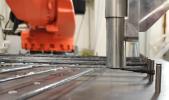
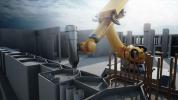

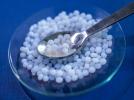
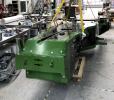
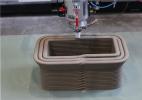
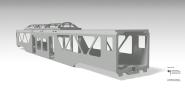
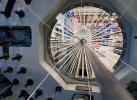
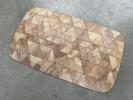
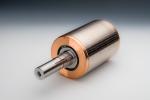
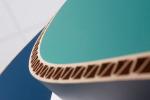
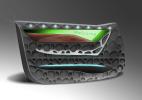

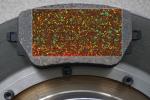
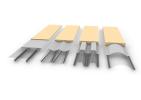
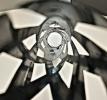
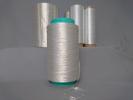
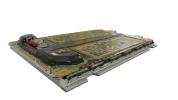
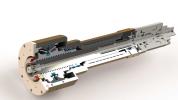

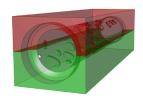

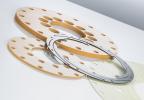

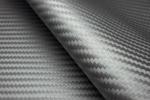
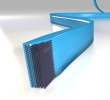
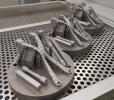

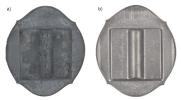
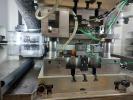

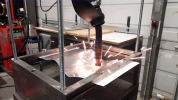




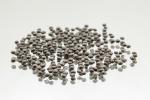

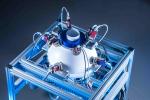

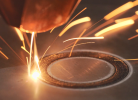


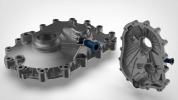


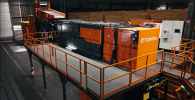
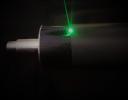



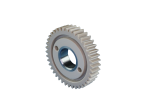

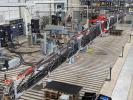


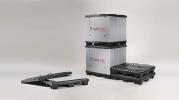

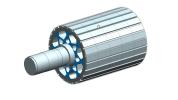

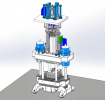
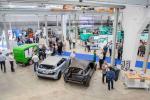




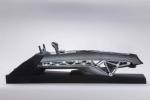


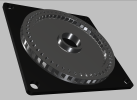

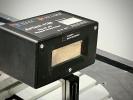
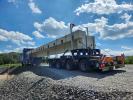
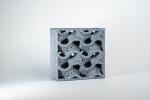


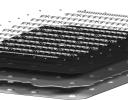

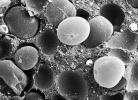





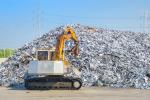
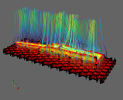

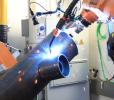
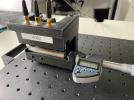
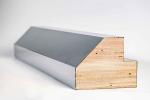
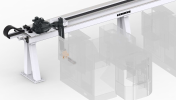




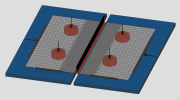



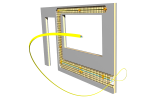

Using carbon fibres in concrete construction: Efficient reinforcement through automated production
Funding duration:
Start
01.10.21
End
31.05.24
The construction industry is responsible for a large proportion of global CO₂ emissions, particularly through the production of concrete. More material is often used than is actually necessary for the load-bearing capacity of a structure. Traditional steel reinforcements lead to high weight and increased resource utilisation.
In addition, these are still mainly assembled and installed manually. There has hardly been any digitalisation and automation of processes in the construction industry to date.
Lightweight construction technologies, such as the use of carbon fibres, offer a more environmentally friendly solution here. On the one hand, these materials are lighter, more efficient and more durable than conventional metallic reinforcements and therefore enable resource savings in concrete consumption. Secondly, the processes for reinforcement production are to be automated in future. This will enable the efficient and cost-effective production of carbon fibre reinforcements for concrete components.
In the 3DHyBeBe research project, the project team aims to develop an automated manufacturing solution that enables the precise and cost-effective use of carbon fibres as reinforcement in concrete construction. The key to the solution lies in combining construction robotics and efficient production. Through the targeted, robot-assisted placement of the fibres, the researchers want to increase the load-bearing capacity of the concrete components and simultaneously optimise the use of materials.
The results of the research project should reduce the consumption of resources and significantly improve the carbon footprint of concrete components. A key challenge here is to create a solution that is scalable and economically feasible so that it can represent a sustainable alternative to conventional steel reinforcement in concrete construction.
The research team is initially concentrating on developing an algorithm that determines the ideal course of the fibres depending on the structural requirements of the component. In this way, the carbon fibres are optimally designed to absorb tensile forces in the component. The researchers translate these calculations into control commands for a special production machine that enables the fibres to be precisely integrated into the concrete material. The prototype developed in the project includes a production line for the fibre reinforcement and an articulated arm robot for the automated implementation of the reinforcement structures.
The basis for reinforcement production is the optimised composition of the materials. The project team combines carbon fibres with various matrices to ensure the bond to the concrete. On the one hand, the researchers are investigating a cement-based matrix for use in conventional, cement-based concretes. Secondly, a geopolymer matrix - a synthetic material that offers many advantages in terms of processing and high resistance to chemical influences. The aim is to improve the transmission of forces between the reinforcement and concrete.
The demonstrative production of reinforcement structures shows that the method reduces material consumption by around a third, while at the same time ensuring technical and economic feasibility.

Producing CO₂-reduced concrete walls: 3D concrete printing robots
Funding duration:
Start
01.02.22
End
31.01.25
Processes in the construction industry have been little digitalised and automated to date. Standardised and inflexible processes often lead to inefficient use of materials, energy, time and labour. Resource-intensive concrete construction in particular causes considerable CO₂ emissions. Additive manufacturing of concrete offers a solution that allows for specifically dimensioned cross-sections and significantly simplifies logistics on construction sites. Automation, digitalisation and new material approaches are considered together.
In the 3DLight_OnSite project, researchers are developing an innovative concept for 3D concrete printing. The aim of the project partners is to use individually movable printing robots to produce structural-optimised concrete walls in CO₂-reduced lightweight construction, thus combining sustainability, construction robotics and efficient production. In order to make optimum use of the economic and ecological potential of concrete printing, they are relying on end-to-end digitalised and highly automated production.
The results of the research project should make it possible for mobile robot fleets to move flexibly around the construction site in future and print the concrete elements directly on site. In contrast to stationary printing systems, which are less flexible and less scalable, this will enable faster, more cost-effective and more environmentally friendly additive manufacturing.
The prototype developed by the project participants includes a crawler chassis and an industrial robot with a special nozzle head for the 3D printing process. The researchers are digitising the entire planning and production process in order to optimise the use of the robots. All relevant construction data is modelled digitally and transferred directly to the robots. Digitalised production methods also offer advantages beyond the construction process. For example, building materials can be tracked and components can be sustainably dismantled and reused in the sense of "urban mining".
The researchers are also focussing on material savings through a lightweight construction method inspired by nature. For example, CO₂-intensive, high-strength concretes are only to be used where they are structurally necessary. To this end, the project participants are using structures similar to honeycombs, which offer maximum stability with minimum material consumption. For example, the wall shell of a building is constructed from pressurised mortar and then filled with foam concrete, which serves as insulation and soundproofing. This construction method significantly reduces material consumption and CO₂ emissions. The project partners are also endeavouring to develop more environmentally friendly concrete mixtures.
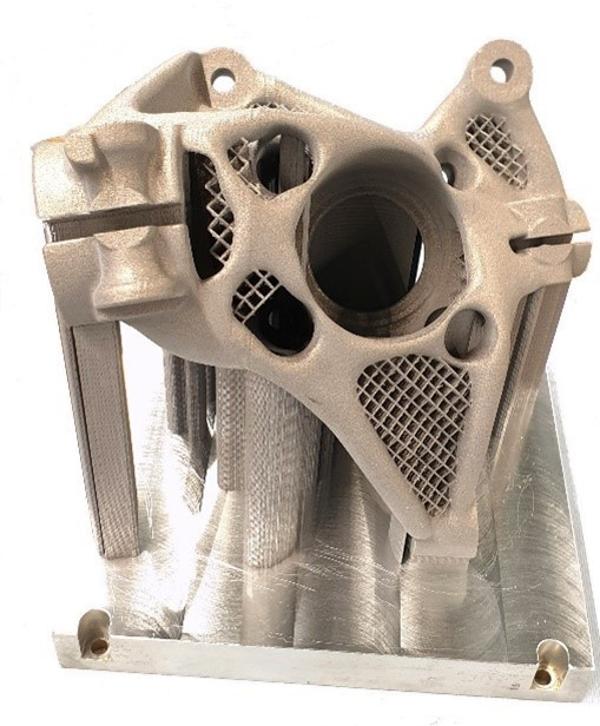
Realising innovative lightweight construction: powder bed-based melting of metal using lasers
Funding duration:
Start
01.03.21
End
29.02.24
Powder bed-based melting of metal using a laser beam (PBF-LB/M technology) builds up components layer by layer by melting metallic powder with pinpoint accuracy using a laser. In this way, elements with complex internal structures can be created that are light yet stable. Engineers use computer-aided design (CAD) to design these components. They often save the designs in STL format (Standard Triangle Language). STL files describe surfaces as small triangles.
This method works well for simple geometries, but quickly reaches its limits with complex, internally optimised structures, such as lattice or topology-optimised components. The file sizes become enormous and errors in the triangular mesh can impair the quality and simulation of the components. When modelling the melting process, classic, phenomenological models do not provide sufficient detail to capture the interactions between laser power, layer thickness, cooling rates and the resulting microstructure. Therefore, integrated simulation methods and data-based approaches are needed to better understand local material changes.
In the addLight research project, the project team aims to demonstrate the industrial use of additively manufactured lightweight structures. The researchers are developing components made from aluminium alloys that can withstand static, dynamic and cyclical loads. They are creating specific design rules for lattice structures and topology-optimised components, i.e. components that only use material where it is necessary for load-bearing capacity.
To do this, the project team combines physical models - which theoretically depict the PBF-LB/M process - with data-driven machine learning methods. These so-called grey box models link simulation and experimental data in order to predict local material properties and fatigue reactions almost in real time. In addition, the researchers describe process anomalies using data-driven models and compensate for them through local process adaptation. With the resulting reproducible manufacturing processes and precisely determined material parameters, the researchers hope to pave the way for the series production of safety-relevant lightweight components.
The partners also want to enable the efficient exchange of complex geometries such as lattice structures between different software components (CAD, simulation, data preparation) without any loss of information.
The researchers select components with high lightweight construction potential and pursue two development paths. On the one hand, they optimise lattice structures in which an inner mesh saves material, and on the other hand, they develop fully solid, topology-optimised components. They adapt the PBF-LB/M process by making local changes to the process parameters in order to achieve consistent surface quality and controlled microstructures. Modern monitoring systems record important parameters such as laser parameters, position data and melt pool radiation in parallel with the process. The researchers are developing methods that use this data to predict defects in the component and calculate local process adjustments to improve the homogeneity and reproducibility of the melting process.
The researchers also test the components using tensile, compressive and cyclic loads. The data obtained is incorporated into grey box models that combine physical simulations with data-based machine learning methods. Finally, the team uses computer-aided engineering (CAE) to validate the models and derive specific design guidelines for series production.
The researchers are investigating suitable geometry representations for lattice structures in order to derive an efficient file format. This will be proposed for standardisation in an industry consortium in order to enable interoperability between software products from different manufacturers.

Produce aerogels cost-effectively: Innovative system for lightweight concrete and plaster
Funding duration:
Start
01.04.21
End
31.12.24
In order to drive forward the energy transition and achieve the EU's climate protection targets, energy and resources must be saved. 75 per cent of all buildings in the EU are not energy-efficient by today's standards. At the same time, there is currently a lack of flexible, functional and cost-effective materials for thermal insulation in the construction sector.
Aerogels are porous solids in which the majority of the volume consists of pores. The fine structure of the aerogel firmly traps air molecules, resulting in a unique insulating effect. The nanopores in the aerogel restrict the heat-conducting air molecules so much in their freedom of movement that no energy is passed on to other air molecules. This turns the aerogel into a high-performance insulator with very low thermal conductivity, which leads to greater energy efficiency during the utilisation phase of the building or product fitted with it. The mineral insulating materials do not require any petroleum-based raw materials.
The project team is developing an innovative and sustainable system for insulating plaster and lightweight concrete that creates completely new possibilities. The aim is to develop a cost-effective manufacturing process for aerogels and new formulations. Aerogels are to be utilised in various applications in the field of thermal insulation systems, lightweight concrete and sandwich elements for façades and roof elements. The researchers are further developing the existing pilot plant for aerogels in order to transfer the process to an industrial scale, taking economic aspects into account, and thus make it economically competitive in the mass market for thermal insulation.
The researchers are investigating the entire value chain, from material selection and production to processes and system customisation. The centrepiece of the work is the expansion of the existing plant to include additional pump technology. In addition, separators are planned to enable the recovery of the individual fluids, in particular the solvent, in order to make the process more economical.
The result is a new type of production process for aerogels that combines various production steps. Manufacturing costs are reduced by half. Production is reduced from more than ten hours to just four hours and does not require any environmentally hazardous chemicals. The process has been successfully trialled on a small scale and the next step is to transfer it to an industrial scale.

Reducing the weight of agricultural machinery: lightweight, functionally integrated carbon chassis
Funding duration:
Start
01.06.21
End
31.05.25
The performance of agricultural harvesters has risen sharply in recent decades. At the same time, machines are getting bigger and heavier, which presents manufacturers with various challenges. On the one hand, the high weight leads to increased soil compaction, which worsens the living conditions for soil organisms and restricts root growth and water absorption. As a result, the fertility and yield of agricultural land decreases. On the other hand, the heavier and larger machines lead to problems in complying with road traffic regulations.
The AGRILIGHT team aims to significantly reduce the weight of the harvesters through the use of innovative lightweight construction concepts. They are developing a functionally integrated lightweight structure made of glass fibre and carbon fibre composites to replace the central steel frame of the machines and integrate adjacent components - such as tanks - into the component. This change is intended to reduce fuel consumption and CO₂ emissions while minimising soil compaction. In addition to the ecological improvement, the researchers would also like to simplify the road traffic authorisation of the machines thanks to the reduced weight.
To further reduce assembly times and costs, the team is developing new approaches to structural hybridisation for the particularly stressed interfaces of the machines. The aim is to be able to retain existing joining methods from metal processing for lightweight, fibre-reinforced materials.
At the start of the project, the team analysed the existing steel structure and the adjacent functional units of the harvester. It then developed the new functionally integrated frame structure made of fibre-reinforced plastics (GRP/CFRP), taking into account the specific mechanical, electrical and chemical properties of these materials.
For structural hybridisation, the team uses multi-layer insert technology, in which metallic inserts are integrated into the fibre composite during production. This means that existing joining methods from metal processing can be retained and downstream work steps such as drilling and gluing can be omitted, which significantly simplifies assembly.
At the end of the project, the new frame structure will undergo extensive mechanical testing to assess its suitability for series production. To do this, the team integrates the prototype into a realistic test setup and tests the frame on a special test bench to simulate real-life operating conditions. In this way, the team ensures that the new structure remains intact over the entire service life of the machine.
The developed prototype will be presented for the first time at Hannover Messe 2024 and shows a weight reduction of over 430 kg compared to the conventional steel frame construction. The project has been recognised as a finalist for the prestigious JEC Innovation Award in the Equipment Machinery & Heavy Industries category.

Finding optimal building materials: concrete construction with AI and 3D printing
Funding duration:
Start
01.06.22
End
31.05.25
The construction industry is one of the world's largest consumers of raw materials and energy and generates large amounts of waste. A large proportion of global greenhouse gas emissions are also generated during the construction, demolition and disposal of buildings. In particular, the production of concrete - one of the most frequently used building materials - with its main component cement causes considerable CO₂ emissions.
The aim of the scientists in the AIBetOn3D project is to reduce the environmental impact of the construction sector. To this end, they are asking themselves the overarching question of how 3D printing can be used in concrete construction to minimise CO₂ emissions without compromising the quality of the construction products.
On the one hand, the researchers are developing simulation models for 3D printers with the support of artificial intelligence (AI), which should help to identify optimal building materials and combinations of building materials by enabling reliable predictions of material behaviour and potential CO₂ savings. The researchers are also working on an innovative 3D printer for building materials and the associated software.
As a concrete application, the researchers are looking at drainage channels and inlet boxes, which are to be implemented in different variants - in 3D concrete printing, combined 3D printing with concrete and plastic moulds and clay-based 3D printing. In addition to geometric parameters, material modifications are also being investigated.
They are developing a concept for a semantically causally correlated material production library. The AI-based algorithms and models developed are thus designed to understand the meaning of the data, analyse their relationships and recognise and use the causal relationships to enable precise predictions and optimisations. The library will contain information on novel, additively manufactured building materials and serve as a learning system to perform optimisation in terms of component dimensions, material composition and CO₂ life cycle analysis. In addition, the researchers are testing the practical suitability of the developed printer and the associated software based on the specific use case.

Optimised carriage bodies for alternative drives: for climate-friendly trains
Funding duration:
Start
01.06.21
End
30.09.24
The transport sector is one of the biggest sources of CO₂ emissions. While electrified railway lines already offer climate-friendly alternatives to road transport, many secondary lines are still operated with diesel, as the necessary infrastructure, such as overhead lines, is lacking and often not economically feasible.
Although alternative drive systems such as batteries or fuel cells offer a low-emission solution, they bring with them new challenges: existing vehicle structures are not optimised for the integration of these technologies. Additional batteries or hydrogen tanks either require additional installation space, increase the weight or both. As a result, the structural mass of the vehicle increases or there is less space available for payload. Both have a negative effect on efficiency: The vehicle consumes more energy per kilometre - regardless of how much is actually being transported. Without targeted adaptation of the vehicle structures, the potential for weight reduction and the advantages of lightweight construction remain largely unutilised. Targeted optimisation and lightweight construction approaches can reduce the weight or increase the installation space. This is where the AnoWaAS project comes in.
The project team aims to develop a new generation of car bodies for rail vehicles with battery and fuel cell drives that are optimised to meet the requirements of alternative drives. Instead of simply adapting existing structures, the researchers are focusing on a complete redesign: a modular lightweight wagon body is to optimise installation space and load distribution in such a way that alternative drives and their integration into the vehicle structure can be integrated. The aim is to reduce weight, increase energy efficiency and at the same time ensure cost neutrality compared to conventional designs.
In addition to rail transport, synergies with the commercial vehicle sector are to be exploited in order to transfer the concept to other mobility applications. Sustainability plays a central role: the wagon body should be designed to conserve resources, be made from recyclable materials and be designed for a long service life. The researchers are focusing on innovative joining techniques that minimise the use of materials and production costs.
The team is looking at the entire development chain. Firstly, it is investigating various packaging approaches for battery and hydrogen systems and analysing how energy storage systems can be optimally integrated into the support structure in order to use installation space efficiently and distribute the vehicle mass evenly. To this end, the researchers are analysing theoretical topology optimisations and transferring them into practical designs in order to demonstrate the potential.
At the same time, they are developing a new type of vehicle body concept: instead of exclusively using conventional extruded aluminium profiles, lighter sandwich materials and adapted construction methods are used in accordance with the identified loads. This combines structural strength with low weight. They then validate the theoretical considerations in a complete vehicle that is ready for production and approval. Using modern joining methods such as friction stir welding, they enable a stable and at the same time material-efficient design. One focus is on the development of structural interfaces between drive components and the vehicle body.
At the end of the project, the researchers will develop a prototype that demonstrates the potential of the new construction methods. With an ecological and economic assessment, they will ensure that the solutions developed are also sustainable and economically viable in practice.

Antistatic pipes for aviation: composite materials replace metal
Funding duration:
Start
01.06.21
End
30.06.24
In aviation, pipework systems for fuel, hydraulics and ventilation are essential. Currently, they are mostly made of metal, which leads to high weight and limited design freedom. Composite materials offer great potential here: they are lighter, corrosion-resistant and allow greater design freedom.
However, they do not yet fulfil all requirements, particularly with regard to electrical conductivity and the economical production of complex pipe geometries. Previous solutions have reached their limits when it comes to combining functionality, safety and efficiency. This is where the AntiStatic research project comes in and searches for a new technological solution.
The project team wants to develop antistatic cable systems made of composite materials that can replace conventional metal pipes. The innovation lies in the combination of low weight, high mechanical stability and electrical conductivity. The pipes are to include both straight and curved sections and fulfil specific requirements of the aviation industry.
The focus is on resource-saving production and a modular design of the piping system. By using this technology, weight savings of up to 50 per cent could be achieved, thereby significantly reducing CO₂ emissions in aviation.
The project team has combined the manufacturing processes of braided pultrusion and braided RTM (resin transfer moulding). Braid pultrusion is used to produce straight tubes that are particularly stable and lightweight thanks to continuous production. The braided RTM process is used for bent pipe sections, which allows the production of complex geometries.
The researchers have also developed a resin system that is filled with carbon nanotubes (CNT). This gives the components their antistatic properties without compromising their mechanical characteristics. The team then joined the individual tube segments together using a modular joining process. The researchers are now using a demonstrator to prove the practicality and efficiency of the developed technology.

Automated production of sandwich components: Robots increase efficiency and sustainability
Funding duration:
Start
01.01.22
End
31.12.24
Composite sandwich structures are components made up of several materials with different properties. The combination of a strong inner layer, a lightweight support material and an outer layer makes them stronger than the individual materials and offers high strength with low weight.
Until now, however, the production of these sandwich structures has been complex and required a lot of manual work, which is why the sandwich construction method is mainly used for prototypes and small series. In order to expand the use of composite sandwich structures to other areas of application, the production of the components must be more automated.
In the APART project, the project partners are developing a fully automated production system for high-strength and lightweight sandwich components. A special feature of the system is the use of renewable raw materials such as cherry trees or sisal for the support layer. In this way, the team aims to create a CO₂-reducing, sustainable process that is suitable for the series production of composite sandwich structures.
In addition to significantly shortening the production time of the components, automation should also increase production quality and reduce waste. This not only increases efficiency in production, but also promotes lightweight construction in areas where the sandwich construction method could not previously be used due to the high manual effort involved.
The researchers are developing a robotic system that automates several steps in sandwich production, including cutting, feeding and placing the bio-chips for the support layer. The bio-chips are produced in different shapes and sizes, for example from balsa, kiri wood or sisal fibers in combination with a bio-glue. A four-axis gantry system, equipped with sensors for image processing and ultrasound technology, takes over the precise placement of the bio-chips. The gantry system detects inhomogeneous biochips and sorts out faulty pieces to optimize quality and strength.
In order to test the practical suitability of the system, the project partners are testing the technology in the application fields of vacuum and hot pressing and are incorporating the results into the fine-tuning of the process. By optimizing the production steps in this way, they are developing a technology that is suitable for series production.

Efficient production of electric motors: with copper die casting and 3D printing
Funding duration:
Start
01.11.21
End
31.12.24
Electric vehicles face the challenge of being as energy-efficient, resource-saving and powerful as possible. Drive technology is particularly challenging in this respect. Until now, machines with permanent magnets have dominated - but their dependence on rare earths is problematic both ecologically and geopolitically. Asynchronous machines (ASM) are considered a robust and cost-effective alternative, but they quickly reach their technical limits at high speeds. At the same time, the demands on performance and resource efficiency are increasing. This is precisely where the ATREA project comes in. The aim is to make electric drives fit for the future - with new design approaches and modern production technologies.
The researchers want to further develop asynchronous machines for use in high-speed drives - for example in electric cars - and thus realise the full potential for electromobility in an ecologically sensible way. To do this, they are combining two key technologies. Firstly, additive manufacturing of mechanically resilient 3D support structures. Secondly, copper die-casting for rotor rotors - the rotating part of the electric motor in which the electricity is generated for movement. This combination should lead to a new generation of lightweight, efficient and sustainable electric motors. The focus is not only on increasing the power density - i.e. more power with less mass - but also on reducing material costs and dispensing with critical raw materials such as rare earths. The project team wants to show that asynchronous machines with copper rotors are an alternative to today's standard drives. By combining innovative materials, customised designs and new production methods, the researchers are aiming for a solution that is ready for series production.
On the one hand, the researchers are reinforcing the areas of the asynchronous machine that are subject to particular mechanical stress - such as the rotor rings - with additively manufactured structures. These structures not only have to withstand high centrifugal forces at speeds of over 21,000 revolutions per minute, but also have to be optimised electromagnetically and thermally. They are also continuing to develop the copper die-casting process so that it can be precisely combined with additive components. The focus here is on the optimum mould design, the behaviour of the material during solidification and the process-related requirements. The team is trialling various material combinations in numerous tests and evaluating them with the help of simulations. The results are incorporated into optimised designs and innovative manufacturing processes.

Sustainable wood fibre sandwich: industrial production and cross-sector use
Funding duration:
Start
01.11.20
End
31.01.23
The team in the BENHoLei research project has set itself the goal of developing sustainable lightweight construction elements made from wood fibre materials across all sectors. The basis was the wood fibre material Homawave, which is characterised by its wave-like structure that is reminiscent of corrugated cardboard. This structure is produced by a continuous forming process in which wood fibre boards are corrugated and then combined with cover layers such as aluminium or high-density fibreboard. The result is stable sandwich materials that are more resource-efficient and considerably lighter than conventional wood-based materials. BENHoLei has shown that these materials can be used in a variety of ways, for example in furniture, vehicle parts or the packaging industry, and can make an important contribution to reducing CO₂ emissions by reducing material consumption and weight.
The aim of the researchers is to optimise wood fibre materials for large-scale production and thus enable more sustainable and environmentally friendly industrial processes. To this end, they are developing automated production processes that integrate mechanical testing and non-destructive testing methods. The focus is on improving material properties, such as flexural strength and dimensional stability, through hybrid combinations of cover and core materials. In addition to technical development, the project team is pursuing the goal of transferring the research results directly into practical applications. The use of Homawave in the furniture and automotive industries as well as in ship interiors should create both ecological and economic benefits such as lower material consumption, lower transport costs and a sustainable value chain.
The researchers successfully complete the material and process development. They further develop the Homawave core in combination with various cover layers and subject it to extensive mechanical tests. In particular, the successful tests with acrylate and phenolic resin systems lead to a higher forming quality and improved surface quality. At the same time, the team develops new roller geometries and optimises the production processes, for example through more precise temperature and humidity settings, thereby increasing the production speed to up to 5 metres per minute. They integrate non-destructive testing methods into the process chain to ensure quality and detect defects at an early stage.
The sandwich materials developed in the project are tested for their practical suitability using a lectern as a demonstrator. The positive response, for example at the INTERZUM 2023 trade fair for suppliers to the furniture and interior design industry, confirms the market relevance of the materials. Finally, the scientists are developing a concept for a production plant suitable for large-scale production that fulfils both economic and ecological requirements.

Making the process chain for lightweight products more sustainable: based on bionics and AI
Funding duration:
Start
01.07.21
End
30.06.24
Lightweight construction is a key technology for curbing global warming and increasing economic performance at the same time. In the mobility sector in particular, companies can save material and therefore resources thanks to lightweight construction. At the same time, lightweight vehicles emit less CO₂ during operation. However, the manufacturing and recycling processes for vehicles are often emission-intensive. There is a lack of holistic solutions that make products more sustainable over their entire life cycle and optimise them along the vertical and horizontal process chain.
The project partners want to make the entire process chain for lightweight products more sustainable and increase resource efficiency across the entire life cycle. To this end, they are optimising the CO₂ footprint and the use of resources in the manufacturing process. The researchers are working on new development concepts in order to be able to take these aspects into account during the planning and design of individual components or complex building structures. They use methods of automation, artificial intelligence (AI) and bionics, i.e. the transfer of natural phenomena and principles to technology, as the basis for new algorithms and assistance services.
The researchers are supplementing established processes such as the computer-aided design of components (CAD designs) with additional elements. To this end, they are developing design algorithms inspired by biology. AI-based assistance services should take into account and integrate the downstream life phases as early as the product creation stage and predict simulation results. The project team is developing a semi-automated design process that enables products to be adapted and optimised quickly without having to carry out extensive new development. This not only saves time, but is also sustainable. This is because manufacturing processes and materials that are only economical and sustainable in the introductory phase of a product, for example, can be replaced quickly and easily in later phases of the product life cycle.
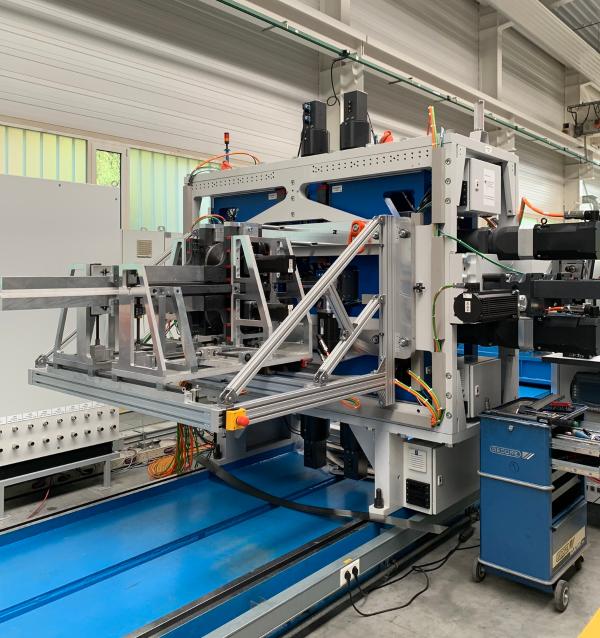
Stable and light: producing bionic lightweight structures based on branched sheet metal
Funding duration:
Start
01.04.21
End
31.12.24
Sheet metal and profile structures play a central role in many industrial applications - especially in vehicle and mechanical engineering. However, their load-bearing capacity is limited. Under load, the thin-walled profiles often deform in an uncontrolled manner - they buckle or bulge. To avoid such instabilities, reinforced cross-sections have been used up to now. However, these increase material consumption and weight - a contradiction to the goals of resource-efficient lightweight construction.
New design approaches are therefore needed that enable sufficient stability without additional material. One promising approach can be found in nature: biological structures utilise branching to increase rigidity and load-bearing capacity. These bionic principles can be transferred to technical applications and open up new potential for lightweight construction.
While such branched structures can already be implemented with materials such as aluminium, their realisation with thin-walled steel has so far posed major challenges for the industry. This is where the BioStruX project comes in: The aim is to make structurally effective branching usable for steel profiles and to be able to produce them economically and flexibly.
The BioStruX project team is working on further developing the forming production process of gap profiling with subsequent upright bending so that it can be used on an industrial scale. With the help of this technology, the researchers want to produce sheet metal profiles directly and flexibly from steel for the first time, based on a bionic model. The branched shape makes these new profiles significantly more stable - with the same weight. In addition, the forming process increases the strength and hardness compared to the original raw material. This enables companies to produce sheet metal with tight bending radii and low springback. Slit profile bending produces particularly robust components that can withstand high loads.
To achieve this goal, the scientists are designing a fully digitalised, automated and flexible process chain. Their aim is not only to simplify production, but also to open up new applications in sectors such as commercial vehicle construction, rail transport and logistics. In the long term, they want to develop the technology to such an extent that it can be used economically in series production.
The project team is designing a new type of gap profiling system that integrates all forming steps into a single, flexible forming stand. Instead of classic, multi-stage rolling processes, the researchers are focussing on a single-stage process with a reversing feed mechanism. This feeds the sheet metal through the same forming stand several times with customised infeeds, enabling the flexible production of complex profiles.
The scientists are focussing in particular on the development of an intelligent process control system. Using comprehensive sensor technology, they record the process status and continuously optimise it during operation. This reduces the time required to set up the system when changing products. In addition, the forming stand automatically adapts to different materials and geometries.
The team is also developing a new bending process that allows customised curvatures to be integrated directly into the profiles. The partners are combining both sub-processes - gap profiling and gap profile bending - in an AI-supported overall system. Using demonstrators and industry-specific application scenarios, the researchers are testing the practical suitability of the technology.

Sustainable braking system: reducing particulate matter and enabling circularity
Funding duration:
Start
01.09.21
Today
26.06.25
End
30.06.25
Urban road traffic releases large amounts of particulate matter, which can pose significant health risks. Around half of the particulate matter is caused by brake abrasion – regardless of the drive system of the vehicle. Due to their small size, about 90 percent of these particles enter deep into the respiratory tract and can cause serious damage.
The main problem lies in the braking systems currently in use: these are mostly made of gray cast iron alloys and matching brake linings. During braking, the materials wear down and the released particles enter the air. There are currently no alternatives to traditional braking materials for the series production market.
The project team aims to develop a cost-effective, low-wear, low-emission and recyclable braking system for industrial production. To this end, the researchers are using brake discs made of highly hard-material particle-reinforced aluminum matrix composites (AMC, short for: aluminum matrix composites). AMC brake discs are almost wear-free in combination with suitable brake pads, so that hardly any particulate matter is produced. This significantly improves air quality, especially in cities and at traffic junctions.
In addition, AMC braking systems are lightweight constructions, which in turn reduces CO₂ emissions while driving. Unlike conventional gray cast iron brake discs, AMC brake discs are also recyclable and reusable.
One of the biggest challenges for the use of AMC brake systems is the development of suitable brake pads. These must be designed in such a way that a so-called tribofilm forms during braking. This is created by chemical reactions and acts like a protective layer that prevents wear and the formation of fine dust.
In order to develop suitable brake pads, the project team is therefore analysing the surface structure of the materials using electron and 3D scanning microscopes. Conventional brake pads consist of up to 30 individual components.
The team is optimising these parts, particularly with regard to friction coefficient, durability and noise development. The researchers are also replacing questionable materials, such as copper alloys, with more environmentally friendly alternatives that also support the formation of the tribofilm.

Replacing heavy concrete ceilings: prefabricated ceiling elements made of carbon concrete
Funding duration:
Start
01.03.23
Today
26.06.25
End
28.02.26
Concrete is the most widely used building material in the world. Large quantities of greenhouse gases are emitted, particularly during the production of cement, which forms the basis for the manufacture of concrete. Cement production is responsible for around 8 per cent of global CO₂ emissions. It is therefore crucial for the transformation of the construction sector to reduce cement consumption in particular. One option is to gradually replace steel with pre-stressed carbon fibre reinforcement. This leads to an increase in material and energy efficiency, as it creates lean, mass-reduced and therefore resource-saving structures. A particularly interesting area of application is the use of carbon concrete in the area of floor slabs, for which large quantities of reinforced concrete are used in conventional construction methods.
The project partners want to replace the 30 cm thick concrete ceilings usually used in solid construction with lightweight, non-corrosive load-bearing structures. To do this, they are using concrete elements pre-stressed with carbon, the cross-section of which they are reducing to a maximum of 10 cm. The researchers are focussing on prefabricated ceiling elements. These are particularly sustainable, as less waste is produced during manufacture, they are easier to dismantle and can be reused more easily. The carbon pre-stressed ceiling systems should fulfil all structural, fire, thermal and sound insulation requirements and at the same time be practicable.
These sustainable ceilings are developed and tested using a multidisciplinary approach. This includes developing the manufacturing methods, including the plant technology, as well as forecasting and validating the quality of the ceilings. In a comprehensive test programme, the carbon concrete components are tested for their load-bearing and deformation behaviour under short and long-term effects. This includes airborne and impact sound insulation as well as fire protection. The test results are used to validate the numerical calculation models that are used in all disciplines and with which the various parameters are optimised as a whole. The dimensioning of the component cross-sections, including the fasteners and supports, is carried out in accordance with applicable standards as part of the structural analyses. In addition to the small-scale tests, real-scale models are built and tested.

Saving resources in concrete construction: new concepts for large-format carbon fibre reinforcement
Funding duration:
Start
01.11.20
End
30.04.24
Concrete is currently the most widely used building material in the world. However, its production causes high greenhouse gas (GHG) emissions. To increase the load-bearing capacity of concrete components, so-called reinforcement is inserted into the concrete. This usually consists of steel mats, rods or mesh, which require a thick concrete cover due to their susceptibility to corrosion and therefore cause high GHG emissions.
Carbon fibres, on the other hand, are six times more effective than steel and are not susceptible to corrosion. The use of carbon fibres instead of steel can therefore significantly reduce the amount of reinforcement and concrete required. However, different load cases have so far been considered separately when designing steel and carbon fibre reinforcement. This can lead to over-reinforcement and thus to an increased use of resources.
The project partners want to develop innovative, large-format carbon reinforcements for concrete construction and optimise them for industrial application. These carbon structures should be force-flow-compatible and particularly durable, resulting in resource-saving concrete components. To achieve this, they want to combine design and construction principles from lightweight construction with those of conventional concrete construction. This would also reduce GHG emissions during production and release them into the environment. The project partners anticipate a GHG savings potential of 86 per cent in the area of building construction compared to conventional reinforced concrete construction.
The team no longer installs individual reinforcements for the different load cases, but an optimised and self-contained reinforcement structure. As a result, three-dimensional structures can be created that optimally adapt to the flow of forces and are therefore highly effective and resource-saving. The reinforcements can then be cast with a lower concrete cover. This allows significant material savings to be made on both the concrete and the reinforcement.
Thanks to its cross-technology composition, the team can cover the entire value chain. The researchers are optimising the geometry and mechanical properties of the new type of reinforcement structure and adapting the production process accordingly. They are developing a process for the production of impregnated and wrapped fibre strands that enables a very high utilisation of the fibre tensile strength in the strands by optimising the alignment of the individual fibres. The mechanical properties of the reinforcement within concrete components can also be optimally utilised by optimising the strand arrangement within the reinforcement cages on a test basis.

Bio-based and recyclable: using cellulose as a lightweight construction material
Funding duration:
Start
01.01.22
Today
26.06.25
End
30.06.25
Fibre-reinforced plastics are key materials in lightweight construction. They combine high mechanical stability with low weight and are used in vehicle components, structural elements and housings, for example. However, the majority of these composite materials are based on fossil raw materials - in particular on petroleum-based plastic matrix systems such as epoxy resins or polyamides. The common reinforcing fibres, such as glass or carbon fibres, are also energy-intensive to produce and difficult to recycle. The recycling of these composite materials often fails because the matrix and fibres can hardly be separated from each other by type.
At the same time, bio-based materials such as those based on cellulose, the main component of plant cell walls, are gaining in importance. Individual developments show that cellulose can be suitable both as a matrix and as a fibre for the composite. However, comprehensive solutions for fully bio-based, mechanically resilient and industrially processable composite materials with a functioning recycling concept are still lacking.
The CELLUN research project aims to develop a new type of fibre composite material based entirely on cellulose. The researchers are combining high-performance cellulose fibres with a thermoplastic cellulose derivative matrix - specifically cellulose acetate propionate (CAP). Thanks to the same material base, the fibres and matrix can be ideally matched to each other. This avoids weak points at the interface. A thermoplastic material is being developed, i.e. a material that can be moulded with relatively low energy input and offers good conditions for recycling. The aim of the project team is to create a high-performance, bio-based and recyclable material for industrial applications in lightweight construction.
CELLUN aims to close the gap between ecological sustainability and technical requirements. The material should be able to be processed in common manufacturing processes such as pultrusion, FIM or compression moulding and at the same time enable single-origin recycling - through chemical recovery of the cellulose and cellulose derivative matrix.
Firstly, the project team develops suitable material components. To do this, the researchers select cellulose fibres, chemically modify their surface and match them specifically to the cellulose acetate propionate matrix. In the next step, the components are further processed into hybrid textiles using processes such as commingling and weaving, from which fibre composites are created using pultrusion, hot pressing or FIM. Here, particular attention is paid to the adhesion between fibre and matrix - a decisive factor for mechanical resilience.
The researchers test properties such as strength, formability, thermal stability and flow behaviour in the various manufacturing processes. At the same time, they are developing methods for recycling the material. The scientists are investigating how offcuts and discarded components can be mechanically shredded and chemically broken down into their starting materials. In pilot tests, they are producing the first demonstrators with application-orientated geometries for various industrial products.

Optimising battery housings for e-cars: with aluminium foam and more efficient production
Funding duration:
Start
01.05.21
End
31.10.24
Electric cars can help to reduce greenhouse gas emissions in the transport sector and protect the climate. The battery system is the centrepiece of modern electric cars and a central component for sustainable mobility. With innovative design principles, materials and production processes, lightweight construction can help to make battery systems lighter, optimise their properties in use and make their production more efficient.
The aim of the COOLBat research project is to increase the range of electric cars by reducing the weight of the battery housing. At the same time, the researchers want to improve the performance of the batteries and enable faster charging times. In addition, the project team is investigating how the production of battery housings can be made significantly more efficient using lightweight construction approaches in order to reduce CO₂ emissions during production.
The battery system of an electric car being analysed serves as a reference and demonstrator for the researchers. The research results will then serve as a blueprint for the development, optimisation and scaling of specific lightweight materials and technologies for other industries and applications, such as trains, aircraft and ships or food and medical transport.
The researchers are scrutinising all development steps to see how they can contribute to CO₂ savings and sequestration. To do this, they look at the entire battery system. In addition to the battery module with its cells, this includes the housing with structures for load distribution and temperature control. These include frames, covers and base plates, which protect the batteries from overheating and damage.
The team combines individual systems in order to integrate more functions in a smaller space and with fewer interfaces. In future, support structures will contain directly moulded-in temperature control channels. In the floor panels, for example, the function of the cooling unit will be combined with that of crash protection in a single component.
The use of aluminium foam enables optimum load distribution and energy absorption in the event of an accident. The foam is combined with a so-called phase change material that can store heat and cold energy and release it again as required. This combination of materials also reduces the amount of energy required to cool the battery. The cover of the battery housing is designed in such a way that the housing can optimally absorb the loads acting on it. In addition, the participants are developing new heat-conducting materials to replace more expensive and environmentally harmful heat-conducting pastes. The lightweight construction solutions used should save 15 per cent CO₂ per battery housing.

Reducing the CO₂ footprint of cars: hybrid components made of aluminium and steel
Funding duration:
Start
01.03.21
End
31.08.24
Road traffic in Germany causes around 160 million tonnes of CO₂ every year and is therefore responsible for around 20 percent of the country's total CO₂ emissions. One effective method of reducing the CO₂ emissions caused by cars is to reduce vehicle weight through functional lightweight construction. Three technologies in particular are currently being used for this purpose: High-strength aluminium alloys, aluminium-steel mixed construction and Tailor Welded Blanks (TWB) - welded body parts made of steel sheets with different strengths and thicknesses.
The researchers in the CO₂-HyChain project aim to combine these technologies in order to further reduce vehicle weight. In particular, high-strength aluminium TWBs and hybrid aluminium-steel TWBs are to be used. By using aluminium and steel together, the participants want to combine the positive properties of the two materials - in particular the high strength of steel and the low weight of aluminium.
The project partners want to transfer the solutions researched on a laboratory scale to industrial production through technology transfer and further develop the entire value chain. The introduction of these technologies should reduce the CO₂ footprint of passenger cars by up to 15 per cent.
The researchers are developing new welding methods and heat treatment techniques to economically produce high-strength aluminium-steel joints with different sheet thicknesses. They also want to significantly improve the mechanical properties and durability of the weld seams, which will significantly expand the industrial applications of high-strength aluminium and hybrid aluminium-steel TWB.
In order to integrate these technologies into existing production processes and make production more economically and ecologically sustainable, the project partners are developing highly efficient production systems for the manufacture of large-format aluminium-steel TWB and tailor-welded coils (TWC) - coils made from metal strips of different materials or thicknesses. They develop control and regulation concepts to enable reliable process control and ensure sufficient quality of the TWB and TWC. They also focus on the development and implementation of new recycling concepts in order to further maximise resource efficiency.
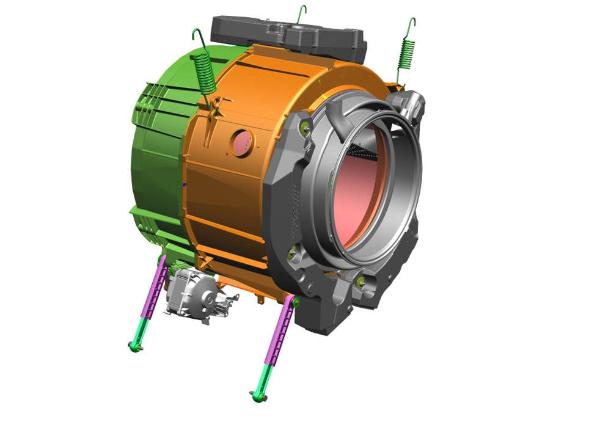
Producing washing machines more sustainably: Material recycling and digital simulation
Funding duration:
Start
01.01.22
End
31.12.24
The drums of washing machines spin in almost every German household. It is therefore important that the appliances are not only as energy-efficient as possible in use, but also in their production. This is where the researchers in the DigiLaugBeh project come in, using digital simulations to transfer innovative lightweight construction solutions from automotive engineering to the washing machine application. The lye containers are manufactured using an injection moulding process. A machine plasticises the plastic used - short fibre-reinforced thermoplastic - and injects the softened material into shape under pressure.
The project partners want to use the lye container that surrounds the washing drum to show how great the potential is to save CO₂ and recycle materials. To do this, they are using innovative lightweight construction solutions. The researchers are creating a digital twin in order to visualise the entire product development chain, simulate the entire component design and take a holistic view of the process, material and environmental balance. Ultimately, the project team wants to produce a demonstrator that combines all the knowledge gained and thus enables the transition to serial production of the innovative lye container.
The project partners are using digital simulations to optimise the entire manufacturing process. For example, they want to use long glass fibres instead of the short fibre-reinforced material. They are also replacing conventional injection moulding with thermoplastic foam injection moulding. In this process, the molten plastic is charged with carbon dioxide or nitrogen and then foamed. This protects the fibres and reduces the risk of component distortion.
The approaches used are analysed for their life cycle right from the start. The researchers assess the respective CO₂ footprint and optimise it. They also aim to replace around 50 per cent of the materials used with recycled materials, for example by recycling returns at the end of their service life.
The researchers assume that this will save 30 to 40 per cent of CO₂ equivalents per kilogramme of material used. The lye container weighs around 4 kilograms. With 8 million parts produced annually, replacing half of the materials used with recycled material would save 19 to 25 thousand tonnes of CO₂ equivalents per year.

Efficient design of fibre composites: digital model for tailored fibre placement
Funding duration:
Start
17.05.22
End
31.07.24
Fibre-reinforced plastics enable lighter and more efficient components. They play a key role in the mobility and industry of the future. Tailored fibre placement (TFP) in particular offers great potential: it enables the precise placement of reinforcing fibres along the main stresses in the component. This results in highly resilient structures with minimal use of material.
However, the industrial application is complex. The development of a TFP component requires many iterations, as design, production and mechanical properties are closely interlinked. Small and medium-sized enterprises (SMEs) in particular face challenges: High development costs and a lack of digital tools make it difficult to access the technology. This is where the DigiPEP research project comes in, developing a digital solution that fundamentally simplifies the development process.
The aim of DigiPEP is to create a holistic, digital development process for TFP components. To achieve this, the project team is linking the individual steps from component design and production through to cost and sustainability assessment. The aim is to create an efficient, automated and user-friendly solution.
The researchers want to link all relevant design steps in a Model-Based Systems Engineering (MBSE) approach. In this way, they want to optimise structural, manufacturing and economic aspects in parallel. The model takes into account mechanical loads, fibre orientation in the embroidery pattern, draping influences and failure mechanisms. This significantly reduces the iterative development effort.
The digital model should enable optimum material utilisation, reduce waste and thus lower costs. An integrated life cycle assessment should enable companies to make sustainable decisions in the early planning phase.
The researchers are initially developing sub-models for structural analysis, stick-path design, drape simulation and failure assessment. Mechanical tests on material samples provide precise data for modelling the material properties. The team also analyses the placement and draping behaviour of different fibre types under varying production parameters. This experimental data is incorporated into an AI-supported draping model that realistically depicts fibre displacement during forming. Finally, the researchers bring together all the sub-models in a networked system environment.
The project team tests and validates the model using a demonstrator component from the manufacturing industry. The results flow directly into the software development. In this way, the researchers aim to provide a practical software solution that enables the economical and load-path-compliant design of TFP components.

Producing modular, recyclable components: Lightweight structures made of composite plastic
Funding duration:
Start
01.10.23
Today
26.06.25
End
30.09.26
In view of increasing climate and environmental pollution as well as EU-wide climate protection initiatives and national CO₂ reduction targets, the need for recyclable, resource-saving lightweight construction solutions is increasing across all industries. While large structures in the mobility and energy sectors - for example in the construction of vehicles or wind turbines - have primarily used steel and aluminium to date, new material approaches are needed to meet the new requirements for sustainability and recyclability. Fibre-reinforced plastics (FRP) offer a resource-saving alternative here. However, conventional thermoset FRPs, i.e. fibre-reinforced plastics that take on a permanent and unchangeable shape after hardening, are difficult to recycle and make repairs and dismantling more difficult. Thermoplastic fibre-reinforced composites, which can be melted and welded, offer a solution that enables greater recyclability and more flexible use.
The central aim of the DOM4Composites project is to develop large, modular structures made of thermoplastic FRP for the mobility and energy sectors. The innovative lightweight structures are to be used in ships, rail and commercial vehicles and wind turbines, for example. The scientists want to set technological standards for more environmentally friendly production of large structures.
The researchers are already considering a disassembly-optimised design at the design stage in order to be able to recycle the materials better and increase material and energy efficiency. Thanks to the modular design, they also want to simplify the repair of individual modules, which can increase the service life of entire assemblies. Thanks to the innovative design, materials could be reused several times, the weight of the structures could be significantly reduced and CO₂ could be saved during production and utilisation.
The team develops scalable manufacturing processes for thermoplastic FRP. They use innovative joining and disassembly concepts to enable modular construction and subsequent recycling of the components. To this end, the researchers first define comprehensive requirements for mechanical and thermal loads as well as quality criteria for the materials for various applications.
A particular focus of the scientists is on the development of recurring substructures that allow the efficient and economical realisation of modular lightweight structures. To this end, they adapt the materials for their suitability in comprehensive material tests. To join the components, the team uses various joining techniques such as adhesive bonding, resistance welding and hybrid joining to ensure recyclability and ease of repair.
The project partners are testing the approaches developed on two cross-sector prototypes, a ship's hatch cover and the side wall of a railway vehicle body. With an accompanying life cycle analysis, the team is evaluating the ecological impact of the entire process chain in order to further optimise the environmental balance and demonstrate the potential of sustainable lightweight structures in practice.

More durable components: Hybridisation makes fibre composite plastics more resilient
Funding duration:
Start
01.01.21
End
30.06.23
Fibre-reinforced plastics (FRP) have established themselves as key materials in lightweight construction as they offer many advantages for various applications thanks to their mechanical properties and low specific weight. They are replacing metallic materials, particularly in the mobility and mechanical engineering sectors, where components have to withstand high dynamic loads. However, conventional FRP materials reach their limits when it comes to fatigue strength and service life. Material fatigue under dynamic loads often leads to shortened life cycles and increased failure rates, resulting in higher costs and a larger CO₂ footprint. To counteract this, the hybridisation of FRP is being investigated: The combination of different fibre types in one material makes it possible to specifically improve the properties. However, to date there has been a lack of standardised semi-finished products and application-ready methods - this is where the DurableHybrid research project comes in.
The project team has set itself the goal of increasing the fatigue strength of dynamically loaded FRP components by 30 percent through hybridisation. Hybridisation is intended to improve the material properties without increasing the weight. These improvements should help to significantly reduce the carbon footprint of the components, as more durable materials need to be replaced less frequently, thereby reducing material consumption and emissions. The focus is on components subject to bending loads, such as leaf springs, which are used in numerous industries. In the long term, the scientists are aiming to provide standardised semi-finished products for hybrid FRPs. In this way, they want to enable companies to produce more durable and resource-efficient components cost-effectively.
The project team combines experimental research and simulation to develop hybrid FRPs. First, the researchers are investigating how different types of fibres can be combined in one material in order to achieve optimum material properties. They carry out tests to show how loads affect fatigue strength. At the same time, they are developing digital simulation models that precisely map the properties of the hybrid materials and facilitate the design process. The team uses the knowledge gained in this way to produce leaf spring prototypes and test them in real applications. The results are incorporated into a digital modular system that is intended to provide standardised recommendations for the use of hybrid materials in design.

Developing natural fibre-reinforced plastic components: with innovative 3D printing
Funding duration:
Start
01.05.21
End
30.04.24
Land vehicles consist of large and heavy components that are difficult to recycle. To make them lighter and more sustainable, lightweight, natural fibre-reinforced plastic components could replace the metal structures used today. These renewable raw materials are not only sustainable, but also have a lower density, better acoustic and mechanical damping and are biodegradable. Above all, their production consumes less energy and therefore emits significantly less CO₂. Natural fibre-reinforced plastics are therefore particularly attractive for lightweight construction in mobile applications.
The project team wants to develop the new lightweight components for a wide range of industries and applications: special vehicle seats - for example a lightweight seat for use in electric vehicles and special vehicles - tractor crossovers or attachments for pick-ups. The researchers are pursuing a holistic approach. They not only want to make the components lighter with environmentally friendly materials, but also consider the entire life cycle: how can the utilisation cycle of the components, from material selection and production to use and recycling, become more sustainable?
The researchers use the high-speed additive process SEAM (Screw Extrusion Additive Manufacturing). This innovative 3D printing process is eight times faster than conventional 3D printing. Thanks to the free shaping, even complex parts can be created. In addition, several conventionally manufactured individual components can be replaced by one additively manufactured part. The advantages: Digitalisation ensures shorter process chains and therefore faster production, the use of materials is as low as possible and manufacturers can produce many different individual pieces cost-effectively.
The team also uses natural fibre-reinforced plastics. The challenge with natural fibres is their ability to absorb moisture. The researchers want to solve this by means of an innovative pre-treatment of the fibres. The aim is not only to make the fibres water-repellent (hydrophobic) on the surface, but also on the inside to prevent them from penetrating the naturally occurring cavities and gaps.
The researchers are also carrying out ecological assessments of the individual fields of application over the entire life cycle. This enables them to demonstrate and further optimise CO₂ and resource savings right from the start. The partners are also laying the foundations for the transfer to industrial production, for example by further developing and testing the SEAM process through specific applications with industrial partners.

Recycling carbon fibre-reinforced plastics: closed material cycle with solvolysis
Funding duration:
Start
01.01.21
End
30.04.24
arbon fibre-reinforced plastics (CFRP) play an important role in lightweight construction, for example in aviation and the construction industry, as they are both lightweight and extremely resilient. However, their recycling has posed a major challenge for the industry to date: every year, thousands of tonnes of CFRP waste are produced worldwide that can hardly be recycled for high-quality applications. Conventional processes such as pyrolysis, in which CFRP is heated to high temperatures in the absence of oxygen, damage the fibres, destroy important material properties and lead to a loss of up to 50 percent of the material mass. This is where the EDISON-rCF research project comes in.
The scientists want to process recycled carbon fibres (rCF) so that they can be reused in sophisticated lightweight construction materials such as carbon concrete. They are developing new processes for the production of nonwovens and yarns that are to be used specifically as reinforcement in the construction industry. They are also standardising the quality of the products to ensure their industrial scalability.
The core of the project is an energy-efficient solvolysis process. Instead of destroying the matrix with heat, it dissolves the matrix with special liquids, leaving the fibres undamaged. This not only opens up new possibilities for recycled fibres, but also for the further use of the matrix in the chemical industry. The researchers are thus striving for a closed material cycle for CFRP that simultaneously protects the environment and reduces dependence on raw material imports. At the same time, they are developing a comprehensive life cycle assessment to evaluate the sustainability of the process.
Firstly, the researchers prepare CFRP waste using sorting and shredding processes. Using the newly developed solvolysis process, they separate the fibres from the matrix without impairing their mechanical properties. The recycled fibres are then processed into high-quality semi-finished products such as nonwovens and yarns. To make this possible, the scientists develop and optimise specialised machines that ensure precise alignment and processing of the fibres in order to qualify the products for the requirements of the construction industry and other lightweight construction sectors.
The researchers carry out repeated tests and optimisations to guarantee consistently high quality. At the same time, they are comparing the new recycling process with existing recycling methods as part of a detailed life cycle assessment. They use these analyses to further increase energy efficiency and minimise the environmental impact. Finally, the team develops demonstrators that show how the recycled materials can be used in practice.

Produce fibre tapes efficiently and sustainably: endless production with inline splicing
Funding duration:
Start
01.02.21
End
31.01.24
Fibre-reinforced plastics are light, stable and offer many possibilities for lightweight construction, for example in the automotive, aviation or energy sectors. Their strength comes from the combination of lightweight plastic matrices and high-strength fibres, which - like the structure of wood or bone - are optimally aligned along the load paths. However, existing processes for manufacturing these materials are energy-intensive, generate high material losses and require several process steps that often involve unnecessary heating. This is where the Elokofix project comes in with an efficient, continuous process.
The research team wants to make the production of thermoplastic fibre tapes more sustainable and efficient and better exploit the potential of the materials. The researchers are developing a pilot system that enables tapes to be applied endlessly and directly to a substrate. This allows fibre-reinforced components with customised fibre orientation to be produced in a single work step. With an innovative inline splicing unit, the process is designed to avoid material loss by seamlessly joining fibres together during production. At the same time, the system is designed to utilise the existing thermal energy of the process to eliminate the need to reheat the materials. This leads to a significant reduction in energy consumption and CO₂ emissions.
The project team is initially developing a dual basic system that can be used to carry out tests as well as map production processes. The processing of spliced fibres should enable uninterrupted operation of the system. To this end, the researchers are developing an adaptive splicing unit and an impregnation tool that ensures high process stability even at splice points. At the same time, the team is designing the splicing module, which will automatically connect the fibres and thus ensure a continuous supply of material. Intensive trials and several adjustments reveal the challenges involved in scaling up the familiar process.
Following successful tests, the researchers want to expand the system to include a direct deposition module. This enables tapes to be applied directly to a substrate without the need for additional heating. The aim of this process is to enable the production and processing of materials in a single step, thereby significantly reducing energy consumption.
At the same time, the researchers are optimising the process parameters of the system in order to maximise the quality of the components.

Ensuring the quality of 3D-printed components: bionic components for aviation
Funding duration:
Start
01.10.20
End
31.07.23
3D printing technologies offer great potential for lightweight construction, as they enable particularly complex and lightweight structures. For example, 3D printing can be used to produce bionic lightweight components for aviation, which can significantly reduce aircraft CO₂ emissions. Inline quality assurance is essential for these safety-critical components. This is because the elements have to be closely inspected before they are installed in passenger and cargo aircraft. The problem is that printed parts of the same design can have slight differences.
Traditionally, accompanying samples are produced in the same printing process, which are then subjected to destructive testing. However, it is difficult to transfer the material characteristics of the accompanying samples to the real components due to process fluctuations. The results of the material sample tests can therefore not be transferred one hundred percent to other components. Conventional destructive tests are not an alternative due to the high resource and energy requirements. The same applies to expensive technologies such as X-rays.
In the ENABL3D project, researchers are developing a new method for efficient quality assurance in bionic metal 3D printing. The team aims to reduce the costs of verification by at least 60 percent and the time required for this by at least 65 percent. This opens up new application possibilities, for example in aviation, the automotive industry and medical technology. As 3D printing conserves resources and the bionic lightweight components consume less CO₂ during use due to their lower weight, large amounts of greenhouse gas emissions can be saved.
In addition, the method is to be widely used after the end of the project through standards and exchanges with industrial partners.
The project team is developing a testing method with which every single component from the 3D printer can be tested non-destructively. The researchers record the quality properties by intelligently combining indentation testing, process monitoring and micro-computed tomography. To do this, they determine the relevant material properties, such as tensile strength, yield strength, ductility and anisotropy, directly on the component.
Thanks to high-resolution monitoring data, they can verify the process stability and thus transfer the locally measured properties to the overall component. They can also identify any critical areas. Using micro-computed tomography, the researchers can then additionally check the areas classified as critical in a non-destructive manner.
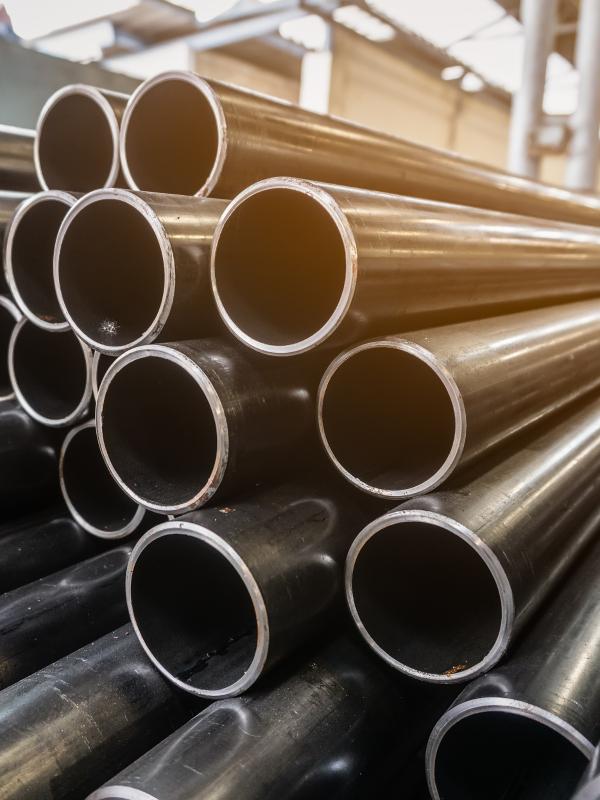
Manufacture forming tools more sustainably: Avoid cold welding with additive manufacturing
Funding duration:
Start
01.08.21
End
31.07.24
The production of forming tools for stainless steel tube processing causes high costs and environmental pollution. Until now, it has required many energy-intensive steps such as vacuum hardening, multiple tempering and a complex physical vapour deposition (PVD) coating. In the PVD process, thin, wear-resistant layers are applied to the workpiece in a vacuum chamber. This improves the surface hardness, but is resource- and energy-intensive.
Another key problem is cold welding during use: During bending, the tube and tool rub against each other, causing metal particles to bond unintentionally. This impairs the service life of the tools and leads to production errors. The research team in the EnERU project is developing a new method to manufacture tools more efficiently and extend their service life.
The researchers want to replace the existing coatings with an integrated functional layer. Instead of hardening and coating the entire mould, they are focusing on targeted reinforcement of the stressed areas. They are using the laser metal deposition process (LMD), an additive manufacturing technique. In the LMD process, metal powder or wire is melted locally with a laser and applied in layers. This creates a metallurgically bonded, wear-resistant surface without having to treat the entire mould.
This eliminates energy-intensive steps such as vacuum hardening and tempering. At the same time, material consumption is significantly reduced because the researchers only reinforce the mould where it is actually necessary. The new process should significantly reduce CO₂ emissions per mould.
First, the team analyses why the existing tools fail. They measure the loads during the bending process and simulate the forces at work. Based on these findings, they develop new materials that are more resistant to cold welding. They then test different material mixtures and grading strategies in order to achieve a stable transition between the base body and the functional layer.
They then produce prototypes using LMD technology and subject them to practical tests. The new tools have to prove themselves in real bending processes and demonstrate their durability under industrial conditions. Should a tool nevertheless show signs of wear, the LMD process enables a targeted repair in which only the affected area is renewed instead of replacing or recoating the entire tool.
The project is therefore laying the foundations for more efficient, more sustainable production of bending tools. In the long term, the technology could also be used for other forming processes such as the cold forming of aluminium tubes.

Reducing scale formation and material losses: new approaches for sustainable production
Funding duration:
Start
01.04.21
End
30.03.23
Hot forging is a key process for manufacturing high-strength components, for example in the automotive and aerospace industries. In this process, steel is formed at high temperatures of over 950 °C, which leads to the formation of scale. Scale is formed through oxidation and causes considerable material losses of 2-3% of the raw material used. At the same time, scale accelerates tool wear and requires additional process steps such as descaling and cleaning.
The loss of material and the increased effort put a strain on the environment, lead to a high loss of energy for the additional material required and increase production costs overall. At the same time, the demand for lightweight components that combine materials such as steel and aluminium in order to reduce weight is increasing. The technical challenges here lie particularly in the reliable bonding of the two materials, as oxide layers such as scale hinder adhesion.
ERProFit aims to minimise the formation of scale during hot forging. A low-oxygen production environment is intended to suppress oxidation and thus reduce material losses and tool wear. This also enables smooth, high-quality surfaces without additional post-processing. The project team wants to develop new technologies for the hybrid forging of steel and aluminium and thus promote lightweight construction.
By doing so, the researchers want to realise weight savings while ensuring a reliable material bond between the two materials. The project focuses on economically feasible solutions: Instead of costly new buildings, existing production facilities are being adapted to the new requirements through cost-effective retrofits. The team also uses industrial waste gases as a protective atmosphere. This increases sustainability and replaces expensive inert gases.
In the first step, the project partners are developing a concept for creating a low-oxygen atmosphere in the production environment of hot forging. By enclosing the production lines and using industrial exhaust gases, they can significantly reduce the formation of scale. This leads to lower material losses, improved material utilisation and a significant increase in tool life. At the same time, complex descaling processes and additional machining steps are eliminated, which increases the efficiency of the entire production chain.
Thanks to their retrofit concept, the researchers can adapt existing systems with minimal effort and realise sustainable production. The project team is successfully testing the technology under real-life conditions on commercially available forming machines. The results show great potential for CO₂ savings: With a production of 500,000 components per year, up to 10,000 kilograms of CO₂ can be avoided.

Efficient machining of high-strength steels: Fineblanking with integrated heating
Funding duration:
Start
01.06.21
End
30.11.24
The automotive industry is faced with the challenge of reducing the weight of vehicles in order to reduce energy consumption and emissions during use. High-strength steels - i.e. steels with increased strength and comparatively low weight that enable high load-bearing capacity and good formability - offer the possibility of producing more stable and at the same time lighter components. The material offers particular advantages for electric vehicles with heavy batteries. Although the production of higher-strength steels requires energy, the lower material input and higher efficiency in vehicle operation can improve the CO₂ balance over the entire life cycle of the vehicles. This is where the team in the FESt project comes in: it is developing an innovative technology to efficiently process these demanding materials and optimally utilise their potential.
The project team wants to develop a new technology for fineblanking high-strength steels that enables components with a lower material thickness and high precision. To this end, the researchers want to heat the sheet metal in a targeted manner before cutting. This will facilitate processing and reduce energy and material consumption.
In addition to material and energy savings, the technology extends the tool life as it reduces wear. The researchers also select high-strength steels with optimised heatability and adapted flow properties in order to further improve fineblanking properties.
The project team is combining two technologies: fineblanking and targeted heating of the material. To this end, it is developing a system that integrates heating units directly into fineblanking presses. In a benchmark comparison, the researchers show that inductive heating is more suitable than laser-based heating. A particular challenge is to integrate the heating in such a way that the material retains the desired temperature during cutting.
The researchers are investigating the interactions between temperature, material behaviour and cutting quality. They are analysing both the optimum heating method and the effects on tool wear and process stability. They are also developing a special lubricant concept that ensures optimum friction properties even at elevated temperatures.
To deepen their understanding of the process, they simulate the fineblanking process using the finite element method (FEM). This enables them to precisely model the effects of heating and optimise the process in a targeted manner.
Finally, the researchers will test the technology in an industrial environment to prove its suitability for practical use. They will also analyse the sustainability of the new method and calculate the extent to which it contributes to CO₂ reduction and weight reduction.

Developing lighter gearboxes for wind turbines: with bionics and innovative sensors
Funding duration:
Start
01.12.20
End
31.05.24
Wind energy plays a key role in the energy transition and is already making an important contribution to German electricity production. In order to achieve the climate targets, the expansion of powerful wind turbines is being driven forward. However, as output increases, so do the dimensions of the turbines, especially the gearboxes, which are key components that require considerable quantities of materials. This increases costs and worsens the carbon footprint of the turbines. In addition, the higher weight of the gearboxes increases the loads on the nacelle and tower, which further increases the material requirements of the entire system.
Previous lightweight construction approaches for gears have mostly been limited to the base body and offer weight savings of up to 45 per cent. This is where the FlexGear project comes in with a comprehensive lightweight construction concept: With bionically inspired structures that extend into the gear rims and innovative manufacturing technologies, the researchers aim to achieve weight savings of up to 65 per cent for gears.
The scientists' main goal is to develop a highly optimised lightweight gearwheel with flexible structures. Their approach is based on bionic design principles that minimise the use of materials while maximising stability. The team is not only looking at the gear wheel base body, but also the gear rims, which will enable them to realise additional weight savings.
Another key element is the inside-sensoring system, which is integrated directly into the gear structure. The researchers use this system to record loads and deformations in real time and transfer the data to a condition monitoring system. This enables the proactive compensation of load peaks, which not only increases operational reliability but also avoids the need to oversize the systems. FlexGear thus aims to improve the service life and efficiency of wind turbine gearboxes while reducing CO₂ emissions during both production and operation.
Firstly, the researchers are developing bionic designs based on natural models such as diatoms. These microorganisms are characterised by their minimal material structures with maximum stability. Using the ELiSE process (Evolutionary Light Structure Engineering), they develop optimised structures that are flexible enough to compensate for load peaks.
To manufacture the gears, the team uses additive manufacturing processes that enable the realisation of highly complex geometries. This technology also makes it possible to integrate sensors directly into the gearwheel. To this end, the researchers are developing an inside sensing system based on thin-film technology. It measures loads and deformations directly inside the gearwheel and transmits the data in real time to a condition monitoring system that recognises and compensates for critical load peaks.
Finally, the team tests the gears on a specially designed test bench under realistic loads in order to check both their structural properties and the functionality of the sensor system. In order to assess the actual mass savings and mechanical load capacity, the researchers compare the demonstrator with conventional gearwheels. At the same time, the bionic design process is being automated so that the knowledge gained can be transferred to other applications in the future.

Automated production of free-form sheets: Additive processes reduce material consumption
Funding duration:
Start
01.01.22
End
30.04.24
Free-form sheets are indispensable for iconic architectural projects such as the Chrysler Building or the Morpheus Hotel. However, their production is complex: They are usually created using expensive manual labour, as existing processes such as incremental sheet metal forming or multiple-point stretch forming are technically too complex and cost-intensive. Alternatives such as shingles or composite materials require compromises in terms of design and are often difficult to recycle.
At the same time, there is a lack of industrial processes for producing free-form sheets efficiently and in a resource-saving manner. This gap exists despite the increasing demand for lightweight, free-form façade elements that meet high sustainability standards.
The aim of the FORMlight research project is to develop a manufacturing technology that can be used to produce lightweight, rigid, material-pure and recyclable thin sheets for façade construction to replace thick sheets or composite materials such as Alucobond.
By using Wire Arc Additive Manufacturing (WAAM), an additive manufacturing technology in which welding material is melted using an electric arc as a heat source and applied in layers, both flat thin sheets and elastically deformed thin sheets are to be locally stiffened and frozen in shape by welding on ribs.
This procedure saves material, reduces the weight of the façade elements and should enable the economical production of free-form façade sheets for construction for the first time. In addition to ecological benefits such as CO₂ savings and complete recyclability, the FORMlight project aims to create new architectural freedom and revolutionise the construction of free-form façades.
The project team is developing various methods for the digital 3D reconstruction of the reflective metal surface of deformed metal sheets. To do this, the team optically records the deformation of the sheet metal and then converts it into a digital model.
In order to be able to apply the reinforcing ribs to the thin sheets using Wire Arc Additive Manufacturing (WAAM), the team determines the permissible process window experimentally and works on techniques for predicting the optimum arrangement of reinforcing ribs. These prediction techniques are important because the optimum arrangement of the reinforcing ribs depends, for example, on the sheet size, the number of ribs, the sheet deformation and the joint and crossing points of the welding ribs.
In order to derive the required free-form geometries more efficiently from the façade planning, the project team programmed a software tool so that the design of the sheet metal geometries no longer has to be done manually but can be automated. Finally, the team produces a demonstrator from moulded sheet metal with different rib arrangements, which is suitable for presenting the promising technology at trade fairs.
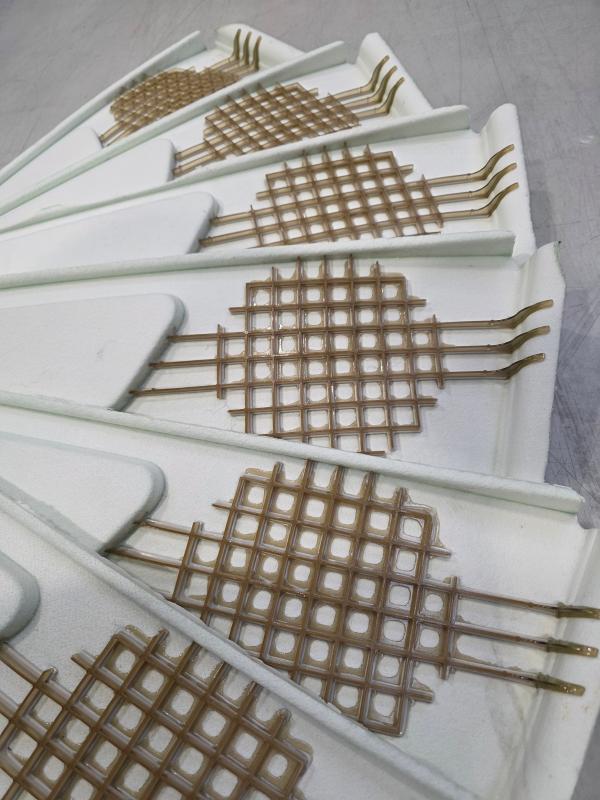
Optimising micro- and monosandwich materials: Lightweight construction for functional vehicle components
Funding duration:
Start
01.10.21
End
30.09.24
Lightweight construction is an important component in making vehicles more efficient and environmentally friendly. Micro- and mono-sandwich materials offer great potential here. They consist of a lightweight core material sandwiched between two cover layers. This structure enables high rigidity and low weight at the same time. In vehicle construction, microsandwich materials have so far mainly been used for simple panelling parts. New solutions are required for more sophisticated components such as door base beams or centre consoles, which integrate additional functions and can reliably absorb mechanical loads. In the FuMi-Lite project, the research team is working on further developing micro- and mono-sandwich technologies for complex applications in vehicle interiors.
The research team is pursuing the goal of optimising micro- and mono-sandwich materials in such a way that they fulfil multifunctional requirements. Specifically, it is working on a combination of materials consisting of a recycled PET foam core and cover layers - such as natural fibre-reinforced nonwovens. This combination reduces the weight by up to 40 per cent compared to conventional materials and at the same time enables new functions. This includes the integration of heating systems or fastening elements. The scientists are also investigating how other sustainable and recycled materials can be integrated into the structure. The aim is to ecologically optimise the entire production chain and make the usage phase of the components more energy-efficient.
First, the researchers analysed the properties of the micro- and mono-sandwich material, which consists of the PET foam core and natural fibre-reinforced cover layers or self-reinforced PET cover layers. Through targeted material and structural optimisations, they developed solutions to stabilise critical areas, for example through local reinforcements or variable material densities.
Another focus is the functionalisation of the components. Here, the team uses processes such as injection moulding to add additional elements such as rib structures for stability. The low pressure resistance of the PET foam core poses a particular challenge here. The researchers tested innovative approaches such as foam injection moulding or special joining techniques in order to maintain the material structure.
The researchers are also investigating how heating systems and insulating layers can be integrated directly into the components. They are also focussing on alternative surface materials such as textiles or paper in order to further reduce the weight and promote the use of renewable raw materials. Finally, the team is testing the developed prototypes and evaluating the entire production chain in terms of environmental balance and readiness for series production.
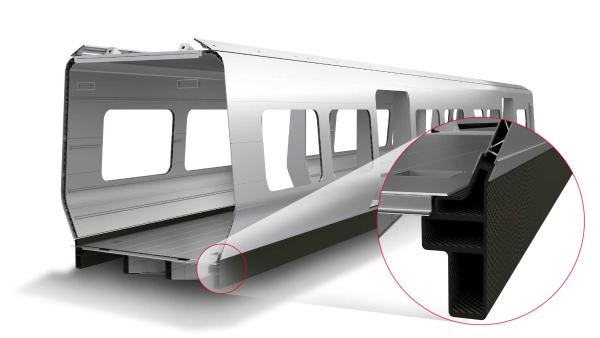
Pultrusion for fibre composites: producing multifunctional lightweight structures
Funding duration:
Start
01.01.21
End
31.12.23
The demands on lightweight structures are increasing: they need to be even lighter, more economical to manufacture and take on additional functions. Fibre composites are ideally suited for this. On the one hand, their mechanical properties open up many fields of application. On the other hand, additional functions can be integrated into these lightweight elements. Just a few lightweight components can fulfil so many technical functions. However, such complex and customised structures cannot currently be manufactured economically in series production, but are instead produced in time-consuming manual work.
The project partners are developing a process to produce multifunctional lightweight structures economically - across all sectors. To do this, they want to use the established technology of pultrusion for fibre composites. Pultrusion means extrusion. This allows continuous fibre-reinforced plastics to be produced efficiently and cost-effectively.
The project team now wants to further develop pultrusion in such a way that both additional materials and electronic components can be integrated into the lightweight structures. The scientists are pursuing two approaches: Firstly, they are developing a mechanically functionalised lightweight profile for rail vehicle construction. The lower vehicle weight can significantly reduce operating and life cycle costs in the transport sector.
Secondly, they are developing sensor-functionalised lightweight construction elements for the rotor blades of wind turbines. These sensor bridges are currently produced manually, with the embroidered strain sensors being processed in a hand laminate. The project team now wants to automate production using pultrusion and ensure mass suitability. The project team then wants to merge the two technologies and thus combine mechanical and sensory functionalisation.
The team integrates metal inserts into the fibre-plastic composites and creates a hybrid layered composite. The inserts act as force transmission or connection points and create additional functionalisation. The components are intended to replace the extruded aluminium profiles in the body of a rail vehicle and significantly increase the degree of lightweight construction while maintaining the same economic efficiency. After optimising the process, the researchers were able to successfully produce several demonstrators. Compared to an aluminium longitudinal beam, they were able to save around 40 percent in weight.
In a second approach, the researchers are integrating strain sensors into the pultrusion process. Their aim is to produce functionalised sensor bridges for wind turbine rotor blades. The sensors recognise overloads and damage at an early stage and have a longer service life. As a result, maintenance intervals and the utilisation period of the turbines can be extended. The team has successfully completed this development and achieved serial production.
To combine the two approaches, the project partners are producing multifunctional profiles for rail vehicle construction by integrating mechanical and sensory functional elements into the manufacturing process. This would further increase the degree of lightweight construction and the condition of the components could be monitored over their entire service life, which would further increase economic efficiency.

Recycle glass fibres by type and without loss of quality: with debonding on demand
Funding duration:
Start
01.07.21
End
31.12.24
Fibre-reinforced plastics (FRP) are key materials for lightweight construction - for example in the mobility, aerospace, construction and energy sectors. Glass fibre reinforced plastics (GRP) in particular currently have a large market share. However, while the advantages of composite materials in operation are convincing, the end of life of these materials poses a challenge: To date, there is no sustainable recycling strategy that allows the individual components to be separated by type and thus enables a circular material cycle.
Since 2005, FRPs have no longer been allowed to be landfilled. Instead, the components are shredded and used as low-grade fillers. Valuable raw materials such as glass fibres are lost in the process, as existing separation processes such as pyrolysis work at high temperatures - which massively damages the mechanical properties of the glass fibres. In addition to the technical challenges, a state-of-the-art industrial recycling process is also not economically attractive - primarily due to the low raw material prices for glass fibres. There is therefore a great need for an energy and cost-efficient recycling solution for GRP that preserves its value - not only from an ecological perspective, but also from an economic one. This is precisely where the team in the FVKCycle project comes in.
The participants want to develop a recycling technology for the pure recovery of glass fibres from GRP. The process should be economical and energy-efficient and enable glass fibre recovery without any loss of quality. The focus is on the principles of recyclability by design and debonding on demand. The material selection and the introduction of thermoresponsive substances during the GRP production process should enable the targeted and controllable loosening of the material bonds.
The thermo-activatable substances are to be activated at moderate temperatures of approx. 150 degrees Celsius, creating microcracks in the plastic. This weakens the polymer matrix locally without impairing the mechanical properties of the fibres. The advantage: The quality of the glass fibres remains unchanged and the glass fibres can be reused in new GRP components after separation from the plastic breakage. In addition, the broken plastic can continue to be used, for example as a filler. In this way, the project team aims to create a holistic solution and show that recycling is possible and marketable in the GRP sector.
The participants are pursuing a novel approach and combining technologies from speciality chemicals production, glass fibre production, coating systems and textile technology. They are developing thermoresponsive substances that are introduced into both the plastic matrix and the sizing - the bonding layer on the glass fibre. To this end, the team is developing different encapsulation strategies for the thermoresponsive substances that are tailored to the respective application environment - aqueous sizing or solvent-free polymer matrix.
Moderate heating causes adhesion fractures at the fibre-polymer interface and cohesion fractures in the polymer matrix. This weakens the material at the crucial points and the glass fibres can be mechanically separated from the plastic without any loss of quality. The researchers will then test the process developed on a laboratory scale under realistic conditions to verify its suitability for practical use.
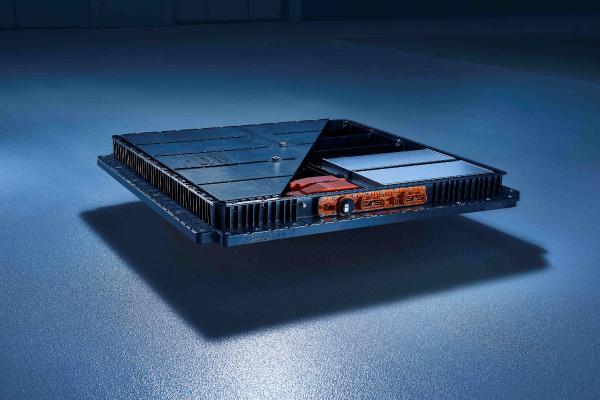
Recycling and cleaning plastics: for recyclable battery housings
Funding duration:
Start
01.07.22
Today
26.06.25
End
30.06.25
With the "Green Deal", Europe is aiming to become climate-neutral by 2050. The recycling of plastics, in particular the use of reprocessed plastic waste, known as recyclates, is a key component of this.
Recyclates also play an important role in resource-efficient lightweight construction: the more recycled plastics are used in lightweight components, the more primary raw materials - and therefore CO₂ - can be saved.
However, one problem is that conventional mechanical recycling cannot sufficiently break down the material composite. It is unclear whether the shredded material is directly suitable as a recyclate or whether the material composite must be completely broken down.
The researchers are using a high-voltage battery housing to investigate how recyclable battery housings can be manufactured. These housings are crucial for the protection of sensitive vehicle batteries and must therefore fulfil high safety requirements, for example in the event of side impacts and underride protection.
They are part of the vehicle's load-bearing structure and must bear a surface load of up to 500 kg through the battery modules. They also integrate complex functions such as battery cooling.
The project team is investigating ways to make battery housings recyclable and recyclable. The researchers are relying on the new adaptive recycling technology CreaSolv®, which uses solvents to recycle and clean plastics. This technology already enables the recycling of thermoplastic films.
The team is now working on transferring this method to the recycling of lightweight fibre composite structures, i.e. engineering plastics. The researchers are analysing the entire life cycle of a fibre-reinforced plastic battery housing across all stages of the value chain.
They are investigating the production and processing of the material, its ageing in use and the possibilities for recycling it so that it can ultimately be used again in the same component. With the prototype developed, the research team wants to demonstrate that the greenhouse gas-intensive primary plastic can also be replaced by recycled material for sophisticated components for electromobility.

Making particle foams more sustainable: Process energy-efficiently, enable recycling
Funding duration:
Start
01.12.20
End
31.05.24
Particle foams such as expanded polypropylene (EPP) are key materials for lightweight construction. In the automotive industry in particular, they help to reduce vehicle weight and thus lower fuel consumption and CO₂ emissions. However, traditional production using hot water vapour is very energy-intensive. Only around one per cent of the energy is used for welding the particles, the rest is lost unused.
At the same time, the recycling of EPP material is not yet sufficiently realised. At the end of its useful life, the material is usually thermally utilised. A genuine circular economy is not yet possible, as the processing of recycled material impairs the quality. This is where the GePart research project comes in: The team wants to improve processing and close the material cycle of EPP sustainably.
The GePart project team is pursuing two key objectives: developing an energy-efficient processing technology and increasing the proportion of recycled material. With the help of radio frequency (RF) technology, the researchers want to weld EPP without water vapour in the future. This saves up to 90 per cent energy, as the heat is generated directly inside the foam beads. At the same time, the scientists want to increase the proportion of recycled EPP material to between 50 and 70 per cent. To achieve this, the project team is further developing the recycling processes and precisely analysing the material properties. The aim is to optimise the quality of recycled EPP so that it meets the requirements for series production.
In order to industrialise RF technology for EPP, the researchers are further developing the process at laboratory level. In doing so, they are able to confirm the advantages of RF technology over vapour-based processing: uniform heating, minimal energy loss and the use of cost-effective plastic tools. At the same time, the team is developing new recycling strategies to reprocess EPP material to a high standard after its utilisation phase.
The scientists are analysing the degradation behaviour of the material along the cycle and optimising the processes for removing impurities. Comprehensive tests have shown that a recyclate content of up to 70 per cent is realistic without compromising the quality of the components. An accompanying life cycle assessment confirms the successes: 15 per cent energy savings in production and 25 per cent less CO₂ emissions through the use of recycled material.
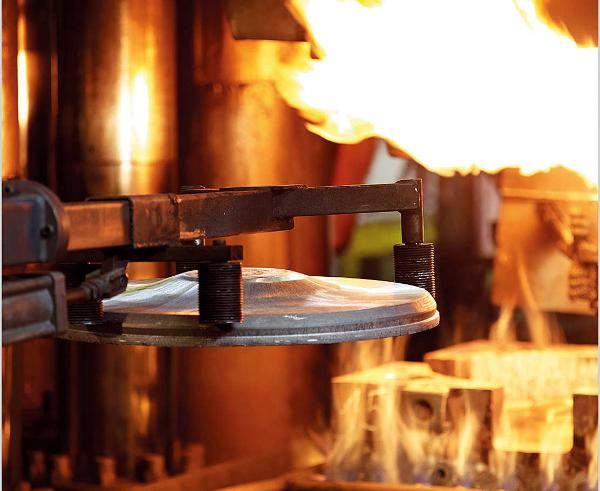
Reusing aluminium scrap in cars: Focus on recycling and material sorting
Funding duration:
Start
01.07.21
End
30.06.24
Sustainable lightweight materials are crucial to reducing the environmental impact of mobility and increasing resource efficiency in the industry. Manufacturers are increasingly using aluminium, especially in highly stressed components such as axle components, wheels, body structures or high-voltage battery housings, as it is significantly lighter than steel, for example, and can therefore significantly reduce CO₂ emissions during the use phase. However, aluminium production is not only expensive, but also releases a lot of CO₂.
One sustainable option is to recycle aluminium. The use of secondary aluminium is not only sustainable, it also pays off for companies. By analysing and optimising the digitalised process chain, the researchers are increasing cost efficiency, for example by adjusting the alloy composition or the forming processes. In this way, lightweight components based on secondary aluminium can be brought into widespread industrial use, for example in mid-range vehicles or aircraft.
In the Green-AL-Light research project, a broad-based consortium is investigating how aluminium from car scrap can be recycled and reused. To this end, the project partners are looking at the entire process chain, starting with the recycling of the cars and the sorting of the end-of-life (EoL) scrap materials. This is followed by the development and testing of new secondary wrought alloys, casting of the alloys with the highest possible secondary aluminium content, processing into components by extrusion and / or forging and testing for use in cars. To ensure that the holistic analysis is successful, the scientists are building up the individual steps in a cross-location and digitally networked manner. They cover all stages of the process chain. The interdisciplinary team aims to demonstrate that EoL material can also be used for highly stressed aluminium components and can be used cost-effectively.
In order for the secondary aluminium to be reused, the EoL scrap must be reliably separated by type and alloy. To this end, the project team is further developing the sorting technology using the laser-induced breakdown spectroscopy (LIBS) process. Among other things, the project partners are investigating whether, and if so, in what quantity, previously undesirable by-elements are contained in the recycled material. This enables them to subsequently adapt and optimise the composition of the alloy.
By reusing EoL scrap in high-quality aluminium alloys, the material cycle is closed. This conserves resources and reduces CO₂ emissions. Using the example of an aluminium forged wheel from Audi, the project partners calculate a potential saving of at least half the CO₂ compared to a wheel made from primary aluminium. In addition, the increased use of secondary aluminium results in less waste that is problematic to dispose of, such as red mud.

Making cold forming more resource-efficient: digital in-process testing
Funding duration:
Start
01.05.21
End
31.12.24
A large proportion of CO₂ emissions are caused by industrial production. Optimised production processes - for example in automotive or mechanical engineering - therefore offer great potential for reducing emissions.
Forming technology, in which raw parts are specifically brought into a different shape without removing material, offers great advantages over conventional production processes, such as machining, in which material is removed from the raw part. In addition to significantly lower CO₂ emissions, formed parts also have very good mechanical properties, which makes them more resistant to loads and thus enables smaller designs. Until now, the production of formed parts with tight tolerances has required solutions specially tailored to the components or processes. In order to bring such forming processes into widespread industrial use without special solutions, generally applicable test methods are needed that guarantee the required quality even at very high production cycles. This is where the GUmProDig research project comes in.
The researchers' aim is to use digitalisation to make cold forming more energy-efficient as a manufacturing process and to significantly improve the accuracy and surface quality of formed parts. This makes it possible to replace energy- and material-intensive machining in many areas. The project partners have calculated that the switch to this more resource-efficient manufacturing process and the reduction in rejects due to the shortened start-up phase of the forming process thanks to inline testing technology will already save large amounts of CO₂.
However, the researchers expect the greatest contribution to CO₂ reduction to come at a later stage: thanks to the continuous inspection and marking-free identification of the components, costly and resource-intensive recalls - which are particularly common in the automotive industry - can be prevented. According to the project partners' forecasts, this should enable total CO₂ savings of more than 600,000 tonnes per year.
The project partners are developing an innovative free-fall inspection system for in-process testing of all manufactured components. The system enables them to precisely record many different quality parameters - such as geometry and surface quality. These parameters can be individually assigned to individual components together with other process monitoring data.
The components are transported individually, but without pre-orientation, via a conveyor belt into a measuring sphere and recorded in free fall from all directions using 16 cameras. Various image processing algorithms, some of which are AI-based, inspect the parts at up to three parts per second with an accuracy of a few micrometres. The project team also uses the individual surface structure of the parts at a defined point as a fingerprint, which can be used to trace them later.
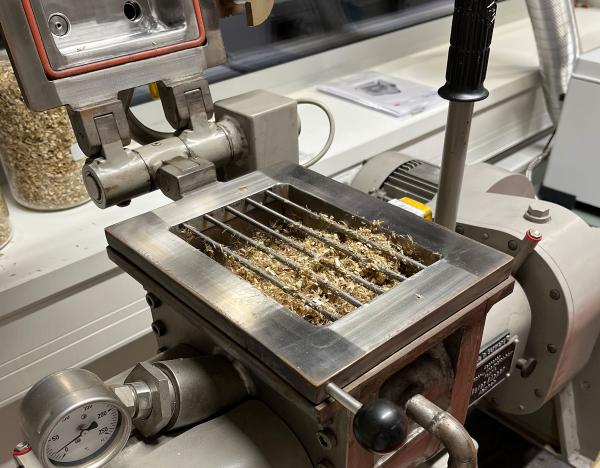
Hemp as a raw material: Making natural materials industrially usable for lightweight construction
Funding duration:
Start
01.05.21
End
31.01.24
The use of natural raw materials is becoming increasingly important in lightweight construction. Hemp fibres offer enormous potential here: they are light, stable and ecologically beneficial, as they bind CO₂ during their growth and do not require intensive irrigation. Nevertheless, their industrial use has so far been limited, as they only fulfil the high requirements of modern lightweight construction materials to a limited extent. The gentle fibre extraction and processing of the fibrous plant parts required for use as a high-performance material and the availability of functionally adequate biogenic matrices are considered a challenge.
Hemp bast bark is therefore considered to be a particularly promising plant fibre material, which impresses with its high mechanical strength due to its morphology, low density and native, unidirectional fibre orientation and can also be used without further fibre insulation.
In the automotive and construction industries in particular, there is a need for materials that can replace fossil raw materials without compromising on stability, processing or cost efficiency. This is precisely where the Hemp-LMC research project comes in, in which researchers are investigating the properties and processing possibilities of hemp fibre elements and hemp saw elements for industrial production.
The Hemp-LMC project focuses on the development of sustainable composite materials. The aim is to use hemp stalk elements as a reinforcing material in sheet moulding compounds (SMC) and bulk moulding compounds (BMC). These materials are used in the automotive industry for interior door panelling, for example.
At the same time, the partners want to develop bio-based resins that can replace fossil resins without compromising production processes. The project team aims to significantly reduce greenhouse gas emissions by using raw materials locally and optimising production processes - by up to 70 percent compared to conventional materials.
The project team is analysing the entire value chain of hemp cultivation and harvesting through to production. The focus is particularly on the processing of hemp and hemp stalk elements. And this right from the first stage - harvesting: New harvesting and processing methods have enabled the simultaneous dual harvesting of stalk and fruit material.
At the same time, the researchers are developing bio-based resins that are on a par with petroleum-based alternatives in terms of curing times and mechanical properties. To ensure practical applicability, the team is testing the newly developed materials in large-scale production facilities. This is followed by an evaluation of product-specific properties such as density, fire behaviour or water absorption of the natural fibre-reinforced plastics (NFRP). This shows that the hemp fibres not only meet the technical requirements, but also enable the resource-saving and cost-efficient production of lightweight structures.

Producing components in a resource-saving way: with forming technology and 3D printing
Funding duration:
Start
01.11.20
End
31.07.24
Industrial companies need to make their manufacturing processes more efficient, resource-saving and environmentally friendly. At the same time, there is a growing demand for lightweight components that reduce the weight of machines and vehicles and thus save energy.
However, many conventional manufacturing methods consume large amounts of energy and material. Highly resilient components are often produced in several complex steps that require high temperatures and long processing times. This leads to high resource consumption and considerable CO₂ emissions. In addition, conventional processes waste a lot of material because components are often milled or cut from solid raw material.
This is where the HyConnect research project comes in. The researchers are combining forming technology with additive manufacturing to produce high-performance lightweight components using less energy and material. Instead of removing excess material, they use materials only where they are needed. This saves resources and makes production more sustainable.
The project team is developing a hybrid manufacturing method that combines the advantages of forming technology and additive manufacturing. While forming processes are characterised by high material and energy efficiency, additive manufacturing enables flexible and precise adaptation of component properties. The combination of both processes results in components that require fewer resources.
The focus is on the development of a barrel sleeve that has to withstand high mechanical loads. Until now, this component has been produced in several energy-intensive steps. The research team is pursuing a new approach: using laser powder deposition welding (LPAS), the researchers want to apply wear-resistant layers in a targeted manner in order to improve the material properties locally. One particular advantage is the in-situ alloy formation, which allows them to adjust the material composition during production. This eliminates the need for subsequent heat treatment, which normally requires high temperatures and a lot of energy.
The researchers also rely on digital process monitoring. It controls production in real time so that machines react immediately to deviations. This not only improves the quality of the components, but also increases the efficiency of the entire value chain.
First, the researchers test how additively applied structures can be moulded and which material properties are created in the process. They then produce a demonstrator sleeve with specifically reinforced wear areas. They use new material models to precisely predict the behaviour of the material during forming.
Another focus is on process monitoring and digitalisation. A blockchain-based data platform documents all production steps in a tamper-proof manner and enables data to be shared across companies. This allows production processes to be traced back precisely and optimised in a targeted manner. The continuous synchronisation of process parameters reduces waste and the researchers increase resource efficiency.
At the end of the project, the team will test the new production method under real-life conditions. The results are not only interesting for the automotive industry, but also for other sectors that require sustainable and high-performance components - from aviation to mechanical engineering.

Utilising hybrid materials: Lightweight trunk floors for commercial vehicles
Funding duration:
Start
01.06.21
End
30.11.23
Lightweight construction is one of the key technologies for sustainably reducing CO₂ emissions in the transport sector. It offers enormous potential, particularly in the area of light commercial vehicles, which make up two thirds of the vehicle fleets in the courier, express and parcel service (CEP) sector. The floor of such vehicles often consists of numerous individual parts made of heavier materials such as wood or metal. This construction method is not only costly and time-consuming, but also difficult to optimise.
One challenge is the use of modern materials such as glass fibre reinforced plastics. Although these materials are light and resilient, they require special processing and manufacturing techniques to make them usable for vehicle construction. The integration of functional elements such as lashing points or screw connections poses additional technical challenges. This is where the HyDuty research project comes in, with the aim of overcoming these hurdles through innovative approaches.
The HyDuty project aims to develop a new box body floor assembly for light commercial vehicles. This floor is made from glass fibre reinforced plastics and hybrid materials. The modular design allows flexible adaptation to different vehicle types. The integral design takes centre stage: It combines the substructure and floor panel in one compact unit.
This eliminates many assembly steps, saving time and costs. In addition to material savings, the focus is on reducing CO₂ emissions over the entire service life of the vehicles - from production and operation through to recycling. The project aims to show that lightweight construction can simultaneously reduce weight, emissions and costs without compromising functionality.
The project team first defines the requirements for the floor assembly. Data from simulations and real test drives are incorporated in order to map the typical loads that a CEP vehicle is subjected to on a daily basis. On this basis, prototypes are created which are manufactured from glass fibre reinforced plastics using the extrusion process.
This process makes it possible to integrate functional elements such as lashing points or fastening elements directly in a single production step. This is followed by validation: the structure is tested on a test bench and in real-life use. The team checks whether the simulated loads correspond to the real loads. The results are used to optimise the design and manufacturing processes.
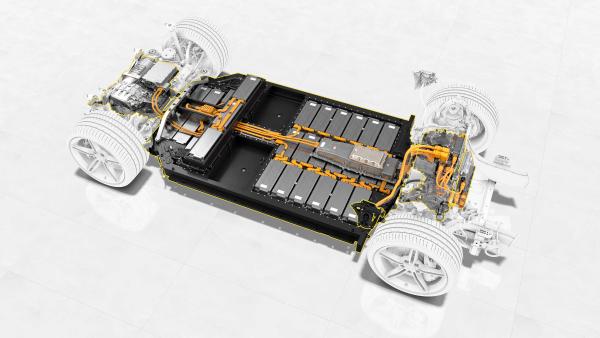
Automatically detect damage: intelligent battery protection system for electric cars
Funding duration:
Start
01.12.20
End
30.11.23
For the energy transition to succeed in the long term, it is crucial to gradually electrify the transport sector. One of the biggest obstacles is currently the comparatively short range of electric vehicles. Lightweight construction offers considerable potential here, as it can help to reduce the moving masses and thus increase the vehicle range.
The battery protection structure of an electric vehicle is located underneath the traction battery and protects it from mechanical loads such as stones thrown up from the road. Up to now, it has usually been made of thick-walled aluminium, steel or titanium and is therefore heavy and expensive.
In addition, there is currently no way to automatically determine the extent of damage after a mechanical load without removing components, meaning that a visit to the workshop and possibly a replacement of the entire structure may be necessary even on mere suspicion.
In the I-Detekt project, the project partners want to develop an intelligent battery protection system for electric vehicles that automatically recognises damage to the battery protection structure, but also to the battery itself.
The project team wants to develop a battery protection structure made of a glass fibre-reinforced plastic with integrated sensors. The latter should automatically recognise and classify relevant damage. Thanks to the lower component weight, resources can be saved both during production and throughout the entire utilisation cycle. The integrated sensor technology also leads to further significant savings in material resources, as the battery protection and the battery itself only need to be replaced if there is actually a defect.
The team wants to test and verify the structures both virtually - using digital twins - and experimentally in order to enable subsequent industrial series production. This is made possible by the broad technical composition of the consortium across the entire supply chain. In the future, the intelligent battery protection system should also be transferable to other sectors and applications, such as rail vehicles or mechanical and plant engineering.
The project partners anticipate potential greenhouse gas savings of up to 440,000 tonnes of CO₂ equivalent. This calculation is based on the VW Group's annual production of electric vehicles from 2025 onwards, with an average mileage of 200,000 kilometres.
The research result shows that the detection of damage levels via the underbody protection system is possible in principle. The technical challenges such as component complexity and differentiation of the damage stages now need to be clarified in more detail, as do the potential economic and ecological issues.

Optimising die casting for electric cars: with innovative aluminium alloys and magnesium
Funding duration:
Start
01.01.21
End
31.12.23
Since the beginning of motorised transport, cast components have been an elementary component of vehicle technology. German foundries lead the global market with their highly developed die-cast parts for combustion engines, transmissions and structural components. In order to secure this technological leadership in the face of the electromobility transition, companies must now optimise their materials and processes for use in electric cars. To this end, the project team is utilising various lightweight construction technologies along the value chain. The partners cover the entire automotive production process - from material, component and process development to supply and use in the car.
The project partners want to optimise the materials, construction methods and die casting processes so that components can be produced with lower weight, lower costs, improved quality and reduced CO₂ emissions. On the one hand, the project team is developing new aluminium die-casting alloys with a high proportion of recycled material, which exhibit the required properties directly after die-casting without any further process steps. These innovative alloys have better mechanical properties, make the components lighter and do not require energy and cost-intensive heat treatment. Compared to conventional aluminium solutions, they make components up to 20 percent lighter, which also saves costs and CO₂ emissions in the application.
The researchers also want to develop magnesium die-cast parts for the electric drivetrain. Magnesium is not only lighter than other metals, but also has significantly better damping properties, which are advantageous in the electric drivetrain to reduce disturbing noises.
For the casting of magnesium components, the project team is endeavouring to raise the component quality in the cold chamber die casting process to the level of today's hot chamber processes by using so-called vacural technology. This makes it possible to produce highly stressed or large magnesium components with low reject rates and very good material properties.
The researchers are combining their findings in the construction of a representative part from the electric drive train. For example, they are developing the bearing cover of a gearbox module, which is ideally suited to demonstrating the improved mechanical properties with its bearing seats and diverse local stiffening ribs. Thermal conductivity and vibration damping also play a major role here. The gearbox cover is developed, manufactured and tested as a variant made of secondary aluminium and magnesium. The application with its material variants is selected so that the research team can transfer the knowledge gained to other components of the electric drivetrain or the vehicle structure.

Recycling carbon fibre-reinforced plastics: raw materials for lightweight construction
Funding duration:
Start
01.01.21
End
30.06.23
Carbon fibre reinforced plastics (CFRP) are important materials for many lightweight construction solutions, as they offer high strength and rigidity with low weight. However, the production of carbon fibres is energy and resource-intensive and emits large amounts of CO₂. It also generates a great deal of production waste, as up to 40 per cent of the material is disposed of as offcuts or rejects during production. At the same time, this waste and CFRP components are often not recycled at the end of their product life cycle, but instead landfilled or incinerated - an environmentally damaging process that leaves valuable raw materials unused. In order to increase the recycling rate of CFRP, provide high-quality secondary raw materials and establish a closed material cycle for CFRP, new recycling technologies must be developed. This is where the scientists in the Infinity research project come in.
The research team is pursuing the goal of recycling CFRP sustainably and economically and drastically reducing the use of primary material. To this end, the researchers are establishing a closed-loop system in which recycled carbon fibres (rCF) are recovered from CFRP waste and processed into semi-finished textile products. These materials should offer the same mechanical properties as primary material - but with a fraction of the energy and resource input. Using specially developed technologies, the researchers want to recycle not only the fibre itself, but also the pyrolysis oil - a by-product of the recycling process. With this holistic approach, the team aims to significantly reduce CO₂ emissions along the entire process chain. The materials produced are not only more environmentally friendly, but also cost-efficient, which enables their broad application in various industries, such as aviation, automotive engineering and wind turbine construction.
The project team is initially developing a new type of pyrolysis pilot plant in which recycled carbon fibres are recovered in high quality and the resulting pyrolysis oil is processed for material recycling. At the same time, the researchers are developing a textile processing line that converts CFRP waste into high-quality intermediate products in the form of unidirectional tapes. They are testing these materials in industrial processes to prove their suitability for high-performance applications. With an accompanying life cycle analysis, the scientists are also ensuring that the targeted CO₂ savings are measurable.
The developed Infinity tapes achieve around 88 per cent of the tensile strength and modulus of elasticity - this value indicates how much a material deforms under tension - of a comparable new fibre product. In addition, the life cycle analysis shows a reduction in greenhouse gas potential of up to 66 per cent depending on the choice of recycled fibre. The project thus makes an important contribution to the genuine substitution of new fibre CFRP instead of downcycling to weakly oriented materials and the associated loss of mechanical properties.

Magnesium die-cast containers last longer: internal coating reduces wear
Funding duration:
Start
01.11.21
End
31.10.24
Hot chamber die casting is a proven process for the mass production of cast parts. Magnesium in particular offers great potential for lightweight construction applications, as it is significantly lighter than aluminium. However, its use in industry remains limited. The reason: the highly stressed casting containers wear out quickly. After around 80,000 to 100,000 shots, they have to be reworked or replaced. Reworking - such as increasing the internal diameter - requires the replacement of pistons and sealing components.
These adjustments change the filling parameters, which reduces process reliability and leads to increased rejects. Previous approaches, such as the installation of replaceable wear parts or conventional internal coatings, failed due to leaks and cracking caused by the limited weldability of the material.
In the InMaGie research project, the project team is developing a new process chain for the internal coating of magnesium die-cast containers. The aim is to increase the service life of the containers to over 120,000 shots and to enable the reconditioning of worn components. The researchers are using what is known as the EHLA process, short for extreme high-speed laser cladding. This is an additive manufacturing process that applies highly resistant coating alloys - such as cobalt-based ones - using fusion metallurgy.
Coordinated heat treatment and additional plasma nitriding, i.e. hardening the surface layer by enriching it with nitrogen, ensure a permanent bond between the coating and the substrate. The increased service life reduces material consumption and significantly reduces CO₂ emissions. With this improved technology, the project team aims to make magnesium die casting economically viable for cost-intensive sectors such as the automotive and aerospace industries.
The project team first optimises the EHLA process by precisely adjusting parameters such as laser power, welding speed and material application. In iterative series of tests, the researchers produce prototypes with different coating alloys. They then integrate targeted heat treatments and plasma nitriding to strengthen the metallurgical bond between the coating and the container.
Detailed material analyses and continuous tests are incorporated into the optimisation of the entire process chain. The results obtained form the basis for industrial implementation and the wider use of magnesium die casting in demanding applications.

Keeping aluminium in the cycle: pure new scrap processing with laser spectroscopy
Funding duration:
Start
01.05.23
Today
26.06.25
End
30.04.26
Aluminium is a key material for many industries, particularly in automotive engineering. However, its production is energy-intensive and global demand is constantly increasing. Recycling can lower the demand for primary aluminium and significantly reduce CO₂ emissions. However, existing aluminium recycling processes are reaching their limits: The recycling of new aluminium scrap - i.e. waste generated during production - from the automotive industry into high-quality alloys is particularly challenging. For example, when stamping body and structural components, 30 to 50 per cent of the aluminium used accumulates as scrap. Many of these scraps are currently mixed together. As the different alloys used are very similar in terms of appearance and density, it has not been possible to separate them efficiently, meaning that they are no longer used for demanding applications. As a result, they flow into lower-quality products. At the same time, large quantities of new aluminium scrap are exported instead of being reused in Germany. This is where the KANAL research project comes in with the development of a closed recycling process chain.
The project team is working on establishing an efficient recycling system for mixed new aluminium scrap. The participants want to sort and recycle scrap from automotive production in such a way that it can be reused for high-quality lightweight construction applications in production - for example for body and structural parts. The researchers are using the innovative LIPS technology (laser-induced plasma spectroscopy) for this purpose, which can be used to precisely identify and separate different aluminium alloys. In addition to developing the technology, the researchers are also investigating the economic potential and possible CO₂ savings of the process. They are also investigating how the approach can be transferred to other sectors such as aviation or construction.
In order to enable a closed recycling chain, the researchers first analyse the requirements along the entire process - from scrap generation to sorting and recycling. They then test and optimise the LIPS technology in a demonstration plant under real conditions. In doing so, they work with industrial material flows to ensure practical applicability. The system uses 3D object recognition to determine and precisely analyse the shape, height and position of the material. Even overlapping or irregularly shaped aluminium parts can be precisely identified and sorted. As a result, the system achieves a sorting accuracy of over 95 per cent, allowing the aluminium to be reused without any loss of quality.
At the same time, the team is evaluating the ecological and economic impact of the process in order to make it sustainable and marketable in the long term. Finally, the researchers are investigating how the technology can also be utilised for other industries. The aim is to further develop the recycling process so that high-quality aluminium can be recycled in the future in a way that conserves resources.

Rollers made from carbon fibre-reinforced plastic: creating a highly functional coating
Funding duration:
Start
01.12.21
End
30.11.24
In many branches of industry, rollers fulfil key functions in production - from hygiene products and packaging to vehicle parts. Manufacturers usually produce these rollers from steel or aluminium, which results in high weight and the associated energy losses and mechanical wear. As an alternative, CFRP, i.e. carbon fibre reinforced plastic, is becoming increasingly important.
CFRP is produced by combining carbon fibres with a plastic and offers low weight and high strength. However, CFRP can only withstand temperatures between 80 and 120 degrees Celsius. Conventional non-stick coatings, which are designed to prevent materials from sticking to the rollers, often require 200 to 400 degrees Celsius to harden and would therefore damage the CFRP rollers during application.
Processes such as the sol-gel process - in which fine particles are applied in a liquid and cross-linked using heat - reach their limits here. The challenge is to develop a coating that does not overheat the sensitive CFRP and yet reliably prevents the adhesion of production materials.
In the LACK research project, the project team is developing an innovative, laser-based coating process for CFRP rollers. The researchers want to realise a highly functional non-stick coating that keeps the CFRP substrate below 120 degrees Celsius despite high curing temperatures (over 200 degrees Celsius). They are pursuing two approaches: Polymer-based systems with FEP (fluoroethylene propylene) and PFA (perfluoroalkoxy) as well as sol-gel-based processes in which silicone oil is also used.
The scientists optimise the material composition through the targeted addition of laser absorbers, which use the laser radiation effectively to cure the coating with pinpoint accuracy. The process lowers energy consumption, reduces CO₂ emissions and extends the service life of machines - an important step towards greater efficiency and sustainability in production.
The researchers start by applying a special adhesion layer. This layer acts as an adhesion promoter between the CFRP and the subsequent non-stick coating and protects the material from thermal stress. They apply the adhesion layer by thermally spraying metal or ceramic particles.
The scientists then apply the non-stick material mechanically by spraying. The material formulation is specifically adapted to the laser wavelength - for example by adding laser absorbers and low-viscosity components. Using a precise laser beam, they cure the coating in fractions of a second so that only the coating is heated.
At the same time, the project team is testing the process under real production conditions and developing concepts for repairs directly on the system (in-situ repair). The researchers are also carrying out a comprehensive life cycle analysis to demonstrate the economic and ecological benefits.

igh-strength aluminium alloys in car manufacturing: Laser beam welding in localised vacuum
Funding duration:
Start
01.04.21
End
31.12.23
Lightweight construction is an important building block for more climate-friendly mobility. Aluminium in particular offers great potential as a material for lowering the weight of vehicles and thus reducing CO₂ emissions. Aluminium alloys are already being used successfully in automotive engineering, for example in body parts and chassis. However, one of the strongest aluminium alloys, EN AW 7075, which has strengths comparable to high-quality steels, could not be processed until now as it tends to form hot cracks and pores when welded using conventional techniques. This is where the research team in the LaLoVak project comes in.
The aim of the project team is to develop a new type of joining technology: laser beam welding with localised vacuum (LaVa). With this method, the previously unprocessable EN AW 7075 alloy is to be utilised in automotive construction in order to enable lighter and at the same time more resilient components. The process is intended to improve weld seam quality, save material and energy in production and significantly reduce CO₂ emissions.
The researchers are working on a welding gun that only generates a localised vacuum at the welding point. This makes it possible to process high-strength aluminium alloys without the need for large and cost-intensive vacuum chambers. Thanks to the compact and efficient design of the tool, even large-volume and complex components, such as those used in car body construction, can be processed economically.
At the start of the project, the researchers are analysing the EN AW 7075 alloy to determine its properties and suitable welding parameters for pore-free and crack-free processing. At the same time, the team is developing a prototype welding gun with innovative sealing systems and optical protection components that ensure stable vacuum generation.
The researchers are continuously testing and improving the technology in order to further increase weld seam quality and energy efficiency. One important step is the integration of the welding gun into a robot-supported system that allows flexible and practical use on an industrial scale.
At the end of the project, the team will further develop the local vacuum system into a product that demonstrates the application of the technology on realistic car body parts such as doors or pillars. An important goal in product development is a short evacuation time, which is reduced to less than 1.5 seconds through consistent optimisation. The researchers are thus providing a basis for series production and demonstrating potential for industrial use.
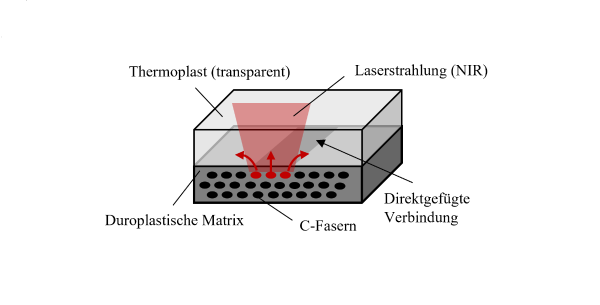
Joining plastics detachably: Laser direct joining replaces gluing and screwing
Funding duration:
Start
01.09.21
End
28.02.25
Industrial companies - for example in the aviation, automotive and wind energy sectors - are faced with the challenge of designing components that are both lighter and more sustainable. Carbon fibre reinforced plastics (CFRP) - in particular thermoset epoxy resins (EP-CFRP) - are a key material for lightweight load-bearing structures in aircraft, vehicles and wind turbines due to their high strength and low weight. In less stressed areas, companies are increasingly turning to thermoplastics (TP), which are easy to mould, cost-effective to process and efficient to recycle.
The combination of TP and CFRP offers great potential for multi-material lightweight construction. However, conventional joining methods such as gluing or screwing are reaching their limits - for example due to material incompatibilities, high resource consumption or limited recyclability. This is precisely where the LaserDireCt research project comes in.
The project team is developing a laser-based joining process that can be used to join thermoplastics directly and stably with thermoset CFRP structures. The connection is made completely without adhesives or mechanical connecting elements. The aim is to develop a resource-saving technology suitable for series production that enables detachable joints and avoids structural damage.
The team also wants to significantly reduce the use of materials and energy and improve recyclability. The researchers are specifically analysing influencing variables and defining relevant process limits. They are also demonstrating and evaluating the process under practical conditions that are relevant to the application. In this way, they carry out a holistic assessment of the technology and identify specific industrial application potential. The process should also be flexibly transferable to other material combinations, such as the joining of painted metals or other thermosets.
The project team is initially analysing the physical principles of laser-material interactions in complex material combinations and their effects on the homogeneity of the temperature distribution. It is investigating how the heat from the laser can be introduced into the CFRP structure in a targeted manner without damaging the sensitive fibre matrix. At the same time, the researchers are analysing the melting behaviour of the thermoplastics and the boundary layer between the materials. The aim is to optimise the process parameters in such a way that a stable and reversible bond is created.
At the same time, the project partners are testing the process under practical conditions - for example with fastening elements or stiffening structures. To this end, they are developing demonstrators that can be transferred to industrial series production. An accompanying industrial group brings in requirements from various sectors and supports the subsequent implementation. In this way, scientific findings are channelled directly into applications.
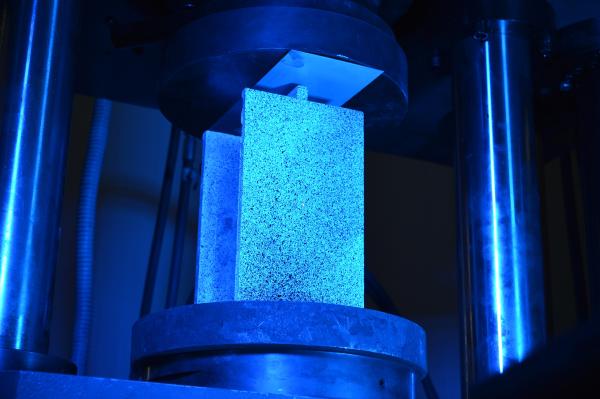
Durable and sustainable materials: carbon fibres and granite replace steel and concrete
Funding duration:
Start
01.05.23
Today
26.06.25
End
30.04.26
The construction industry is one of the biggest producers of CO₂ emissions worldwide. Commonly used building materials such as steel and concrete contribute significantly to this problem due to their energy-intensive production. In addition, their limited durability and susceptibility to corrosion increase maintenance costs and environmental impact. Innovative material solutions are needed to reduce CO₂ emissions in the construction industry, conserve resources and increase material efficiency. One promising approach is the combination of granite and carbon fibres, which enables significantly lighter and more durable structures than conventional building materials.
Natural stones such as granite are very strong under compressive load. By combining them with stiff carbon fibres, the composite material can also be strengthened for other stresses. Modern resin systems bond the materials and, when protected against UV light, are also very durable. The innovative hybrid material can thus be used to produce components that bind CO₂ in the long term and are sustainably and permanently protected against erosion caused by mechanical stress.
The aim of the researchers in the LeBaMaN project is to prove the practical suitability of the innovative material combination. To this end, they are concentrating on two specific applications - railway sleepers and load-bearing structures for the construction of bridges.
The project team is working on testing the railway sleeper until it is ready for certification and providing a finished product that is highly resistant to damage and has a long service life. The use of the material for bridge construction is also being extensively investigated and tested in long-term tests in real-life applications.
In addition, the researchers are analysing the competitiveness and climate impact of the hybrid material using modern life cycle and technical-economic analyses. Both applications are intended to show whether, on the one hand, CO₂ emissions can be significantly reduced in production and over the entire life cycle with better properties compared to conventional steel and concrete components. On the other hand, whether the material combination can also compete economically with existing products and also offers advantages such as lower maintenance costs and a longer service life. The results should pave the way for series production and illustrate how this construction material can replace steel and concrete in the long term.
First, the researchers optimise the combination of materials in order to develop a resilient and economically viable composite material. The project team then produces demonstrators, which are tested for stability and durability in realistic load tests.
The researchers examine the railway sleepers in different variants - from solid granite-carbon constructions to hybrid designs with a concrete core. In operating load simulations, they check whether the components can withstand the actual loads in the long term.
For the bridge, the team relies on filigree lightweight constructions with girders made of carbon fibre-reinforced natural stone. A pedestrian bridge up to 18 metres long is being developed and built to test the long-term behaviour in real use. Extensive monitoring of the construction over three years is planned, with which the most important data will be collected and checked for changes.
The project partners have been recognised for their research with the prestigious JEC Composites Innovation Award 2025 in the building construction and civil engineering category.

Building plastic gearboxes more efficiently: thanks to new standardised test methods
Funding duration:
Start
01.01.21
End
31.03.24
Plastic gears with intersecting axes are a key technology in numerous applications such as e-bikes, industrial robots and medical technology. They enable precise movements and save energy thanks to their low weight. Nevertheless, there is a lack of scientific data on their behaviour under load. In particular, there are no standardised findings on load-bearing capacity, efficiency and wear behaviour.
Companies have therefore had to rely on conservative assumptions, which has often led to oversized components. At the same time, the potential for material and weight savings was not fully utilised. In view of increasing demands for efficiency and sustainability, there is an urgent need to deepen the scientific understanding of these gears and optimise their performance.
This is where the LeKkA research project comes in. The aim is to fundamentally improve the design and utilisation of these drive components. To this end, the project team is developing new test methods that precisely record load-bearing capacity and wear.
The focus is on the material pairing PEEK/PEEK, which is characterised by high temperature resistance, low friction and excellent wear properties. The researchers want to significantly reduce the weight of the gears without compromising their performance. This should enable companies to realise resource-saving and high-performance drives for demanding applications in the future.
The researchers are systematically investigating the load-bearing capacity and wear behaviour of plastic gears in laboratory tests. They are developing a standardised test procedure that delivers reproducible results under different load and temperature conditions.
In addition, the project team is developing a theoretical model that describes the complex interactions between tooth geometry, material properties and operating conditions. This model makes it possible to precisely dimension gears and optimise their efficiency. The experimental results showed that PEEK/PEEK pairings have the potential to significantly improve previous material utilisation.
The knowledge gained creates a reliable basis for the development of lighter, more efficient drive systems and at the same time reduces material consumption and the carbon footprint.

Making trains and ships lighter: Force flow-optimised, automated differential structures
Funding duration:
Start
01.06.21
End
31.07.24
Rail vehicles and cruise ships have the largest single mass in their bodyshell structures. Reducing this mass offers enormous potential for saving energy and CO₂. A lightweight construction system that reduces this mass by 20 per cent can significantly reduce energy requirements. At the same time, both industries face the challenge that sustainable solutions must remain economically viable.
It is therefore necessary to implement lightweight construction measures not only in design, but also in production without incurring additional costs. Automated manufacturing processes play a key role in reducing costs and making production more efficient. This is where the LESSMAT research project comes in.
At LESSMAT, the team is developing a cross-industry lightweight construction system that maximises local material utilisation while reducing production costs. The researchers are focussing on assemblies that are used in both industries, such as side walls, roofs and underbodies for rail vehicles or deck sections and walls for cruise ships. The designs are based on the differential construction method, in which sheet metal is combined with stiffening elements. The aim is to achieve maximum strength and rigidity with minimum use of material.
At the same time, the project team is developing automated production processes that take into account small batch sizes and a wide range of variants. A central task is the integration of digital tools in order to transfer design data directly to production. The project thus not only creates lighter and at the same time more resilient components, but also cost-efficient production.
The project team is working on three core areas. Firstly, the researchers are developing a design that enables greater local material utilisation. For example, bionic structures, optimised use of materials and partially differential assemblies allow them to significantly reduce the mass of the flat assemblies. Secondly, an automation solution is being created that takes over the production steps such as feeding, positioning, joining and testing. The aim is to adapt these processes to the requirements of small production batches, i.e. production batches with low quantities, while at the same time ensuring a high degree of flexibility for different variants.
Thirdly, the researchers are linking digital technologies with design. Simulation methods such as the finite element method (FEM) test the automation capability of the construction method as early as the design phase. The digital link also enables the seamless transfer of design data to production. The technologies developed are checked and optimised in real tests.

Building fertiliser spreaders more sustainably: lightweight and modular support structure
Funding duration:
Start
01.01.21
End
30.04.24
The growing global demand for food and renewable raw materials requires increasingly intensive farming. This is accompanied by problems such as increasing soil compaction, which is also caused by increasingly heavy machinery. Conventional fertiliser spreader booms made of stainless steel structures are already so optimised in their lightweight steel construction that no major weight savings are possible. With innovative technologies and new material approaches, lightweight construction can help to make machines lighter and more efficient and thus make agriculture more sustainable.
The LE²GRO project aims to develop a near-series, weight-reduced and modular support structure for fertiliser spreader booms. By using innovative lightweight construction technologies in the form of braided fibre-thermoplastic composite profiles, heavy and cost-intensive stainless steel tubes are to be replaced. This enables comprehensive manufacturing, structural and functional integration while avoiding cost-intensive post-processing steps. The scientists are not only striving for technological innovation, but also for an economically viable solution for the agricultural machinery industry.
The researchers use the continuous blow moulding process for the production of fibre-reinforced thermoplastic hollow profiles and develop a digital tool for the automated design and dimensioning of the supporting structure. They are developing load-appropriate profile connections and innovative braided node structures and implementing them as prototypes. The modularisation of the supporting structure enables rapid adaptation to different application scenarios and helps to increase efficiency when spreading the fertiliser. Integrated sensor technology also enables continuous monitoring and optimisation of the agricultural machine.
In addition, the researchers are further developing process chains to ensure the economical production of functional load-bearing profile structures and to guarantee consistent quality monitoring. The innovative approach of the multi-material support structure design not only promises a significant reduction in component complexity, but also improved competitiveness for the German agricultural industry as well as more sustainable agriculture by reducing soil compaction and optimising fertiliser application.
The project participants have been awarded 1st place in the "Innovative Products and Applications" category of the AVK Innovation Award 2024.
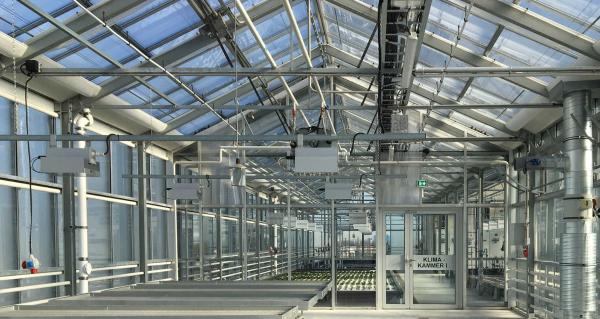
Glass-foil roofs save resources: modular translucent roof system
Funding duration:
Start
01.07.21
End
31.12.23
Glass roofs span railway stations, leisure pools and shopping arcades. This translucent overhead glazing is usually made of several panes of insulating glass. What appears light and bright is actually heavy and consumes a lot of resources. This has a detrimental effect on the overall construction, material transport and installation. Lighter film-based materials, on the other hand, are still being trialled today. An integrated overall system is missing.
The project partners are developing an innovative, lightweight and modular lightweight construction system for translucent roofing. To this end, they are combining a modular glass-foil system with an inner roof made of a mobile, translucent and IR-reflective fabric. The modular system consists of ETFE film covering (ETFE: ethylene tetrafluoroethylene copolymer) and toughened safety glass. ETFE is now permeable to up to 95 per cent of light. These building envelopes are becoming increasingly important in architecture in particular, as the materials are better characterised and it has been possible to overcome production-related obstacles through bonding and welding, for example. Prominent examples of the use of ETFE are the "Allianz Arena" in Munich and the "Water Cube" in Beijing.
The project team calculates that the translucent roof system made of glass and foil will weigh 75 per cent less than conventional roof coverings with triple insulating glass. This results in CO₂ savings of up to 29.2 kg per square metre of surface area for the Light-Light-Roof lightweight construction system. In horticulture and the plant trade, the project partners are forecasting a CO₂ reduction of over 1.4 million tonnes in ten years for Europe-wide "production under glass". In addition, there are further, as yet unquantifiable savings in building construction: for example, architects could design slimmer and lighter buildings, as the load-bearing structure would have to bear significantly less weight. In addition to the plant trade, Light-Light-Roof is also interesting for other markets, such as the construction of shopping arcades, railway stations, leisure pools, hotels or building facades.
The project partners create a prototype that they test under real conditions. In a representative environment: in the "Altmarktgarten Oberhausen" rooftop greenhouse, they are investigating the glass-foil roof in various material combinations on a roof area of 40 m² in year-round operation. The "Altmarktgarten Oberhausen" is a building-integrated rooftop greenhouse with its own research and development area. It is a flagship project of the federal programme "National Urban Development Projects" and thus attracts a great deal of attention. In addition, the system is being demonstrated and analysed for use on façades at the Fraunhofer UMSICHT site.
The project team is installing a sensor network in the rooftop greenhouse in order to investigate and visualise the light and climate management of the overall system. In addition to visualising the entire database, various sub-visualisations are created that provide insights into the temperature and humidity behaviour of the individual levels. In addition to a clear data evaluation, this visualisation is primarily used for demonstration purposes. Interested parties can clearly and intuitively understand the operating behaviour of the system when environmental parameters change, such as the opening and closing of the vents. The project team is particularly focussing on the expanding market for production systems located in urban areas.

Production of high-strength aluminium components: with high-temperature pressure forming
Funding duration:
Start
01.01.22
End
30.06.24
High-strength aluminium alloys are a promising way for the automotive industry to reduce material consumption and CO₂ emissions. These materials offer an optimum ratio of weight to strength and are therefore suitable for use in load-bearing structural components such as car body components. However, the processing of high-strength aluminium alloys has so far quickly reached its limits with conventional forming techniques: The low formability of these materials at room temperature often leads to cracks, which makes them difficult to use in large-scale production.
Hot forming offers a way out here, as higher temperatures can improve flowability and prevent stress cracks. High-temperature pressure forming (HDF technology) offers an innovative solution by enabling efficient processing of these alloys through targeted heating and precise pressure control. However, optimised process chains suitable for large-scale production that allow the economical manufacture of complex components are still lacking.
This is where the LIGHT_ENABLER research project comes in. The aim is to optimise HDF technology so that customised components can be manufactured from high-strength aluminium alloys. The focus is on the development of an integrated and automated production process chain that enables aluminium alloys to be formed into complex geometries through targeted hot forming without compromising the material strength.
To achieve this, the project team combines forming processes such as hot upsetting and hot bending. Another aim is to minimise material waste and increase process stability in order to reduce manufacturing costs. The processes developed ultimately provide the basis for integrating this technology into large-scale production.
First, the researchers investigate the thermal and mechanical properties of the aluminium alloys under varying forming conditions, such as temperature, pressure and deformation speed. Building on this, the team is developing an integrated process chain that extends from the raw material to the finished component. Central elements are targeted heat management, customised tool concepts and the use of the finite element method (FEM) for simulation.
Using HDF technology, the researchers then produce the first prototypes of "tailored tubes", i.e. structurally adapted tubes, and "tailored bended tubes", in which complex bending geometries are integrated. These components have an optimal combination of low weight and high mechanical strength.
Finally, the team is testing the series integration of HDF technology. The project partners are focusing on scaling and automating the processes as well as minimising energy consumption and production costs.

Reducing CO₂ emissions in logistics: plastic load carriers in fibre composite construction
Funding duration:
Start
01.12.21
End
30.11.24
Companies use so-called large load carriers for the worldwide transport of goods and vendor parts. Thanks to their customised design, they offer special protection and have plenty of storage space - especially for heavy and bulky goods, machine parts or workpieces. Components for the automotive industry in particular are transported worldwide in these containers. An estimated 2.5 million large plastic load carriers are used in the automotive sector alone. For heavier goods and supplied parts, lattice boxes made of steel are currently used. Their disadvantages: The rigidly constructed boxes have a high dead weight and cannot be folded to save space when empty. This results in high CO₂ emissions in logistics and transport, as the utilisation phase accounts for the majority of greenhouse gas emissions from large load carriers.
The project team is optimising comparatively lightweight plastic large load carriers so that they are more stable and at the same time more flexible in use in order to reduce greenhouse gas emissions in logistics and the environmental impact of the production and recycling of large load carriers. To this end, the researchers are developing a fibre composite construction method suitable for large-scale production for optimised plastic-based large load carriers. With these thermoplastic-based sandwich constructions, they want to achieve a better mass-performance ratio in order to further increase the payload and load capacity of plastic-based large load carriers. The volume of the boxes can be minimised many times over for empty transport by folding them up and stacking them on top of each other. This saves CO₂, as significantly more boxes can be transported in one lorry. The lightweight sandwich construction also extends the service life of the transport containers. The team also wants to reduce the repair rate through an optimised design and functional integration - with an increased payload. The researchers want to recycle the fibre-reinforced thermoplastics and recycle them in the large load carrier system or make them available to other plastics processing industries.
For the innovative lightweight carrier box, the researchers combine two fibre-reinforced cover layers with a core material that has already been successfully used. This enables an optimised ratio between mechanical properties and component weight, with industrial production and recyclability. Compared to monolithic construction, they can achieve significant weight savings of up to 70 per cent - while maintaining the same mechanical performance, or increase the performance for higher payloads in large plastic load carriers. The project team uses thermoplastic, meltable plastics for the core and the cover layers in order to be able to manufacture the sandwich panels in continuous production processes. Further innovation paths are conceivable in the future by applying the manufacturing process developed in the project to other components.
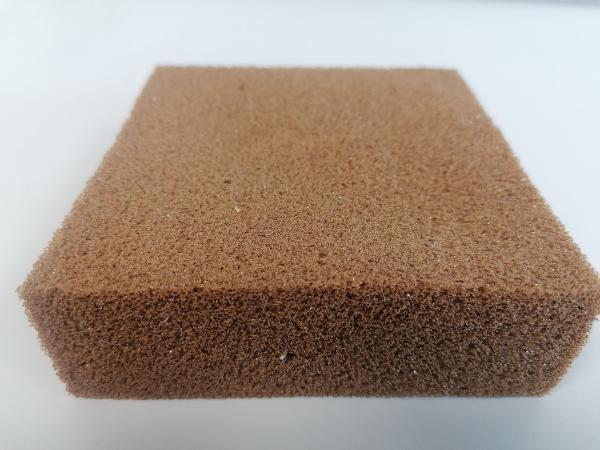
Utilising lignin as a raw material: Making furniture lighter, more modular and recyclable
Funding duration:
Start
01.05.23
Today
26.06.25
End
30.04.26
The furniture industry is facing a double challenge: on the one hand, furniture must be flexible and modular in order to adapt to changing living situations. On the other hand, there is increasing pressure to use sustainable materials and close recycling loops. Although current lightweight construction concepts reduce weight, they are often made of composite materials that are difficult to recycle. A lot of furniture made from these materials ends up in bulky waste or thermal utilisation, as it is not possible to separate them by type.
At the same time, lignin, a by-product of the pulp and paper industry, remains largely unutilised and is usually incinerated. However, lignin offers great potential for bio-based materials due to its high carbon binding capacity and specific material properties.
This is where the LignoLight research project comes in. The project team wants to develop modular lightweight furniture made from lignin-based materials. The aim is to utilise thermoplastic lignin compounds, lignin foams and a completely bio-based imitation leather for furniture construction. These materials should not only enable long-term CO₂ sequestration, but also reduce transport emissions thanks to their low weight. A modular construction extends the service life of the furniture, as damaged or obsolete components can be replaced in a targeted manner.
The project team also wants to optimise recyclability: The materials should be able to be separated by type and reprocessed for new products. At the same time, the researchers are investigating the potential for transfer to the fashion and caravan industry.
The project team is developing various lignin materials with specific mechanical and processing properties: the researchers are optimising thermoplastic lignin compounds with a lignin content of at least 40 per cent for use in 3D printing, injection moulding, extrusion and thermoforming. They are also developing lignin foams in various degrees of hardness with lignin contents of up to 80 per cent for use as a core material for panel and upholstery structures. The team is also testing a 100 per cent bio-based lignin leather with a lignin content of over 70 per cent as an alternative to synthetic coatings.
At the same time, the researchers are developing design concepts that enable the disassembly and reuse of entire modules (design for recyclability). They want to use take-back systems to ensure that the materials are returned to the material cycle. The project team is testing the developed materials and designs in a modular cupboard system and a piece of seating furniture and checking these prototypes for their industrial scalability.

Resource-efficient systems: developing sustainable circuit-breakers and electric motors
Funding duration:
Start
01.01.21
End
31.03.24
High-performance energy transmission and conversion systems are essential to mastering the energy transition. These include electrical circuit breakers and motors, for example, which rely on critical raw materials such as neodymium and dysprosium, as well as many metals such as copper. Currently, these materials are often insufficiently recycled, which increases dependence on raw materials from third countries.
At the same time, linear production processes are reaching their ecological limits. The industry urgently needs solutions to increase the efficiency of electrical systems, reduce resource consumption and orientate products towards a circular economy. Lightweight construction offers enormous potential here by enabling resource-saving use of materials and integrating innovative recycling concepts.
The LiKE research project aims to make key components of energy and drive technology more sustainable. Using the example of a circuit breaker and an electric motor, the project team wants to investigate how the use of materials and CO₂ emissions can be reduced without compromising technical performance. The researchers want to reduce material consumption by 20 per cent and increase the efficiency of the components by 10 per cent.
In addition, the project team wants to introduce new labelling technologies and recycling approaches to enable a closed-loop material economy. The project team also wants to develop a digital process that determines the environmental impact of design measures during the development phase. The project is thus setting new standards for sustainable product development and the transformation of the energy industry.
Firstly, the researchers added ecological criteria to existing product development and manufacturing processes. Novel labelling technologies with fluorescent markers made it possible to clearly identify materials and components throughout their entire life cycle and to sort them by type at the end of their life cycle. The team also linked this labelling with a digital product passport, which provides important information such as material properties for recycling.
The scientists used additive manufacturing methods such as cold gas spraying to produce multi-material compounds that combine mechanical stability with excellent separability for unmixed disassembly. At the same time, the team improved the development processes with optimised life cycle analyses. With this interdisciplinary approach, LiKE was able to show how resources can be saved, components can be designed more efficiently and the recyclability of products can be significantly improved.

Advancing lightweight construction in shipping: Expansion of the MariLight network
Funding duration:
Start
01.07.21
End
31.12.24
The maritime industry can make a decisive contribution to reducing CO₂ emissions. Lightweight construction - alongside alternative propulsion systems and new fuels - is a key lever for this. Innovative lightweight construction technologies enable shipbuilders to compete in the upper price segment of the market with highly complex special ships.
Thanks to lightweight construction, shipowners can reduce the draught of their ships or increase the payload so that the ships are better utilized. On the one hand, strengthening maritime lightweight construction makes the national industry competitive. On the other hand, innovative lightweight construction technologies can improve the climate and environmental balance of maritime transport.
The Center of Maritime Technologies has founded the national maritime lightweight construction network MariLight.Net in order to exploit the potential of lightweight construction in the maritime sector and bring the technology into widespread industrial application. The aim is to further intensify the exchange of knowledge within the industry and facilitate cross-industry technology transfer. This is because the maritime industry is extremely heterogeneous: it manufactures various product sizes and types using different materials. This means that everything is involved, from small pleasure craft to cruise ships, from series products to special ships, and from steel to fiber-reinforced plastics (composites).
In the MariLightCluster project, CMT is further developing the MariLight network. The focus is on technology development and transfer. MariLightCluster supports the participating companies and institutions in establishing strategic cooperations and thus promoting innovations in maritime lightweight construction.
MariLight supports companies in implementing lightweight construction applications, strengthening their competitiveness thanks to innovative unique selling points and utilizing the potential of lightweight construction to achieve emission savings.
The team is developing a roadmap that demonstrates the potential of maritime lightweight construction for more sustainable shipping. The roadmap takes up the state of the art and identifies gaps in knowledge and the need for action, such as necessary research projects or regulatory adjustments.
At the same time, MariLight is driving forward the development of international regulations that can simplify the widespread use of innovative lightweight materials. This is done, for example, through involvement in committees of the International Maritime Organization (IMO) and the Strategy Advisory Council of the German government's Lightweight Construction Initiative.
At the same time, MariLightCluster provides a platform for a regular cross-industry exchange of knowledge and experience. The team organizes specialist events to promote technology transfer with other industrial sectors such as aviation, rail vehicle construction and construction.

Light and precise magnesium components: Efficient production with semi-fluid processing
Funding duration:
Start
01.11.21
End
30.06.24
The mobility industries in particular require ever lighter yet stable components in order to reduce energy consumption and emissions. Magnesium, one of the lightest structural metals, offers good properties for lightweight construction due to its high strength and recyclability. However, the processing of magnesium places high demands on production technologies, especially for complex component geometries. This is where the MAXImolding project comes in, focusing on the development of new semi-fluid injection moulding processes for magnesium.
The project team is developing an innovative injection moulding process specifically for the precise and resource-saving processing of magnesium. The aim is to develop a process to produce magnesium components more efficiently using simplified machine technology. To facilitate the introduction of the technology into production, the new concept for melt preparation can be used to convert existing production lines to the processing of magnesium with minimal effort. The researchers want to reduce material consumption by up to 50 per cent compared to die casting and significantly reduce energy requirements in the manufacturing process. At the same time, they are optimising cycle times, which play a key role in series production, in order to reduce costs and increase competitiveness. This approach should make it possible to increase the sustainability and competitiveness of the production of magnesium precision lightweight components.
The project team first analyses the mechanical and thermal properties of the magnesium pre-material (AZ91, granulate/chips) in order to optimise semi-fluid processing without shearing by a screw. The researchers then design a metal injection moulding machine that is tailored to these special requirements. The machine concept combines elements from energy-efficient production technologies in order to produce near-net-shape components with high precision and minimise energy consumption. For the design and optimisation of the energy balance, the scientists are developing models for the manufacturing process and carrying out simulations to identify potential challenges as early as the development phase. They use prototypes to test the process under real-life conditions. The team then transfers the technologies into practice. Among other things, the participants are targeting applications in electromobility and other areas with high weight and stability requirements.

Reducing resource consumption by 80 per cent: production of lightweight structures
Funding duration:
Start
01.12.20
End
30.11.24
In order to drive forward the transition to a climate-neutral industry, new technologies and processes must be quickly put into practice - including in lightweight construction. This is where the National Lightweight Engineering Validation Centre (LEIV) at the Technical University of Dresden comes in. The project is making a significant contribution to accelerating the transfer from research to the real economy.
To this end, the LEIV is organised as an independent and open research platform with around 1,500 square metres of test space. In addition to large companies and original equipment manufacturers, small and medium-sized enterprises (SMEs) in particular also benefit from the opportunity to realise demonstrations on an industrial scale. This can significantly accelerate the practical transfer of research results. The start-up funding for the centre is based on the TTP LB-funded METEOR project.
METEOR is the first in a series of research projects, the results of which are intended to help reduce CO₂ in the production of sustainable lightweight structures. The aim is to reduce resource consumption in the production of high-performance lightweight structures by 80 per cent in real terms by 2030 and to create a largely environmentally neutral production network. To this end, material cycles are to be established and an end-to-end virtual process chain, the continuous balancing of resource efficiency and the consistent use of renewable energies within the process network are to be implemented.
Initially, the development and construction of a solar thermal mould heating and cooling system and the establishment of a temperature control cascade will form the infrastructural basis for the LEIV. The researchers are using the process chain of light metal die casting, plastic injection moulding and mechanical joining, which is relevant for lightweight system construction, to demonstrate the saving CO₂ potential that can already be realised.
The project partners are demonstrating new approaches to validate and optimise the efficiency of lightweight structures - for example in solar-assisted temperature control, the inline simulation of production processes or the robot-assisted joining of composite structures. They are developing the process chain for manufacturing a hybrid structure into a linked process network - with intelligently controlled process management and coordinated technologies. In doing so, the team collects extensive data and thus enables an improved assessment of resource efficiency in order to quantify potential CO₂ savings and demonstrate the value of modern process networks.
One result of the project is a new market-ready installation tool that installs threaded inserts in a process-monitored manner. During the entire assembly process, sensors on the nose piece monitor the correct installation of the HELICOIL thread insert. In addition, the angle of rotation and torquecontrolled installation enables the thread insert to be inserted to a precise depth.
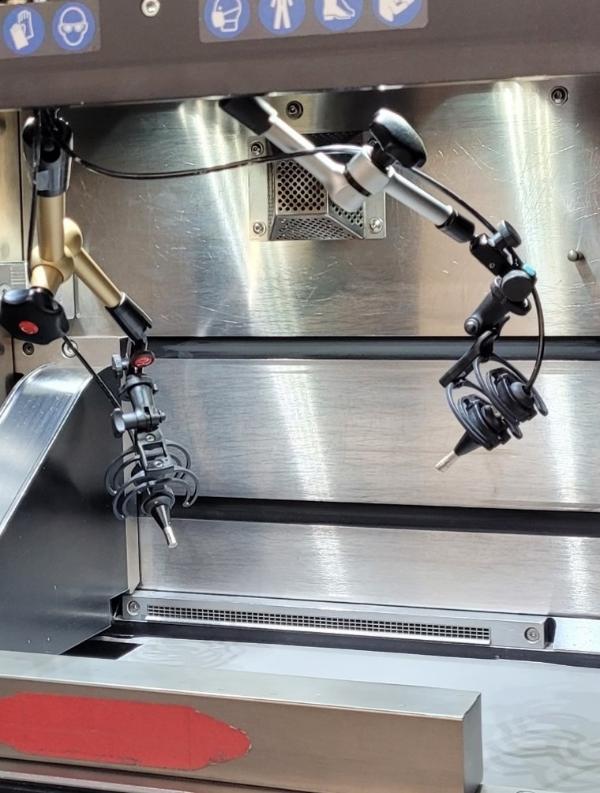
Optimising additive manufacturing: Quality assurance with acoustic analysis and AI
Funding duration:
Start
01.11.21
End
31.10.24
In the automotive and aerospace industries in particular, there is a growing demand for components that are stable but as light as possible. Additive manufacturing processes such as laser beam melting in a powder bed (PBF-LB/M) enable complex and weight-optimised structures that would not be possible using conventional methods. However, quality assurance poses a major challenge: During the melting process, defects such as pores, cracks or distortion can occur, jeopardising component stability. Existing optical monitoring systems often provide unreliable data, as the melting process is influenced by significant changes in temperature and material. An alternative, promising method is to analyse the process acoustically. Researchers in the ML-S-LeAF project are investigating how acoustic signals can be used to detect defects at an early stage and ensure the quality of lightweight components in additive manufacturing.
The project team is developing an intelligent, acoustics-based monitoring system for laser beam melting. The researchers are analysing the sounds generated during the process in order to identify defects in real time. Using machine learning methods, they want to assign characteristic sound patterns to specific defect types.
The team is focussing in particular on the use of virtual data: Numerical simulations are used to generate artificial acoustic signals in order to train the algorithms in a targeted manner. This enables the system to reliably recognise even rare defects without the need for extensive physical test series. In the long term, the system should reduce rejects and stabilise production processes.
The project team integrates highly sensitive microphones into a PBF-LB/M system and systematically records the resulting process noise. At the same time, the researchers are developing numerical simulations that reproduce the acoustic signals of typical error cases. The recorded and simulated data serve as input data for machine learning processes that can recognise even the smallest deviations in the melting process. Through continuous testing, the scientists refine the algorithms and integrate them into the process control system. Finally, validation takes place: the researchers test the system on real components and check whether it reliably recognises errors and improves the quality of production. The aim is to develop a robust and practical solution that will increase the efficiency of additive manufacturing in the long term.

Multi-material design for lightweight components: Fibre composite replaces light metals
Funding duration:
Start
01.12.21
Today
26.06.25
End
30.11.25
Conventional vehicle structures are often made of light metals such as aluminium and magnesium. These materials require large amounts of energy to manufacture and can cause significant CO₂ emissions. In addition, the combination of different materials leads to contamination, which prevents efficient recovery in the recycling process. The automotive industry is therefore faced with the challenge of developing stable and efficient components. Hybrid concepts offer a solution here.
An innovative approach combines thermoplastic, fibre-reinforced hollow profiles - lightweight, dimensionally stable components made of plastics - with organic sheets - a special semi-finished product in which plastic and reinforcing fibres are already combined - and thermoplastic injection moulding processes. The use of just one material system, such as glass fibre-reinforced polypropylene (GF/PP), simplifies the recycling process while still allowing a high degree of design freedom. By dispensing with chemical bonding agents and using modern laser surface structuring, a clean separation of the materials is achieved.
In the MM4R research project, the project team wants to replace magnesium-based vehicle components - such as the cockpit cross member - with hybrid fibre composite hollow profiles. This changeover reduces energy consumption and offers the opportunity to significantly reduce the global warming potential (GWP).
At the same time, the researchers are aiming to optimise the entire production process. They are raising individual production technologies from an early stage of development to series production readiness. They are already integrating a comprehensive life cycle assessment (LCSA) in the concept phase in order to take ecological, economic and social criteria into account. The result should ensure economically viable, waste-free production and sustainable utilisation of the resources used.
The project team is specifically optimising the individual production steps. The researchers are accelerating preforming - a preforming process in which raw materials are moulded into the later component geometry - by a factor of 10 in order to significantly reduce throughput times. They then improve consolidation in order to join thermoplastic FRP hollow profiles with metallic functional elements in an energy-saving manner. In this step, the preformed fibre-reinforced plastics to be brought into their final shape are hybridised with laser-structured metallic functional elements in order to generate both an efficient production process and a high-performance hybrid structure.
Instead of using chemical bonding agents, the team relies on permanent laser surface structuring to ensure a contamination-free bond. At the same time, the researchers recycle the resulting waste directly in the injection moulding process. At the same time, they are developing model-based methods for life cycle assessment in order to identify environmental impacts, costs and social risks at an early stage. An interdisciplinary approach that should pave the way for large-scale production.

Efficient lightweight vehicle construction: modular production of large components
Funding duration:
Start
01.11.20
End
30.06.23
Lightweight construction and sustainability are key issues in vehicle construction in order to increase material and energy efficiency and reduce CO₂ emissions. Non-linear structures - inspired by natural models - offer promising opportunities to develop lighter and more stable components. However, manufacturing processes such as 3D printing have their limits here: Insufficient production speeds, a lack of approvals and process-related post-processing costs have so far prevented large-scale use. This is where the MobiXL project comes in.
The aim of the researchers is to develop a new process with which bionically optimised large components for vehicle production can be produced efficiently, cost-effectively and sustainably. The team aims to achieve a weight reduction of 15 to 20 per cent in stiffening structures compared to current designs. These savings not only reduce material consumption, but also CO₂ emissions over the entire life cycle of a vehicle. The scientists are focusing on transferring the advantages of topology-optimised designs to large-scale production. To do this, they break down the complex structures into modular elements that are automatically manufactured and laser-welded. The complete digitalisation of the processes should also reduce production time by up to 80 percent and enable broader industrial application, for example in aviation or shipbuilding. The project team is demonstrating the practicality of the technology by producing two industry-specific demonstrators for rail vehicle and shipbuilding.
The project team is developing a new design principle that modularises topology-optimised structures. Instead of large linear individual parts, the researchers are using smaller, easy-to-manufacture modules that can be joined to form non-linear structures. The researchers integrate state-of-the-art laser welding technologies and intelligent control systems to efficiently organise the joining process of the modules. Finally, the researchers demonstrate the suitability of the process for series production using a tensile side wall segment and a shipbuilding panel. The successful patent application also confirms the novelty of the process. Despite the progress made, there is still a need for further research, particularly in terms of optimising the interactions identified between the modules and the overall component under load.
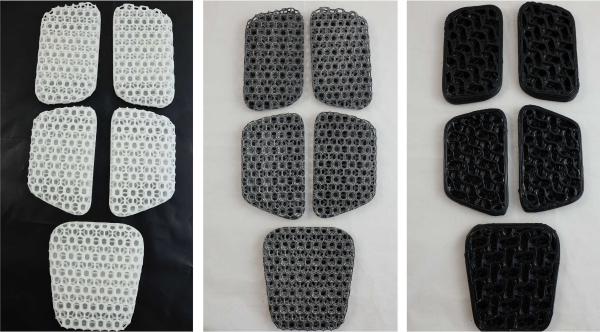
Recycling plastics: pioneering cascade model for 3D printing in lightweight construction
Funding duration:
Start
01.01.22
End
31.12.24
Additive manufacturing enables companies to produce high-quality everyday products, some with complex functions, from a single material in a short space of time. This allows them to significantly reduce material and energy consumption compared to conventional processes. However, the reuse of the materials used to create new raw materials is still unresolved in 3D printing. For the design, manufacture and recycling of these products, the project team has developed a cascade model that interlinks medicine, sport and lifestyle. This combines powder bed-based additive manufacturing, extrusion-based additive manufacturing and conventional injection moulding.
The researchers' aim is to recycle the materials used in additive manufacturing processes as completely and repeatedly as possible so that they become part of a cross-industry ecological circular economy. The scientists are focussing on polymers, i.e. plastics, and their application in medical, sports and lifestyle products. These include, for example, midsoles for running shoes, rucksack pads, shin guards and prostheses. These products must be customised to individual requirements so that they contribute to an improved quality of life in everyday life.
The researchers are also using demonstrators to calculate how many greenhouse gas emissions can be saved thanks to the cascade model developed. For this forecast, the project team is not only looking at the respective materials and production processes, but also at recycling and the ecological impact, such as by-products and waste.
The cascade begins with the additive manufacturing of products that need to be of outstanding quality for individualised applications in medicine. The researchers use the powder bed-based processes of laser sintering, multi-jet fusion and high-speed sintering for this purpose. If the products can no longer be used, the material is recycled: depending on its condition, it is processed again in the powder bed or goes on to material extrusion. This can result in products for sports or lifestyle - i.e. areas in which qualitative requirements for material properties are easier to fulfil. In this process, the plastic can be reused until it has finally worn out. It is then available for injection moulding in mass production.

Resource conservation and efficiency: multifunctional lightweight vehicle centre console
Funding duration:
Start
01.09.21
End
31.08.24
In many applications in the mobility sector, the aim is to combine lower weight with the same or increased functionality. In addition, sustainability issues are becoming increasingly important against the backdrop of increasing environmental and climate pollution. Sustainable lightweight construction technologies can make a decisive contribution to the resource, energy and transport transition with innovative solutions.
In the NaMiKoSmart project, researchers are developing a weight-reduced and multifunctional vehicle centre console that combines economic potential, climate protection and resource efficiency. To this end, they are combining various innovative lightweight construction technologies. The aim is to use the component as an example to demonstrate the possibilities for cross-industry utilisation of sustainable materials and production-ready process technologies. The research results should contribute to effectively reducing the weight of components in various industrial sectors without restricting functionalities.
The project team aims to demonstrate how sustainable natural fibres and the innovative space-winding process, "xFK in 3D", can be used to produce lightweight yet high-strength and rigid truss structures with minimal waste. In addition to high resource efficiency due to the reduced waste of the composite material - of a maximum of one per cent - large amounts of CO2 are to be saved throughout the entire life cycle of the bio-based, completely recyclable material. The project partners also want to integrate various additional functions with "Smart Textiles".
With "xFK in 3D", the researchers are using a cost-effective and flexible fibre composite technology for the three-dimensional winding of various fibre materials such as nylon, carbon, glass or basalt fibres. The hybrid or multi-material approach is characterised by a digital process chain that is being continuously developed. The fibre-reinforced plastics are wound based on calculations and simulations and can be specifically placed in the direction of the force and load paths. This allows the researchers to significantly reduce material and energy consumption and cut CO₂ emissions.
The scientists are also focussing on the use of smart textiles. Linking these functional fabrics with "xFK in 3D" not only enables significant weight savings, but also the integration of new design elements, haptics, heating functions, sensors and lighting options.
When selecting materials and production processes, the project team relies on comprehensive analyses, such as the "Sustainability Value Analysis". This management tool is used to identify and evaluate ecological and economic sustainability criteria at an early stage. In this way, weak points in the process chain are recognised at an early stage with regard to their ecological and economic sustainability aspects and can be taken into account during development.
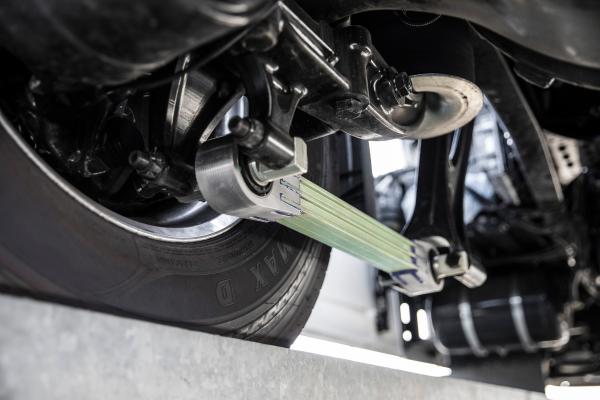
Producing hybrid lightweight structures: automated process chain with quality assurance
Funding duration:
Start
01.04.21
End
30.09.24
Lightweight construction plays an important role in increasing the efficiency of vehicles. It enables a higher payload and offsets the additional weight through electric drives and energy storage. At the same time, it helps to conserve resources - whether through lower material consumption, more efficient production, longer use or better recycling.
Metallic materials such as steel still dominate in vehicle construction, but their high strength is accompanied by considerable weight. Alternative lightweight construction solutions have so far only been used to a limited extent due to high costs or technical hurdles. This is where the NeLiPro project, short for Next Level Lightweight Production, comes in.
The researchers are investigating ways to produce hybrid fibre composite components that are lighter and whose highly stressed components can also be manufactured in large quantities in a resource-efficient manner - while at the same time offering a wide range of variants. With a modular system, the range of applications for fibre composite lightweight construction is to be extended to various applications, particularly in commercial vehicles and rail transport. Through energy-efficient manufacturing processes that consume up to 80 per cent less energy and by reducing the weight of the vehicles, the researchers want to significantly reduce CO₂ emissions - both in production and during use. Digital methods for process monitoring and quality assurance should also ensure the scalability of production. Furthermore, recycling strategies are to be developed to make lightweight construction economically and ecologically viable in the long term.
The researchers are developing and validating an integrated production chain for lightweight components. A key innovation is the automated production of fibre composite components, which are connected to metallic load introduction structures. New manufacturing and joining processes ensure precise and highly resilient connections of the components, while digital methods for error detection and data management further optimise the process chain. For process-integrated quality assurance, the researchers use, among other things, an inline microwave inspection system that enables the early detection of quality deviations during the production of the fibre composite structure. The researchers integrate recycling strategies at an early stage in order to minimise waste and facilitate recycling. Finally, the scientists are evaluating the environmental sustainability of the new processes and products through a comprehensive life cycle analysis.

Carbon tension members for bridges: Sustainable and economically efficient construction
Funding duration:
Start
01.07.21
End
31.12.24
Network arch bridges with innovative carbon fibre tension members allow for a slim, CO₂-efficient and economically advantageous design. This makes them particularly suitable for bridges with medium and large spans, including railway bridges subject to high loads from heavy goods traffic. Carbon tension members offer significantly higher strength and a longer service life under fatigue loading than steel tension members. The carbon fibre design enables much thinner cross-sections for the tension members. In addition, the lower modulus of elasticity of the carbon fibres reduces local load concentrations and allows savings to be made on the overall structure through the use of a lighter deck slab.
The high-performance fibres used fundamentally change the load-bearing behaviour of the system. For this reason, questions regarding load-bearing behaviour, actual fatigue resistance and equivalence under fire exposure still need to be investigated and the findings standardised in a further step.
The aim of the NeZuCa research project is to establish carbon tension members as a technically recognised alternative to steel tension members in network arch bridges. The project team is carrying out extensive fatigue tests to determine the load-bearing behaviour and fatigue strength in a generally valid manner.
The extensive fatigue tests on various cross-sections are intended to lay the foundations for a general technical approval or a product release by DB InfraGo for this construction method. To date, bridges with carbon tension members can only be used with approval in individual cases.
The innovative construction method with carbon hangers offers enormous potential for the construction of bridges with large spans. A current example of realisation with approval in individual cases is the railway bridge over the Oder near Küstrin, which will be completed in 2024 (German Bridge Construction Award 2025). NeZuCa project partners were directly involved here. The savings potential in the overall structure also results in advantages in terms of the carbon footprint.
The project team includes representatives from research institutions, operators, clients and planners. In the test halls of the participating research partners, investigations are carried out on various cross-sections under static and dynamic loads and the behaviour of the carbon tension members is analysed until failure in order to derive a failure function for the fatigue resistance. The researchers are investigating the behaviour under increased load conditions in the low frequency range. The investigations are rounded off with component fire tests in special test rigs to evaluate the behaviour of the carbon components under fire load in comparison to classic steel tension members.
The project team uses the data obtained directly to develop standardised calculation models and design rules. These findings will help to establish the use of carbon tension members as a generally recognised solution for bridge construction projects in the railway sector. There is also considerable potential for future application on road bridges and in the renovation of bridges.

Selective laser beam melting: Optimising heat distribution and reducing stresses
Funding duration:
Start
01.12.21
End
30.11.24
Selective laser melting (SLM) is a key technology for lightweight construction, as it enables the production of complex, load-optimised components. In this process, metal powder is melted layer by layer with a laser to produce high-strength structures. A key problem with this process is residual stresses caused by uneven heat input. These stresses can lead to component distortion or microcracks and have a negative impact on the mechanical properties.
However, safety-critical applications, such as in the aerospace and automotive industries, require precisely manufactured, resilient components. In addition, process control has so far often been carried out without detailed adaptation to the respective component geometry or load. Standardised exposure strategies such as parallel scan paths or checkerboard patterns do not take into account how heat is distributed in the component. This results in stress maxima that lead to quality defects. Adaptive process control is required to control the mechanical properties of additively manufactured components in a targeted manner and to make the use of materials more efficient.
In the Opti-Add research project, the project team aims to reduce the residual stresses in the SLM process through an optimised exposure strategy and specifically adapt the component properties. To this end, the researchers are developing an intelligent control system that adapts the process parameters - in particular laser power, scanning speed and scanning strategy - to the geometry and thermal situation of the component. In this way, the scientists hope to reduce component distortion, minimise susceptibility to cracking and improve fatigue strength. This is particularly important for lightweight structures that are exposed to high dynamic loads.
The project team also wants to use targeted heat control to influence the microstructure of the materials so that they last longer. The researchers also want to increase resource efficiency: By controlling the melting bath more precisely, material consumption should be lowered and waste reduced.
In order to improve process control, the researchers are developing a build processor that optimises the exposure strategy based on the component geometry and thermal simulations. Using temperature field analyses, they identify critical areas where stresses are particularly high. Based on this, the project team is testing alternative scanning strategies such as the pilgrim step method, in which the laser varies the exposure sequence so that heat is distributed more evenly. The researchers are also using a thermographic detector system that records the temperature curves during the printing process in real time.
This data is fed into the build processor for path planning in order to specifically adjust the laser power and scan patterns. After production, the researchers analyse the components using methods for residual stress analysis and optical distortion measurement. These show that the checkerboard pattern scanning strategy results in less warpage in direct comparison to linear scanning strategies, but that the residual stresses are influenced more by the temperature of the build platform, the laser power and the laser speed than by the scanning strategy. The residual stresses decrease with increasing temperature of the build platform and increase with increasing laser power and laser speed.

Magnesium materials: Enabling forming with nanoparticles
Funding duration:
Start
01.02.22
End
31.12.24
Magnesium has the lowest density of all metallic construction materials and therefore has great potential for lightweight construction. Its modulus of elasticity, i.e. the ratio of stiffness to weight, is significantly higher than that of other lightweight metals such as aluminium. This makes magnesium particularly suitable for applications in the automotive and aerospace industries, where every kilogramme of weight counts.
Nevertheless, its use has so far been limited: Conventional magnesium alloys can hardly be formed, as their hexagonal lattice structure only allows low ductility - i.e. plastic deformability. Formable variants have not yet achieved the required strength and have poor processing properties. This prevents manufacturers from using magnesium in load-bearing lightweight components. The researchers in the OptUm-MagNa project want to change this.
The project team wants to qualify magnesium alloys for forming technology - i.e. not just casting, but also forging or extruding (extrusion). The researchers are using so-called nanocomposites for this purpose: They add ceramic nanoparticles in the size range below 100 nanometres to the magnesium. These particles cause extreme grain refinement in the structure of the metal. This increases strength, improves ductility and significantly increases formability.
The result is a material that for the first time offers a combination of low weight, high strength and good formability. In addition, flammability is reduced - an important aspect especially for aviation. Instead of using expensive and critical rare earths, the scientists use calcium or calcium oxide as an alloy additive to reduce the fire behaviour to the level of molten aluminium.
Firstly, the researchers investigate the optimum composition of the nanocomposite. They vary the particle size and concentration and analyse their influence on the microstructure and mechanical properties. The moulded semi-finished product is then forged, extruded or extruded in the laboratory. In microstructure analyses during the forming process, the team determines the relationships between forming parameters, grain structure and component properties. The aim is to specifically adjust the material properties via the forming conditions.
At the same time, the researchers are developing processes to enable the material to be processed under real industrial conditions - in an energy-efficient and resource-saving manner. Finally, they are comparing prototype components made from the new magnesium nanocomposite with conventional aluminium parts. The focus here is on weight, rigidity, strength and flammability. Finally, an economic assessment will show the potential for industrial applications - including beyond mobility, for example in medical technology.

Air-coupled ultrasonic testing: damage-free and flexible testing of lightweight components
Funding duration:
Start
01.02.21
End
31.01.24
The safety inspection of lightweight components is a key challenge in the industry. Current methods use liquid coupling agents such as water to transmit ultrasonic waves into the components. However, these agents have negative effects: They can damage sensitive materials such as honeycomb core structures or foams, increase maintenance costs and make it difficult to inspect complex geometries, especially for components with one-sided access.
Conventional air-coupled ultrasonic methods are technically limited: Single-channel systems do not allow precise control of the sound field and are unsuitable for complex applications. The PALUP project specifically addresses these weaknesses. The team developed an innovative testing technology that does not require any coupling agents at all, yet offers maximum testing accuracy and can be flexibly applied to different component geometries.
With PALUP, the project team is pursuing the goal of developing a demonstrator for an air-coupled phased array system that works entirely without coupling agents. With this technology, sound fields can be electronically focussed, swivelled and scanned. This opens up new possibilities for testing complex geometries and areas that are difficult to access.
The researchers want to create a solution that not only overcomes the existing limitations of air-coupled ultrasound technology, but also transfers the precision and flexibility of phased array technology to a non-contact method. In the long term, this innovation should make lightweight construction applications safer and more sustainable, particularly in safety-critical areas such as aerospace or the automotive industry.
The researchers are combining their expertise in sensor development and test device integration to develop a demonstrator with innovative airborne ultrasonic sensors. They are using cellular polypropylene, a material with piezoelectric properties that requires no matching layers and is ideal for the transmission of ultrasonic waves in air. The sensors are designed as phased arrays to enable precise electronic control of the sound fields.
At the same time, the team is developing multi-channel transmitter and receiver electronics as well as specialised software for data acquisition. With this system, the researchers can carry out tests without mechanical movement or coupling devices. The result is a pioneering technology that enables flexible, precise and safe non-destructive testing of lightweight components and creates the basis for a broad industrial application.

Faster, cheaper and more sustainable: modular bridge construction with carbon concrete
Funding duration:
Start
01.08.21
End
30.04.24
Around 7,400 bridges on German motorways and federal roads are part of the BMDV's modernisation network and are to be renovated or replaced by 2030. To minimise disruption to traffic, short construction times are essential. Modular construction with non-metallic reinforcement offers an innovative solution here: the various components for the bridge are completely prefabricated in the factory, delivered to the construction site and then connected on site.
The advantages of modular bridge construction with non-metallic reinforcement are manifold: industrially manufactured components are more precise and slimmer. In combination with corrosion-resistant reinforcement, this saves concrete and emits less CO₂ during production and transport. The scope and size of construction sites as well as the construction time on site - and thus congestion times caused by construction - can be significantly reduced. As the pollutant emissions of a construction project correlate directly with the construction time, the impact on the climate and environment is further reduced.
As the connection of the individual modules is designed to be reversible, they can be replaced or removed in the event of damage without having to completely rebuild the structure. When dismantling, the individual elements could be reused or recycled more easily in future to make the entire life cycle more sustainable.
In an international comparison, modular construction methods are not yet very widespread in Germany. This is less due to its feasibility than to the narrowly defined standardisation. The project team is therefore developing and testing a pilot system. The researchers are building the prototype for a road bridge on a true-to-original one-to-one scale and are liaising closely with the approval authorities.
The findings from bridge construction can be transferred to many sectors of the construction industry - from building construction to the energy industry.
The researchers manufacture the prototype completely in the factory and then join the individual carbon concrete components together on the construction site. The project team wants to achieve this so-called joining by means of pre-stressed dry joints. This means that the prefabricated parts must be manufactured very precisely so that they fit together exactly and static friction is activated. This prevents the individual elements from sliding apart. The outstanding advantage is that the assembly time for the superstructure on the construction site can be reduced to just one working day. Afterwards, the structure is immediately fully load-bearing, as no in-situ concrete has to harden. - This extremely short construction time was demonstrated during the project.
The project partners from industry and science are testing the system under real conditions on a federal highway: they are integrating the bridge prototype into a temporary bypass at a bridge construction site near Freiberg in Saxony. They are exposing the system to the stress of real road traffic for around a year. On 19 September 2023, the structure was put into operation following a load test. With the accompanying metrological monitoring, they want to prove the reliability of the modular design and thus initiate normative adjustments. At the end of its service life, the project partners will examine the bridge in the laboratory and check whether it can be reused at another location.

Additive manufacturing of ceramic components: Digital twin optimises entire process chain
Funding duration:
Start
01.01.21
End
30.06.24
Fibre-reinforced ceramic composite materials (CMC) offer great potential for lightweight construction. They combine temperature resistance with high strength and are therefore particularly suitable for high-temperature applications, for example in turbines, heat exchangers or chemical plants. At the same time, the production of CMC is complex, processing is resource-intensive and quality assurance takes a lot of time. Finishing in particular accounts for up to 80 per cent of manufacturing costs. These hurdles have so far prevented the widespread use of these promising materials. This is where the ProDenker research project comes in.
The project team is developing an AI-supported process chain that optimises all steps from additive manufacturing to mechanical post-processing. The aim is to make production processes more efficient, flexible and sustainable. With the help of a digital twin, the researchers want to analyse process data in real time, detect deviations at an early stage and automatically adjust parameters. This approach should reduce material consumption, increase energy efficiency and improve component quality.
They are also working on environmentally friendly lubricants, innovative clamping techniques for vibration damping and simulation-based tools that speed up the machining process and make it more economical.
The researchers are developing the process chain step by step and testing their methods directly on demonstrators such as a turbine blade and a recuperator. They print blanks from highly filled materials and convert them into dense CMC components. During machining, they continuously analyse process data using AI algorithms in order to improve machining parameters and tool designs. Using specially developed clamping techniques, they minimise vibrations and increase machining quality. A central data platform connects all work steps and enables end-to-end quality assurance. The researchers are developing the process chain so flexibly that it can be transferred to other materials and sectors, such as the energy, chemical and automotive industries.
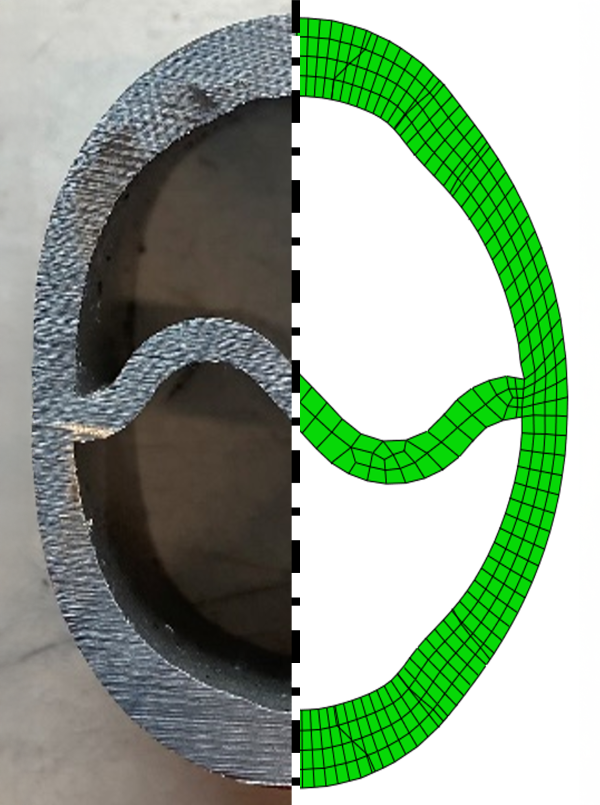
Innovative forming technology for vehicle parts: Flexible grading of aluminium profiles
Funding duration:
Start
01.04.21
End
31.10.24
Lightweight construction plays a key role in resource-saving mobility. Extruded aluminium profiles in particular are well established in vehicle and aircraft construction, as they combine high strength with low weight. To date, however, these profiles can only be monolithically customised in two dimensions - flexible modification along the longitudinal direction is not economically feasible with current processes. This leads to unnecessary material usage and requires costly reworking.
To overcome these limitations, the research team in the ProLeit project is developing a new type of grading technology that enables the profile geometry to be customised along the longitudinal axis.
The researchers want to transfer the newly developed grading technology from the laboratory to industrial practice. Their aim is to flexibly shape extruded profiles not only in cross-section, but also along the longitudinal direction. This means that material is only used where it is actually needed. This opens up new possibilities for lightweight construction that not only save material and costs, but also improve the CO₂ balance. Studies show: In the automotive industry, the process could open up lightweight construction potential of at least 25 per cent. The team is also researching how alternative geometries, such as oval, square and multi-chamber profiles and various materials, can be processed alongside classic round profiles in order to increase the range of applications and achieve further weight savings.
With the industrialisation of the process, the grading technology could also be used in other areas of lightweight construction - with applications far beyond mobility, for example in plant construction or the energy sector.
In order to transfer the technology to industrial applications, the project team is developing an innovative forming technology based on roll forming. The profiles pass through special rollers that change the cross-section in a targeted manner. One focus of the work is the transfer of roll forming to complex profile geometries, such as multi-chamber profiles. To this end, the forming process is first simulated using numerical methods and then validated experimentally using real, extruded profiles. The results show a high level of agreement between simulation and experiment.
The scientists are also investigating how different material properties affect the forming process and which process parameters need to be optimised in order to ensure stable and reproducible components.
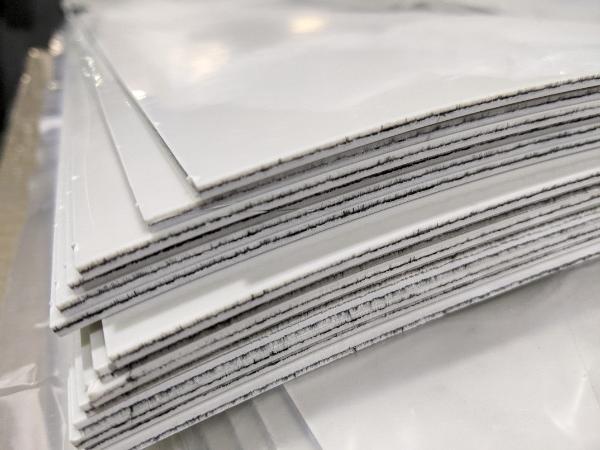
Sustainable thermoforming: Recycled fibres make lightweight components more efficient and stable
Funding duration:
Start
01.06.21
End
31.03.24
Thermoforming is an established process for the cost-effective production of large plastic components. It is used in the bus and railway industry, caravan construction and commercial vehicles, among others. However, the technology has limitations, as unreinforced plastics are often not sufficiently stable for more demanding applications.
Further development of the process is necessary in order to also process fibre-reinforced plastics and increase performance. An innovative approach has been developed here: Multilayer composite semi-finished products that contain recycled carbon fibres. This combination of materials offers promising potential for sustainable and high-performance components.
The ProMeTheuS project aims to sustainably reduce CO₂ emissions in the mobility sector. The project team is developing lightweight, stable and fully recyclable plastic components for mobile applications. The researchers not only want to use less material, but also utilise recyclable materials that can be recycled multiple times. They are developing recycled carbon fibre fleece for these multilayer composite semi-finished products.
ProMeTheuS is thus making a contribution to the circular economy by integrating recycled materials into high-quality applications and thus reducing the use of new resources. Through sustainable production processes, the project team also aims to significantly reduce CO₂ emissions during the manufacture of the components.
At the start of the project, the team analysed the specific requirements of the bus and rail transport, caravanning and agricultural machinery industries. After a long development process, the researchers are working on a universal semi-finished product that can fulfil the relevant requirements of the industries during further development. Although the new materials are characterised by high strength and rigidity, these are not sufficient to replace the metal structure of a seat. The material could be used as a simple cover without high strength requirements in the specified industries. A simple component geometry is essential for successful deep drawing.
An important component of the project is the use of carbon fibre nonwovens, which achieve a strong reinforcing effect. After a long process of developing the material formulation, the potential of this technology and the appropriate component application became apparent. The researchers are developing a prototype that could lead to a lightweight, stable and resource-saving seating system for public transport in the future that is also recyclable. Traditional components such as wall panels and moulded elements are also being evaluated with the new semi-finished products, which underlines the versatility and future viability of the technology.

Sustainable protective structures for electric cars: fibre-reinforced plastics replace aluminium
Funding duration:
Start
01.11.21
End
31.07.24
The requirements for vehicle construction are changing with the introduction of alternative drive systems such as battery and hydrogen technologies. Underbody structures in particular, which protect sensitive energy storage systems, must fulfil high safety standards and at the same time be designed to be more ecologically sustainable. Lightweight construction offers a decisive opportunity here to reduce weight and thus also energy consumption.
At the same time, the focus is on aspects such as the use of recycled and bio-based plastics and the development of efficient manufacturing processes. The aim is to develop components that enable better resource utilisation throughout the entire product life cycle and are suitable for series production.
In the protECOlight research project, the team is developing sustainable, fibre composite-based lightweight protective structures for cars with alternative drive systems. The aim is to replace aluminium, the dominant material to date, with fibre-reinforced plastics. These reduce the weight of the protective structures by up to 30 per cent, which directly increases energy efficiency in electric and hydrogen vehicles.
The researchers also want to use recycled polypropylene and bio-based polyurethane to replace fossil resources. The components and processes developed should not only offer ecological advantages, but also fulfil the requirements of series production and cost efficiency in order to enable broad industrial application.
The project team is pursuing two approaches, tailored to different vehicle segments and volume scenarios. The researchers are developing a polyurethane sandwich structure for vehicles with a low number of units over their service life, e.g. the sports car segment. This consists of a long glass fibre-reinforced polyurethane foam core and cover layers made of continuous fibre-reinforced plastic. The innovative, single-stage manufacturing process saves material and energy.
For vehicle projects with a large production volume and a corresponding need for automation, the team relies on a different solution: here it combines glass fibre-reinforced polypropylene tapes with long fibre-reinforced thermoplastic moulding compounds to enable cost-efficient weight savings.
Alongside the material and process engineering developments, the researchers are carrying out a comprehensive life cycle analysis - from material selection to the near-series demonstrator. This enables them to make a sound assessment of the ecological and economic potential of the components. Innovative simulation methods also ensure the transferability of the solutions to industrial production.
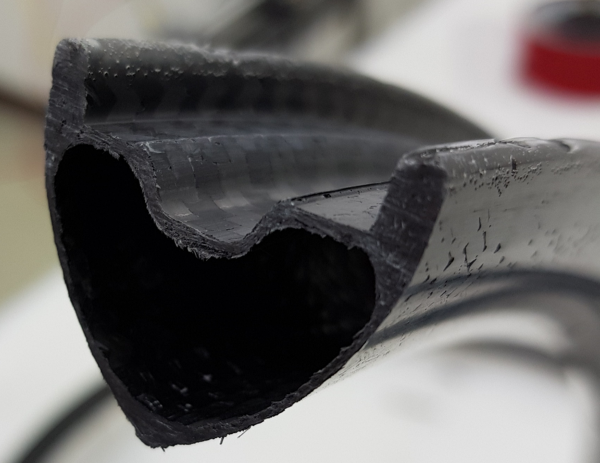
Developing lightweight and safe CFRP rims: damage detection through integrated sensors
Funding duration:
Start
01.07.21
End
30.06.24
Lightweight construction is a key technology for making vehicles more efficient and sustainable. In the automotive sector, the demand for components that are both lightweight and resilient is constantly growing. Carbon fibre reinforced plastics (CFRP) offer great potential for this, as they enable a significant reduction in weight with high stability. However, the industry is faced with the challenge of producing CFRP economically and sustainably in series. So far, this has mainly failed due to high production costs, complex manufacturing processes and the limited use of sustainable materials.
This is precisely where the ProVeS project comes in: The project team is developing an improved process chain to produce CFRP rims with integrated failure sensors in a cost-efficient manner. The researchers are combining new production techniques with intelligent sensors in order to utilise materials in a more targeted manner and increase operational safety.
The researchers' main goal is to develop an industrially applicable process chain for the production of CFRP rims with integrated failure sensors. The aim is to detect damage such as delamination - i.e. the detachment of individual layers in material composites - or material fatigue at an early stage and make operation safer and more cost-efficient. In the future, the sensor technology should also enable integration into digital maintenance concepts (predictive maintenance).
The development of a vacuum-assisted tube blowing process - a special shaping process in which an inflatable core presses the CFRP material into the desired shape - and thermographic component testing are intended to ensure the quality of the rims and optimise the use of materials. This makes it possible to dispense with oversized safety reserves, which leads to a further reduction in weight and material.
At the same time, the team is working on automating processes such as the tube blowing process and making them suitable for series production. The aim is to reduce the use of materials and energy, minimise waste and ensure reproducible quality. The team wants to create the conditions for CFRP rims to transition from a niche solution to widespread use in vehicles of various categories - from bicycles and cars to leisure and sports applications.
First, the researchers analyse existing manufacturing processes for CFRP rims in order to identify weaknesses and potential for optimisation. Based on this, they are developing a vacuum-assisted tube blow moulding process that enables targeted material distribution and improved structural properties.
For structural monitoring, they define various use cases and derive the requirements for a sensor-monitored rim. Using simplified models and analyses with the finite element method (FEM) - a computer-aided process for simulating mechanical loads - they identify critical areas and optimise sensor positioning.
Carbon fibre sensors are used, which are first validated in coupon tests - i.e. standardised material tests on small samples - and then under real loads.
A specially developed thermographic testing method enables the non-destructive detection of defects. The knowledge gained flows into quality assurance and the preparation for series production.
Through this approach, the team develops practical solutions and ensures transferability to industrial practice as well as continuous improvement of the process chain.

Efficient design of elastomer components: Optimised material mixtures and production
Funding duration:
Start
01.06.21
End
30.09.24
The automotive industry uses lightweight construction technologies to reduce the CO2 footprint of vehicles. The use of new sustainable materials and increasing the resource efficiency of existing materials is becoming increasingly important. Elastomers are polymer materials with high elasticity that are used in components such as tyres, seals and vibration dampers.
Despite these properties, elastomer components are often over-dimensioned, as development has so far been heavily based on empirical approaches. This means that the potential for targeted optimisation remains untapped. For example, a lack of topology optimisation - a method for optimal material distribution based on mechanical loads - leads to unnecessarily high material usage. A comprehensive life cycle assessment (LCA), which assesses the carbon footprint of a product from manufacture to disposal, is also often lacking. This impairs the efficient use of resources.
The ReLEA research project aimed to reduce the weight of elastomer components while maintaining their mechanical properties. The researchers used innovative polymer materials, including CO2-based rubbers and high-molecular polymers, as well as advanced fillers such as functionalised and highly structured carbon blacks.
In addition to material efficiency, the researchers systematically investigated all process steps - from mixing to extrusion, injection moulding and vulcanisation. This enabled them to precisely harmonise material properties and production processes, which significantly reduces the use of resources and energy consumption. With these optimised formulations and manufacturing processes, the project team significantly reduced the CO2 footprint of the components.
The project team analysed all stages of the production chain in detail. In the laboratory, the researchers specifically tested new polymer-filler combinations and developed customised formulations. Using simulation-based topology optimisation, they adapted the component geometry so that the material is used exactly where it is mechanically required.
The team also used modern methods such as AI-supported process modelling and evolutionary optimisation approaches to precisely control the processes from material mixing to vulcanisation. A systematic life cycle assessment evaluated the energy and resource consumption over the entire life cycle. The validation was carried out on real components in order to establish practical and resource-efficient production methods.

Processing fibres efficiently: sustainable seating systems for vehicles
Funding duration:
Start
01.11.20
End
31.10.23
Continuous fibre-reinforced thermoplastic fibre composites are among the most innovative materials in lightweight construction. Their exceptional material properties, such as high strength and low weight, offer enormous potential for a climate-friendly industry. However, their industrial use has so far been limited, as high material costs and cutting rates make widespread use difficult. This means that considerable opportunities for conserving resources and reducing CO₂-emissions remain untapped.
The aim of RESOLVE is to overcome these hurdles through new technologies and optimised manufacturing processes. The researchers have optimised the fibre orientation of the continuous fibre-reinforced thermoplastic fibre composite materials so that they are ideally prefabricated for specific loads. Specifically, they have designed a modular seating system for trams to demonstrate the potential of these materials. These seats are particularly light, stable and resource-efficient. The project also aims to develop new bionic design approaches that can be used in various industries such as automotive, aviation and rail transport. This will enable a broad industrial application.
The researchers are using what is known as effiLOAD technology. This makes it possible to place fibre materials in a "roll-to-roll" process in such a way that they follow the load paths precisely. As a result, significantly less material is lost, while efficiency and product quality increase at the same time. The project team is further refining this technology and combining it with bionic principles. The focus is on a complete process chain, from the manufacture of semi-finished products to component production and quality assurance. The tram seat concept serves as an application example to demonstrate the potential of the technology in a real product.

Efficient laser beam melting: reduce material loss, enable reprocessing
Funding duration:
Start
01.12.21
End
30.11.24
Additive manufacturing offers companies new opportunities in lightweight construction. In the most widely used additive manufacturing process for metallic components, laser beam melting (LBM), components are created layer by layer from fine-grained metal powder. This allows complex, bio-inspired structures to be realised and components to be manufactured 40-60 percent lighter.
However, the entire LBM process chain, from the production of the metal powder to the post-processing of the additively manufactured components, is energy and material intensive. In addition, a significant proportion of the metal powder is produced as non-recyclable waste, which pollutes the environment and increases production costs. These technical and ecological challenges hinder the broad industrial utilisation of LBM, although the process offers enormous potential.
The RESULT research project is specifically addressing these challenges. The project team aims to improve the material efficiency of laser beam melting and significantly reduce material loss. To this end, the researchers are developing technical processes for recycling and reusing the cost-intensive metal powder. They are also developing guidelines for handling the metal powder and contaminated operating materials.
With these optimisations, the team not only aims to reduce production costs, but also energy consumption and climate-damaging emissions. The project thus contributes to the sustainable and economical use of additive manufacturing in lightweight construction.
The project team first analyses the entire laser beam melting process chain at various users in order to identify exactly where material losses and environmental pollution occur. On the basis of a detailed assessment - based on the waste hierarchy of the Closed Substance Cycle Waste Management Act - the researchers are developing technical prototypes for recycling the metal powder and for the environmentally friendly management of operating materials contaminated with metal powder.
A specially set up pilot plant simulates the real production process. The team then intends to make the data obtained and the best-practice solutions developed publicly available in order to promote cross-industry technology transfer and support sustainable optimisation in lightweight construction.
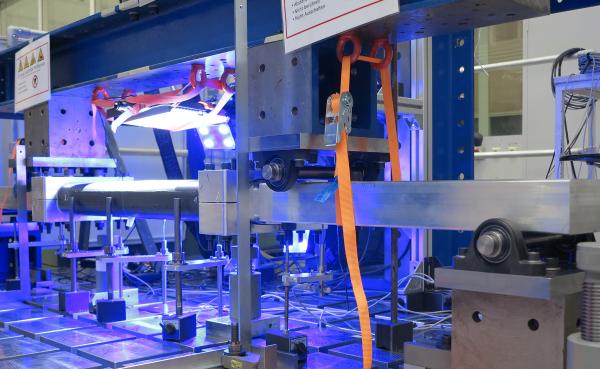
Reduce material scattering: precise analysis with 3D digital twin
Funding duration:
Start
01.12.20
End
31.05.24
Fibre composites such as carbon fibre plastics (CFRP) are indispensable for lightweight construction. They are used across all industries, particularly in aerospace and automotive engineering. Despite their outstanding properties, however, they exhibit a wide range of mechanical characteristics.
These fluctuations make it necessary to oversize components in order to guarantee safety. This not only increases the weight, but also the consumption of resources and CO₂ emissions - both during production and operation. Reducing these material variations is essential in order to fully utilise the lightweight construction potential and reduce the environmental impact.
This is precisely where the RICA research project comes in. The aim is to better understand the variation in material properties and reduce it. By precisely analysing influencing factors such as fibre angle, fibre volume content and degree of hardening, the project team aims to identify the causes of the variability.
With these findings, the researchers are developing digital tools to better predict the material properties. The aim is to make components lighter and more resource-efficient without compromising on safety. The use of digital twins should also ensure that these improvements can be applied over the entire service life of the products.
The project team combines advanced simulation methods with comprehensive material analysis. Using digital image correlation, the researchers record detailed strain and stress fields in three dimensions. This makes it possible to precisely determine the breaking strength, stiffness and elongation at break, even under complex loads. The analysis includes not only global material properties, but also local influences such as layer structure and micro-damage.
At the same time, the team is developing digital twins that realistically depict material behaviour. Virtual tests replace many physical tests, which means that fewer samples and resources are required. Thanks to these innovative approaches, the researchers can not only develop lighter components, but also set new standards for material testing and the simulation-based design of lightweight structures.

Electric drive rotors: reduce material usage, enable remanufacturing
Funding duration:
Start
01.11.21
End
30.11.24
The growing market for fully electric vehicles and increasing environmental regulations are presenting the automotive industry with new challenges. Manufacturers need to design electric drives that are more efficient and conserve resources. For non-stationary drives in particular, companies are striving for high power densities with maximum speeds of over 20,000 revolutions per minute and are focussing on lightweight materials. However, high speeds require very precise manufacturing techniques. In order to achieve these high speeds and counteract the associated high mechanical stresses, the components currently have to be joined together in some cases using bonding, screwing and thermal processes. These processes do not meet today's sustainability requirements as they are energy-intensive and stand in the way of effective repair, refurbish and recycling strategies.
Until now, many processes have relied on thermal joining techniques, in which components are joined using heat. However, this increases production waste. In addition, firmly bonded magnetic fasteners hinder the recycling of rare earths. Another critical point is the recycling of rotors. This is not possible with current manufacturing processes.
In the Roflex project, the project team aims to develop new concepts for the lightweight construction and remanufacturing of rotors for electric drives. The aim is to reduce the use of materials and enable repair, refurbish and recycling strategies. The researchers are designing a new type of rotor shaft produced using forming technology and a thin-walled balancing disc that serves as an integrated clamping mechanism.
The team is also developing flexible magnetic fixings with resilient behaviour. These innovations replace energy-intensive thermal joining processes, reduce the weight by up to 15 per cent and allow the reuse of rare earth magnets. The researchers are also testing two new measuring and testing methods that precisely record mechanical properties and thus ensure the quality and durability of the components.
The researchers begin with a detailed definition of requirements in which all manufacturing and operating parameters are specified. They develop the new components using modern forming techniques to produce lightweight, thin-walled rotor shafts and balancing discs. On a newly constructed test rig, the researchers test the components under real operating conditions, for example in spin and burst tests.
The scientists create digital twins that map the entire production process. Using artificial intelligence, they analyse the recorded data, identify sources of error at an early stage and thus optimise the production steps. This approach not only ensures the high quality of the new rotors, but also enables systematic reprocessing of the components.
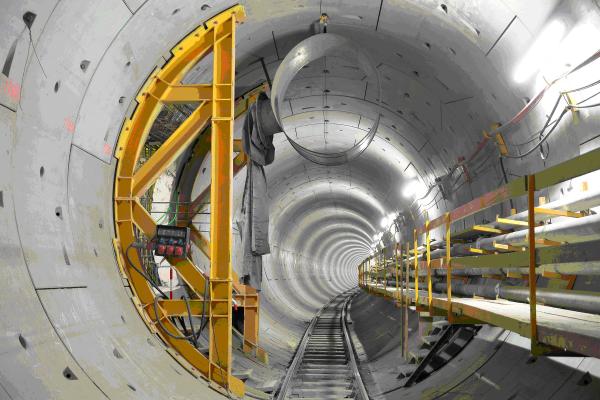
Sustainable tunnelling: reduce cement content, recycle excavated material
Funding duration:
Start
01.11.23
Today
26.06.25
End
31.10.26
Tunnelling requires enormous quantities of reinforced concrete. In particular, the production of the segments - the prefabricated concrete elements from which the tunnel tube is assembled - is resource-intensive. The main components are cement, steel and natural aggregates such as gravel and sand. These materials cause high CO₂ emissions and require large quantities of primary raw materials.
At the same time, machine tunnelling produces large quantities of excavated material in the form of rock and soil. This is often dumped instead of being recycled. A sustainable approach to tunnelling must therefore combine two aspects: CO₂-reduced concrete technology and efficient recycling of the excavated material.
In the RTTS research project, the project team is developing an innovative segment production technology that optimally combines material savings, recycling and load-bearing capacity. The researchers are reducing the cement content in the concrete by using alternative binders, such as lime-rich active substances, granulated blast furnace slag and pozzolanic substances, in order to achieve a comparable strength and durability of the material.
In addition, they integrate recycled aggregates into the concrete to reduce the use of primary raw materials. In order to optimise the CO₂ consumption of the entire tunnel support system, the team will also investigate the influence of the annular gap on the load-bearing behaviour. On the one hand, the contact behaviour of the segmental rock mass will be mapped and, on the other hand, the pre-relaxation and the support pressure on the soil stresses before backfilling and hardening of the annular gap mass will be taken into account.
The project team first carries out extensive material analyses. The researchers test different mixtures of alternative binders and recycled aggregates in the laboratory for strength, durability and workability. In addition, digital models simulate the load-bearing behaviour of the optimised segments under real load conditions. Various load scenarios are analysed, including axial pressure, bending and shear forces that occur in tunnel construction.
The most promising concrete compositions are then used in full-scale tests: In a pilot project, the team is producing segments with reduced amounts of cement and steel, which will be subjected to mechanical and climatic stresses in a realistic test facility. The researchers want to develop a practical construction method that makes tunnel concrete more sustainable without sacrificing functionality.

Reducing emissions in car production: with digital twins and recycled aluminum
Funding duration:
Start
01.04.23
Today
26.06.25
End
31.03.26
The automotive industry is facing the challenge of making its production more climate-friendly. Aluminum in particular contributes significantly to the CO₂ footprint of cars due to its energy-intensive manufacturing process. In order to reduce emissions, recycled aluminum - so-called secondary aluminum - will be increasingly used in the future. Compared to primary aluminum - i.e. aluminum produced directly from the raw material for the first time - significantly less energy is required in the production of secondary aluminum. The researchers in the S3-ALU project want to exploit this savings potential.
The aim of the project participants is to replace primary aluminum in automotive production with secondary aluminum without losing the advantageous properties of the material. They want to use simulations to evaluate the quality and sustainability of the recycled materials. The use of secondary aluminum is intended to significantly reduce the CO₂ footprint per vehicle and promote sustainable lightweight construction.
The researchers are developing and using a digital twin to model different compositions of recycled aluminum. The virtual representation depicts the properties of the recycled aluminum and evaluates the suitability of the available aluminum scrap of different qualities for material production. Thanks to the digital twin, the project partners can test different material variants in a time and resource-saving manner without having to carry out numerous physical experiments. This allows them to determine how high the proportion of recycled aluminum can be without compromising the material quality. In addition, the components can also be evaluated in terms of their carbon footprint.

Manufacturing titanium components precisely and resource-efficiently: simulation reduces distortion
Funding duration:
Start
01.05.21
End
30.06.23
The aviation industry is focussing on lightweight construction to make aircraft more efficient and environmentally friendly. Titanium is a key material here: it offers high strength, corrosion resistance and temperature resistance at a low weight. However, its production is resource-intensive: up to 90 per cent of the valuable raw material is removed by machining before a component reaches the desired shape.
This enormous loss of material causes high costs and has a negative impact on the environment. This is where the SimProTi research project comes in. The aim is to make the production of titanium components more efficient, more precise and more resource-friendly.
The project team is pursuing the goal of fundamentally improving the production of lightweight titanium components using digital technologies. To this end, the researchers are developing an innovative simulation methodology that precisely predicts the distortion of components during heat treatment. The aim of SimProTi is to use state-of-the-art simulation methods to precisely model the influence of temperature and environmental conditions.
This digital support enables companies to reduce material usage by up to 10 per cent. The economic benefits are considerable: OTTO FUCHS can save around 40 tonnes of titanium per year and thus considerable material costs. At the same time, optimised production ensures a reduction in energy consumption and therefore also a reduction in CO₂ emissions.
The project team used computational fluid dynamics (CFD) simulation in combination with finite element structural simulation to analyse the cooling process after heat treatment in detail. Researchers recorded temperature curves and deformation states during the critical cooling phases. Using this data, they developed a digital twin that simulates distortion and stress patterns in titanium components with a high degree of accuracy.
The process enables companies to control heat treatments in a targeted manner and avoid distortion problems in advance. At the same time, the team was able to significantly reduce material requirements as the components can already be manufactured in near-net-shape form. The results show: Optimised cooling processes lead to more homogeneous stress states, less reworking and significantly fewer rejects. Beyond aviation, these methods can be transferred to other sectors, such as the automotive and aerospace industries.
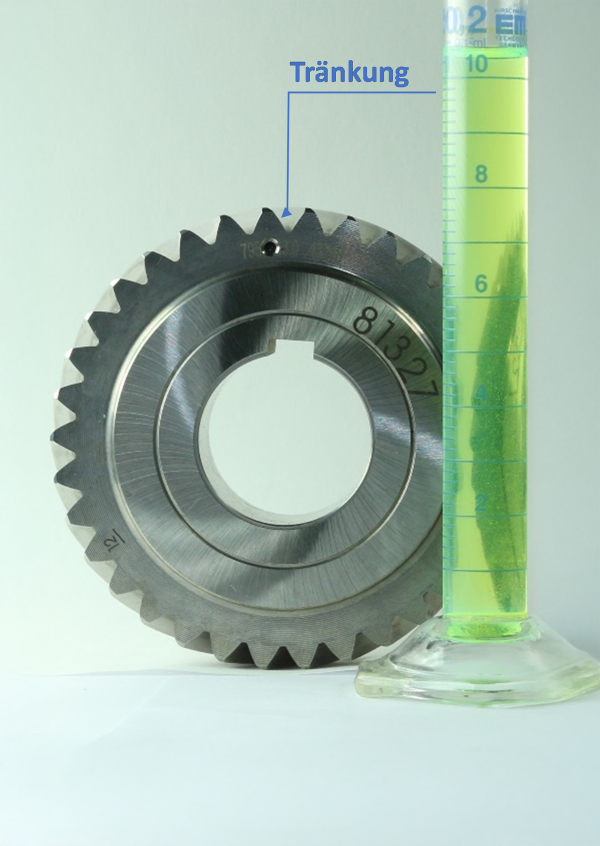
Resource-efficient machine elements: Researching bionically inspired self-lubrication
Funding duration:
Start
01.11.20
End
31.01.24
The lubrication of highly stressed machine elements is necessary to reduce friction and wear. Conventional lubrication methods, such as oil or grease lubrication, require suitable components for lubricant supply and conditioning and for sealing and lead to significant load-independent losses. An innovative approach is modelled on nature: similar to the human knee joint, where the pores in the meniscus serve as reservoirs and channels for synovial fluid, porous sintered metals can store lubricant and release it as required under load. This technology, inspired by nature, is already being used successfully in low-load components such as plain bearings. The advantages: Self-lubrication means that the required amount of lubricant is supplied directly to the functional point. This reduces the amount of lubricant used, reduces the size and weight of the gearbox, increases resource efficiency through lower load-independent power loss and thus improves the CO₂ balance. In the SinziA project, the researchers are investigating how this bionic approach can also be utilised for highly stressed machine elements using the example of gears in stationary and transient gearboxes.
The aim of the SinziA project is to develop oil-impregnated sintered gears that can be used as self-lubricating machine elements in applications subject to high mechanical loads. To this end, fundamental findings from material analyses and tribological investigations with material, lubricant and surface variants are being researched according to industrial application requirements in order to make the technology usable for broad industrial application.
The researchers are focussing in particular on the overall objective of significantly reducing the amount of lubricant required in the gearbox and reducing the installation space and complexity of the gearbox. By using suitable material-lubricant-surface configurations, they want to minimise power losses compared to conventionally lubricated gearboxes through the self-lubrication of the tooth contacts. They also want to significantly extend the service life compared to dry-running gearboxes.
In the long term, the team is aiming to establish the technology across all sectors - from the automotive and mechanical engineering industries to aviation and food technology. Thanks to the wide range of possible applications, the researchers hope that the technology will make an important contribution to conserving resources and reducing CO₂ emissions.
The project team combines experimental modelling and component investigations with high-resolution analytics in order to transfer the findings to potentially applicable self-lubricating system configurations in application tests and to examine their technological maturity. Firstly, they define the requirements of stationary and intermittently operated target applications. Based on this, they determine suitable sintered material and surface specifications as well as a suitable lubricant and identify industrially realisable impregnation processes in order to evenly fill the pore structure of the materials with sufficient lubricant.
The research partners then test the self-lubricating material and surface combinations in model tests under laboratory conditions. They analyse friction and lubrication as well as damage behaviour under defined conditions and determine the load limits of the self-lubricating technology. These findings are incorporated into the development of practical demonstrators, which are tested in module tests under real operating conditions. Finally, the researchers develop practical design guidelines in order to be able to design self-lubricating machine elements for further investigation and transfer to a wide range of applications.

Lightweight in steel construction: end-to-end digitalised production and testing chain
Funding duration:
Start
01.05.21
End
01.04.25
Offshore wind turbines stand on a huge support structure up to 60 metres high, the greater part of which remains hidden below the waterline. Today, a single steel pile, known as a monopile, is often used. Up to 2,000 tonnes of steel are welded together for this purpose - the production of which releases large quantities of CO₂.
The tonnage during transport and the amount of CO₂ released during steel production is significantly lower if more delicate support structures are used instead of the monopile. However, these lightweight structures, known as jacket foundations, pose a challenge in terms of production technology, meaning that potential CO₂ savings have not yet been realised on an industrial scale.
This is mainly due to the very complex weld seams: Today, the jacket foundations are usually welded together manually and later transported to their place of use using special ships. Tolerances in manual production and high safety requirements necessitate a conservative design, i.e. thick-walled components are used.
The aim of SmartWeld is to make the use of lightweight construction techniques possible with an end-to-end digitalised production and testing chain in the construction of foundations. To achieve this, the welding process for the complex seams on the supporting structures is to be adapted so that it can be better automated. If this is successful, the seams will also be more durable. The structures could also be manufactured with thinner walls. They would therefore use less steel and thus save CO₂.
With an average 12-megawatt system, around 20 percent of the weight and therefore 400 tonnes of steel could be saved compared to a monopile. This corresponds to around 800 tonnes of CO₂. By optimising the design of the weld seams and making savings in the energy-intensive welding process itself, the proportion of CO₂ in production could be reduced even further. For a wind farm with 100 turbines by a total of more than 100,000 tonnes.
In order to utilise the new production technologies in industry as quickly as possible, the researchers are working as practically as possible. The industrial partners in the research project are developing demonstration systems suitable for series production under real manufacturing conditions. In this way, the research results can be transferred like a "blueprint" to other areas of steel construction in which large-format structures such as bridge constructions are manufactured.
Several demonstrator nodes are already being produced as part of the project, which will then be subjected to various fatigue tests - accompanied by simulations of crack development and crack progression. Tests that have already been carried out to automate the welding processes have significantly increased the production speed.

Improving quality assurance in 3D printing: acoustic testing method for metal components
Funding duration:
Start
01.07.22
End
30.09.24
Metal 3D printing offers great potential for lightweight construction. Thanks to the great freedom of design, components can be bionically optimised and made significantly lighter than with conventional methods. This saves material, reduces energy consumption and enables more durable components. Despite these advantages, the industrial use of metal 3D printing is still limited. One key reason for this is the complex quality assurance process.
Previous testing methods such as computer tomography or dye penetrant testing are expensive, time-consuming and often not suitable for complex 3D-printed structures. The testing of high-performance materials that cannot be radiographed is particularly challenging. Without efficient quality assurance, the economic and sustainable use of additive manufacturing remains limited in many sectors, including aerospace, automotive and the energy industry.
In the SonicQuality project, researchers are developing a new acoustic testing method to improve the quality assurance of metal 3D printed components. By using two non-destructive methods - process-compensated resonance testing (PCRT) and vibrothermography (SIR) - the aim is to reliably detect defects. The aim is to achieve cost savings of at least 90 per cent and an 85 per cent reduction in testing time compared to conventional methods. The new method will also require no consumables or harmful substances. In this way, the project team hopes to open up new application possibilities for metal 3D printing and achieve significant CO₂ savings. Standardisation measures should make the method widely applicable at the end of the project.
The project team combines two acoustic methods to enable comprehensive and automatable quality control. The PCRT technology analyses the resonance behaviour of components and compares it with a defect-free standard. This allows structural deviations to be identified. In addition, SIR technology recognises cracks and defects on the component surface through frictional heat. The combination of both methods enables fast, reliable and fully digital defect analysis, regardless of the material or surface condition. This represents a major advance over previous methods. The initial focus is on components manufactured using the widely used selective laser melting (SLM) process. However, the method should also be transferable to other additive manufacturing processes.

Reducing the carbon footprint at the material level: Albasia wood for electric cars and lifts
Funding duration:
Start
01.09.21
End
31.08.24
Lightweight construction is crucial to making vehicles more sustainable: The components weigh less and material is saved. This improves resource efficiency and reduces greenhouse gas emissions - not only during production, but also when the lightweight components are later used. Companies are increasingly using hybrid materials that combine different functions and are therefore particularly efficient. However, these materials are usually difficult to recycle and often have a negative carbon footprint. One way to resolve this conflict is to use sustainable lightweight materials - such as wood - as part of hybrid materials.
The project team wants to replace conventional lightweight construction materials, such as aluminium or steel, with wood hybrids based on Albasia wood in order to reduce the carbon footprint of structures at the material level. Due to its low density in combination with excellent mechanical properties, Indonesian lightweight wood is very suitable for lightweight construction. Albasia is sustainably cultivated in Indonesia in order to reforest areas left fallow by slash-and-burn agriculture and to enable local smallholders to generate additional income from the utilisation of these areas and the sale of the wood. Its use in vehicle structures is particularly sustainable when the material is used together with domestic hardwoods and conifers as a wood-wood hybrid. As these woods are cheap and readily available, this also increases the competitiveness of the domestic industry and value creation in Germany.
The project team wants to demonstrate the wood hybrid materials in three applications: In crash-loaded vehicle structures of electric vehicles, for the box body of a small commercial vehicle and in lift construction as a panel product. The researchers also see great potential here for the integration of additional functions, as wood has very good acoustic and thermal insulation properties. This means that other CO₂-intensive materials that are currently used to integrate insulation or noise protection can be saved. In addition, the wooden components are lighter, so the CO₂ balance is also better in use.
Current research activities are aimed at further optimising the hybrid material system. For example, different variants for the wooden core are being investigated for the crash-loaded vehicle structure in order to save further weight and fulfil the requirements resulting from the integration of the component into the body. The production of moulded wood parts from Albasia veneer is currently being investigated for use in commercial vehicle bodies and lift construction. The aim here is to produce three-dimensionally moulded components from veneer material. As part of a life cycle analysis, the material is being analysed, taking into account all relevant process steps from planting the seedling to transporting the material and manufacturing the components.

Systematically implementing lightweight construction: with digital workflows
Funding duration:
Start
01.01.21
End
30.06.24
Lightweight construction is an important key to resource-saving, cost-efficient and sustainable products. Nevertheless, much of the potential remains untapped as there is a lack of systemic approaches to optimise costs, functionality and environmental performance in equal measure. Sectors such as mechanical engineering, the leisure industry and medical technology need solutions that apply lightweight construction not only at component level, but across entire systems. The researchers in the SyProLei project are addressing this gap with a comprehensive approach that integrates material, product and production perspectives.
The aim of the scientists is to develop a universal methodology that integrates lightweight construction into the entire product development process. Digital workflows are intended to make the developed methodology usable for various industries. The project team is focusing on systematically analysing conflicting objectives, i.e. weighing up and balancing competing requirements such as costs, material and energy efficiency and functionality, which can influence each other.
The results are intended to form a basis for future applications. In this way, the researchers hope to contribute not only to technological innovation, but also to the reduction of material consumption, energy requirements and CO₂ emissions in both the manufacturing and utilisation phases.
The project team first develops a methodology for the end-to-end development of lightweight products. The team then maps these in digital workflows. The researchers analyse existing processes in order to identify potential for conserving resources and saving materials. Building on this, the team develops innovative concepts and analyses them using multi-criteria evaluation methods.
The team tests the methodology using three practical use cases. They are developing concepts for reducing energy consumption and weight on a gantry robot. In a bicycle trailer, new materials and production methods improve safety and increase sustainability. Prostheses are made lighter, more functional and more sustainable through holistic optimisation by systematically coordinating all components and using new material and production approaches.

Sustainable injection moulding plastics: cost-effective production of lightweight components
Funding duration:
Start
01.12.21
End
31.12.24
Injection moulded plastic parts are an integral part of everyday life. They are used in electrical appliances, household items and transport containers. Every additional millimetre of material increases the amount of energy required for production, transport and recycling.
Manufacturers are therefore reducing wall thicknesses to save weight - but are coming up against physical limits. Thin cross-sections fail under load or deform too much, while expensive full composite laminates made of fibre-reinforced thermoplastics (FRP) increase costs and often also the CO₂ footprint in production. The industry is therefore looking for a solution that combines lightweight construction, resource efficiency and resilience.
The T3-Hub research project aims to close this gap. The project team wants to reduce the amount of material used in standard technical injection moulded parts and thus make them more sustainable - and this for series production. To achieve this, the researchers are reinforcing conventional components with wafer-thin thermoplastic tapes that are only a few tenths of a millimetre thick and 5-25 mm wide. The tapes contain glass, carbon or natural fibres in the same plastic matrix as the component. This means that the components, which are otherwise produced with material-intensive ribbing or high wall thicknesses, can be manufactured using less material. The material consumption translates directly into weight, CO₂ footprint and production costs.
The new technology can reduce material consumption and thus improve all three properties. As the same material is used in all components, the components are recyclable on the one hand, but the reinforcement with tapes also facilitates the use of recycled materials in the components themselves (design-for-recycling).
With this method, the scientists aim to reduce material requirements by up to 20 per cent and significantly reduce CO₂ emissions in all phases of life. At the same time, the unit costs remain competitive and the recycling process simple.
The researchers initially selected around 100 typical injection moulded components from industries such as transport, sport and leisure, household and logistics. They use digital simulations (finite element method) to identify the main load paths. They then determine the ideal, force-flow-compliant tape arrangement and produce corresponding prototypes.
In the laboratory, the project team tests the production influences and component properties and compares the CO₂ footprint with that of unreinforced original parts.
A modular system consisting of various tools and software solutions enables the efficient redesign of injection moulded components and makes the effects of warpage manageable. An injection moulding simulation with consideration of the influences on warpage, in combination with an algorithm for warpage compensation, ensures the derivation of optimal insert configurations.
The project partners are setting up all the manufacturing equipment required for the development and production of injection moulded components with minimally invasive local tape reinforcement. This includes the manufacture of cost-efficient tapes, the production of tape inserts, tools for sampling and the development of materials through to a full-scale injection moulding cell for component production. The project participants are using all the expertise and systems they have developed to transfer the results to other use cases.
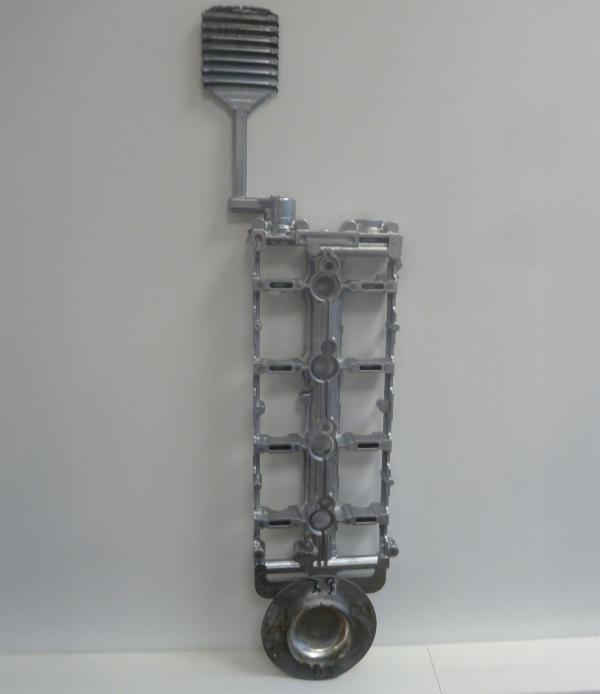
Die casting for aluminium components: Increasing strength and saving material
Funding duration:
Start
01.10.21
End
30.09.24
Aluminium components are often used in the automotive sector due to their weight. Thin-walled components reduce the use of resources, but require precise control of strength. The strength depends on the solidification time - the phase in which the liquid metal turns into solid material during casting. With thin walls, the aluminium cools quickly. This leads to a fine-grained microstructure, which improves the mechanical strength.
At the same time, the components must remain stable even at high operating temperatures. The strength is usually increased by a so-called T6 heat treatment. This involves heating and artificially ageing the cast parts after casting in order to improve their properties. However, this additional process consumes a lot of energy and causes high CO₂ emissions. Engineers are therefore working on alternative approaches that start directly in the casting process.
The TALoF research project aims to develop manufacturing processes for aluminium die-cast parts that offer higher strength at critical points. The researchers actively control the solidification time in order to produce a fine-grained microstructure - without resorting to T6 heat treatment. They use two types of alloy for this purpose: Al-Si-Cu alloys, in which the copper content ensures particularly high strength, and Al-Si-Mg alloys, which offer a good balance between strength and ductility (malleability) thanks to the magnesium content.
With this process, the project team aims to achieve material savings of over 7 per cent, in some cases significantly more, generally up to 30 per cent, and to reduce energy consumption during production and operation. The material parameters obtained are incorporated into digital simulations and enable more precise component calculations.
The researchers are realising the test setup on the camshaft bearing housing, an important component in commercial vehicles with a complex geometry. They develop a specially designed die-casting mould that limits the recycled metal content to a maximum of 30 per cent. They then cast components with precisely customised process parameters. The researchers analyse the microstructure using optical and electronic microscopy, measure the solidification times and carry out mechanical stress tests.
At the same time, they are optimising the mould in order to recover around half of the energy required to melt the aluminium, for example to heat industrial water or buildings. The data collected enhances existing simulation programmes. This provides designers with reliable material parameters.

Optimising tape laying: Sensory testing ensures the quality of fibre composite plastics
Funding duration:
Start
01.02.21
End
31.07.24
Tape laying is a production technology for the automated manufacture of fibre-reinforced plastics. Robots lay continuous fibre tapes directly onto a mould or tool surface. Layer by layer, fibre-reinforced plastic components are produced in almost final form.
Thermoplastic prepreg tapes are pre-impregnated and therefore enable even material distribution and high strength. However, they often show deviations in width, thickness and fibre volume content. These material deviations lead to gaps, overlaps and folds in the composite, which reduce the strength and rigidity by up to 27%.
Existing inspection systems only recognise defects after they have been deposited, which results in long inspection cycles and costly reworking. The resulting material waste and inefficient troubleshooting also have a negative impact on the carbon footprint of production.
In the TapeCheckSim research project, the team wants to actively rule out material-related defects before the tape laying process. The researchers measure the quality of the tapes directly on the reel and create a digital twin. This records precise surface roughness, geometric parameters and internal defects such as porosity, fibre breaks and fibre distribution.
A pre-build simulation model is used to predict how individual tape sections will behave in the component. The model uses artificial neural networks to calculate defect-related reduction factors and checks whether a defect leads to critical mechanical impairments. If the system recognises a critical influence, it automatically cuts out the affected section. In this way, the project team aims to avoid production downtimes, reduce rework and optimise the use of materials.
The researchers are integrating modern sensor technology into the production process. Optical cameras and laser sensors precisely measure the surface quality, width and thickness of the tapes. They are also developing eddy current sensors to determine fibre breaks and fibre distribution as well as to detect porosity, as thermoplastic tapes are more susceptible to internal defects. The recorded data flows into the digital web planning of the tape laying system. A simulative approach, supported by neural networks, links the quality data with the exact position in the component.
Before the laying process begins, the system simulates the mechanical behaviour and identifies critical sections. It then cuts these out in a targeted manner so that only qualitatively flawless tape sections are processed. This procedure ensures component quality and significantly shortens production times.

Strong, light, transparent: developing load-bearing panes made of fibre composite plastic
Funding duration:
Start
01.07.21
End
31.12.24
Fibre-reinforced plastics (FRP) are established in lightweight construction because they combine high strength with low weight. So far, however, they have hardly been used in applications where transparency is required - for example, in viewing windows or glazing with a load-bearing function. Classic plastic panes made of polycarbonate fulfil optical requirements, but are unable to absorb structural loads. Combinations of glass and plastic also reach their limits when subjected to mechanical stress. Yet there is a great need for lightweight, stable and transparent materials, particularly in vehicle and aircraft construction. This is where the transComp project comes in.
The researchers are investigating how fibre-reinforced plastics can be designed in such a way that they are not only strong and light, but also transparent. The team aims to combine two previously separate material properties in one material.
The aim of the project team is to develop transparent plastic discs that are mechanically resilient enough to take on structural tasks. Such components could be used in safety vehicles, for example, where glazing needs to offer protection and weigh as little as possible at the same time. The team is investigating various material combinations and production techniques in order to further develop both thermoplastic and thermoset solutions.
Using demonstrators - such as a visor with integrated heating - the researchers want to show that the combination of light transmission, impact resistance and mouldability is technically feasible. In addition to material development, they are also focussing on the CO₂ balance and recyclability of the plastics used in order to be able to assess the environmental impact of the new materials at an early stage.
The project team is initially developing suitable material systems in which the polymer matrix and reinforcing fibres have a similar refractive index - i.e. refract light in a comparable way. This is the only way to avoid optical distortions and enable a clear view.
At the same time, the researchers are adapting manufacturing processes such as resin transfer moulding - in which liquid resin is injected into a mould with inserted fibres and hardens there - hot pressing and thermoforming so that the new materials can be processed in flat or three-dimensional form. They are investigating both monolithic and multi-layer laminate structures, for example with layers of FRP, polycarbonate or glass. The team is focusing on the production of preforms using tailored fibre placement, which allows fibres to be placed in a load path-appropriate and material-efficient manner.
The scientists test the manufactured components with regard to optical and mechanical properties, for example by measuring dioptres and bullet impact tests. Finally, they evaluate the process from an ecological and economic perspective in order to identify potential for CO₂ savings and industrial implementation.

ultra-high-strength steel: optimising tailor-welded blanks with digital processes
Funding duration:
Start
01.08.21
End
31.07.24
Tailor-welded blanks (TWB) are customised sheets that join steels of different strengths by laser welding. This allows the properties of the components to be precisely tailored to the intended applications. They offer great potential for lightweight construction in the vehicle and transport industry. By saving weight, they help to reduce CO₂ emissions and increase material efficiency. Despite these advantages, their potential applications have so far been limited. Difficulties such as limited formability and the springback of weld seams make it difficult to use ultra-high-strength steels with strengths of over 800 megapascals (MPa). This is where the TWBlock team comes in. The researchers are developing innovative solutions to enable the use of even higher-performance materials. With digital solutions such as a digital twin and blockchain applications, they want to optimise the entire process chain and make it more sustainable.
The project team is working on bringing TWBs made from ultra-high-strength steels with strengths of up to 1,000 MPa into series production. The aim is to better link the welding and forming processes and to precisely model the properties of the materials using simulation. With the help of a digital twin, they are trying to understand and optimise the complex interactions between material, weld seam and forming process. The team is also integrating blockchain technologies to make the data transparent and traceable along the entire production chain. Through these approaches, the researchers hope to help reduce CO₂ emissions and advance lightweight steel construction in the automotive industry. At the same time, the team wants to improve the efficiency of production and promote collaboration between those involved.
The researchers begin by comprehensively analysing materials and weld seams. They carry out tests to determine the mechanical properties of high-strength steels and their behaviour during welding and forming. These results are incorporated into the development of a digital twin that simulates the complex processes. The team uses it to improve the welding and forming processes in a targeted manner and to better utilise the lightweight construction potential of the TWBs. Blockchain technologies ensure the integrity of the data and facilitate collaboration between the project partners. Finally, the team will test the results on a demonstrator, a vehicle side member, under real industrial conditions in order to create the basis for transferring TWBs made from ultra-high-strength steels to series production.

Making e-transporters lighter: Innovative body with modular battery tray system
Funding duration:
Start
01.12.21
End
30.11.24
Small delivery vehicles with a gross vehicle weight of up to 3.5 tonnes are used across all industries for the transport of goods and materials. Until now, vans in this class have mainly been powered by combustion engines. In order to successfully decarbonise the transport sector, more and more battery-powered vans are needed.
However, if the vans are equipped with an electric drive, the high battery weight increases the unladen weight. As a result, the possible payload of the vehicles decreases. Innovative lightweight construction approaches can be used to reduce the weight of battery-powered delivery vehicles, increase the possible payload and range and reduce costs.
In the Ulas E-Van project, researchers from industry and research are working on solutions to significantly reduce the weight of battery-powered vans through lightweight construction and thus increase their range. They are also aiming to reduce the battery size, secondary weight and therefore battery costs while maintaining the same range. To this end, the consortium is developing a new type of body structure and a modular and scalable battery carrier system for small electric commercial vehicles.
The researchers are focussing in particular on modern CAE (Computer Aided Engineering) methods, i.e. computer-aided development and production approaches. For the superstructure, the aim is to transfer the proven frame-stringer design used in aircraft construction to commercial vehicle construction with higher production figures. The researchers are using simulation-driven component development (simulation-driven design) for this purpose. The frames are to be designed in one piece and bionically optimised with the help of simulations.
For the outer skin, prefabricated large-area, structural plastic parts that are connected to the load-bearing structure will be developed. To this end, the project team is utilising 3D printing processes for the production of large structural components and larger quantities. In the underbody, the researchers are integrating a load-bearing, ultra-light, scalable and modular battery carrier system that supports the body structure in terms of rigidity, fatigue strength and crash safety.
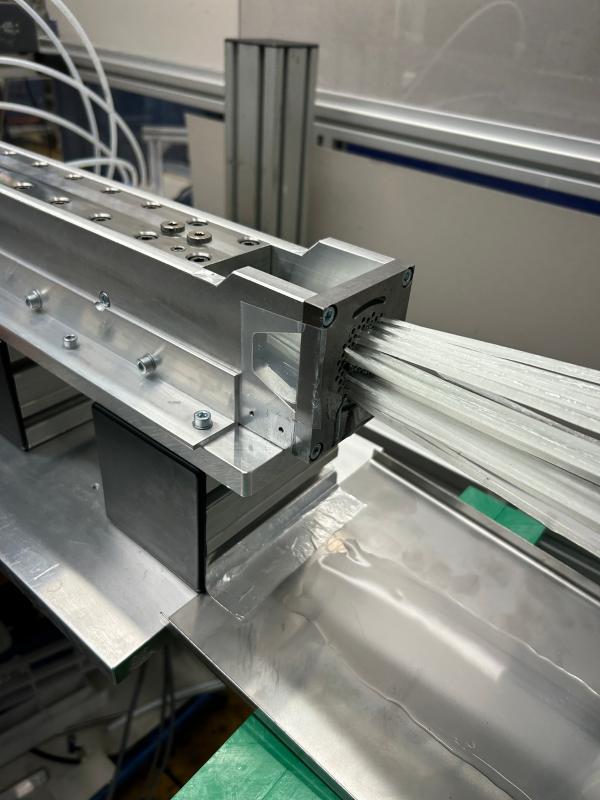
Producing postformable profiles: innovative UV pultrusion for fibre-reinforced plastics
Funding duration:
Start
01.09.21
Today
26.06.25
End
31.08.25
The increasing demands for efficiency and sustainability in vehicle construction require innovative solutions. Lightweight construction approaches play a key role in reducing CO2 emissions and minimising the weight of vehicles. Thanks to their adaptability and strength, lightweight fibre-reinforced plastics (FRP) offer great potential to replace conventional materials such as steel. A proven manufacturing process for FRP profiles is pultrusion, in which the materials are continuously drawn through a mould and cured there. However, existing pultrusion processes are limited to producing profiles with a constant cross-section, which limits their use for more complex applications. In order to expand the flexibility and range of applications of this technology, the team in the UVPult project is developing a new process to produce post-mouldable pultrusion profiles that offer ecological benefits as well as being highly cost-effective.
The aim of the researchers is to develop an innovative pultrusion technology that enables the subsequent moulding of FRP profiles for the first time. The team uses glass fibre reinforced plastics (GRP) and processes them with UV-curing resins to enable precisely controllable curing. The result is GRP profiles that are characterised by lightness, stability and cost efficiency and can be used in series production - for example as coupling rods in vehicles. With this technology, the scientists not only want to reduce the weight and thus the energy consumption during vehicle use, but also significantly reduce the energy requirements in production.
First of all, the researchers are developing new UV-curing resins and innovative LED UV lamps that enable zone-by-zone and switchable curing. They are designing the pultrusion process in such a way that certain areas of the profile remain partially cured for the time being. These sections can then be reshaped and finally cured, allowing complex geometries to be realised.
At the same time, the scientists are developing tools and procedures to automate these processes and integrate them into existing production lines. Finally, they test the technology on demonstrators such as the planned coupling rods and comprehensively validate their mechanical and functional properties.
Due to its innovative potential, UVPult has been recognised as a finalist in the prestigious JEC Innovation Awards 2025 in the automotive and transport sector.
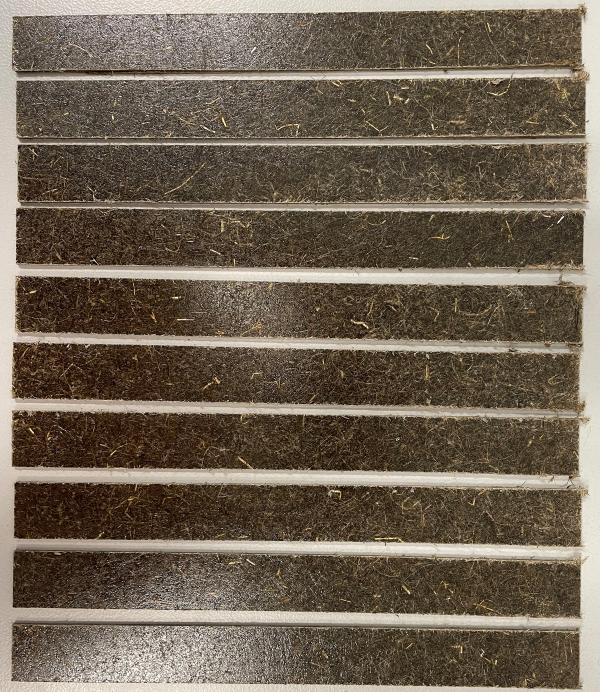
Recycling carbon fibres: Hybrid nonwovens for industrial lightweight construction
Funding duration:
Start
01.11.20
End
31.10.23
In the traditional production of technical textiles, a lot of waste is generated from cutting remnants. At the same time, the demands on the industry to develop sustainable and resource-saving alternatives are increasing. Conventional reinforcing materials such as continuous fibre textiles are reaching their limits here.
Hybrid fibre nonwovens, which combine recycled materials and thermoplastic components, offer a solution. They not only enable the reuse of waste, but also reduce the environmental impact. The VliesComp project is researching how these materials can be processed into lightweight components for machine tool construction, e-machines or medical technology.
The aim of the project team is to integrate recycled fibres from production waste into high-performance materials for lightweight construction and thus make the recycled fibres ecologically and economically usable. The focus is on the development of hybrid nonwovens consisting of thermoplastic and recycled reinforcing fibres.
These materials should not only conserve resources, but also be cost-efficient and versatile. The researchers are not aiming to achieve the maximum possible mechanical strength, but to develop customised materials for specific industrial applications.
The project team first defines the requirements for materials and processes. The researchers then develop new technologies for hybrid nonwovens by combining recycled reinforcing fibres with thermoplastic components. This results in materials that have application potential in numerous fields. With the help of modern process control and digital twins, the team optimises the production steps and tests the materials in real components.
The first applications have already been successful: the researchers can manufacture components such as damping elements or housing covers entirely from recycled fibres. In doing so, they are significantly improving the carbon footprint of the components - by up to 70 per cent in some manufacturing processes. And this while maintaining the same technical performance.

Sustainable construction: Carbon concrete walls with integrated electrical engineering
Funding duration:
Start
01.10.21
End
31.07.24
Electrical installations in buildings are often inefficient and consume large amounts of material. In office and commercial buildings in particular, complex cabling leads to high costs and unnecessary consumption of resources. At the same time, there is growing pressure to build more sustainably in order to reduce CO₂ emissions and conserve raw materials.
One promising approach is carbon concrete - an innovative material that enables thinner and lighter wall elements. However, conventional electrical installations are unsuitable for this construction method: Laying cables in empty conduits or installation shafts is almost impossible to realise in slim components. This is where the WallConnEct research project comes in, developing a more efficient and sustainable solution for the automated production of carbon concrete walls with integrated electrical installations.
The project team wants to develop an innovative wall construction in which the electrical infrastructure is already integrated into prefabricated carbon concrete elements ex works. In this way, the researchers want to reduce the amount of material used for cabling by up to 90 per cent and significantly shorten the construction time. The basis is the industrial communication standard AS-Interface (ASi-5), which enables data and energy transmission via a single cable.
The researchers are developing fully automated modular production processes for precast concrete elements in order to integrate an intelligent and resource-minimised electrical installation directly into the wall elements. In the future, industrial robots and other automated systems will insert all installation parts and system components into the walls fully automatically - a process that has so far been manual and inefficient.
Another focus is the digital pre-planning of the wall elements. Cable routes, built-in parts and reinforcements are to be precisely defined during the planning stage. The researchers are also driving forward the adaptation of existing installation and cabling standards.
The new technologies make it possible to save on materials, reduce energy consumption and make construction processes more efficient overall. The result is a construction method that conserves resources, is economical and also reduces CO₂ emissions.
The project team is initially investigating how AS-Interface technology can be integrated directly into thin-walled wall elements. To this end, the researchers are developing new installation components that are optimised for the thin wall thickness and the special requirements of carbon concrete. In laboratory trials, they are testing how cables and sensors can be automatically inserted into the formwork without compromising the stability of the component.
At the same time, they are developing robot-assisted production systems that enable fully automated integration of the electrical installation in the production process. The researchers are optimising these systems step by step to ensure the precise placement and safe embedding of the electrical components. They then test the developed processes on exemplary components before producing prototypes and carrying out extensive practical tests.
The result is an industrially applicable solution that precast concrete plants can use to integrate electrical installations directly into carbon concrete components in a resource-saving and efficient manner.
